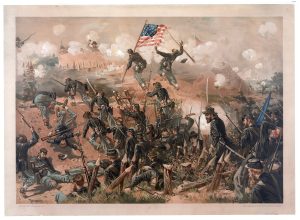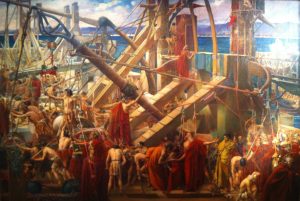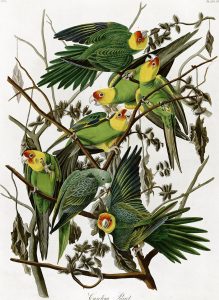Cleopatra VII and Julius Caesar/Mark Antony, Heloise and Peter Abelard, Anne Boleyn and Henry VIII, Josephine and Napoleon Bonaparte, Simone de Beauvoir and Jean-Paul Sartre, Queen Victoria and Prince Albert, Frida Kahlo and Diego Rivera, Isabella I of Castile and Ferdinand II of Aragon, Eva Perón and Juan Perón, Elizabeth Barrett Browning and Robert Browning, Yang Guifei and Emperor Xuanzong, Mumtaz Mahal and Shah Jahan, Gertrude Stein and Alice B. Toklas, Yoko Ono and John Lennon, and Wallis Simpson and Edward VIII: 15 Famous Lovers
Cleopatra VII and Julius Caesar/Mark Antony (Egypt/Rome):
Cleopatra, the last Pharaoh of Egypt, had influential relationships with Julius Caesar and Mark Antony. These unions were romantic and politically strategic, impacting the fate of the Roman Republic and Egypt.
Heloise and Peter Abelard (France):
Scholar Heloise had a famous love affair with her tutor, philosopher Peter Abelard, in 12th-century France. Their love led to a secret marriage, tragic separation, and intellectual correspondence that has survived through the ages.
Anne Boleyn and Henry VIII (England):
Anne Boleyn’s relationship with Henry VIII of England was central to the English Reformation. Henry’s desire to marry her led to England’s break from the Catholic Church and the establishment of the Church of England.
Josephine and Napoleon Bonaparte (France):
Josephine was Napoleon’s first wife and great love. Their relationship influenced Napoleon’s personal life and ambitions, though they divorced due to her inability to bear an heir.
Simone de Beauvoir and Jean-Paul Sartre (France):
Philosopher Simone de Beauvoir and existentialist thinker Jean-Paul Sartre were partners in love and intellectual life. Their open relationship defied conventions and shaped modern existentialism and feminist thought.
Queen Victoria and Prince Albert (United Kingdom):
Queen Victoria’s deep love for her husband, Prince Albert, profoundly impacted her reign. Together, they promoted the arts, science, and the expansion of the British Empire.
Frida Kahlo and Diego Rivera (Mexico):
The tumultuous marriage between these famous Mexican artists, Frida Kahlo and Diego Rivera, was marked by mutual artistic inspiration, infidelity, and passion. Their love influenced their artistic legacies.
Isabella I of Castile and Ferdinand II of Aragon (Spain):
Their marriage unified Spain, leading to the completion of the Reconquista, the establishment of Spain as a global empire, and the funding of Christopher Columbus’s expedition to the Americas.
Eva Perón and Juan Perón (Argentina):
Eva Perón, or Evita, was the influential wife of Argentine President Juan Perón. Her advocacy for labor rights, women’s suffrage, and the poor made her a beloved figure in Argentina.
Elizabeth Barrett Browning and Robert Browning (United Kingdom):
This literary couple is remembered for their deep love, which fueled some of the most beautiful poetry in the English language. Their letters and poems remain famous to this day.
Yang Guifei and Emperor Xuanzong (China):
Emperor Xuanzong of Tang and his beloved consort, Yang Guifei, shared a passionate and legendary romance that became one of Chinese history’s most famous love stories. Their relationship, however, was blamed for the emperor’s neglect of his duties, contributing to the downfall of the Tang Dynasty during the An Lushan Rebellion. Tragically, Yang was executed to appease the imperial army.
Mumtaz Mahal and Shah Jahan (India):
Mumtaz Mahal, the beloved wife of Mughal Emperor Shah Jahan, inspired the creation of the Taj Mahal, one of the world’s greatest monuments to love. Her death during childbirth left Shah Jahan heartbroken.
Gertrude Stein and Alice B. Toklas (United States/France):
Gertrude Stein, a renowned modernist writer, shared a lifelong partnership with Alice B. Toklas. Toklas was Stein’s muse, companion, and editor, supporting her literary career and legacy.
Yoko Ono and John Lennon (Japan/England):
Yoko Ono, a Japanese avant-garde artist, and John Lennon, a British musician from The Beatles, formed a unique and influential partnership that blended art, music, and activism. Their marriage in 1969 marked the beginning of a highly publicized collaboration, most famously known for their peace activism and iconic projects like “Imagine” and the Bed-In for Peace protests.
Wallis Simpson and Edward VIII (America/England):
Wallis Simpson and Edward VIII’s relationship caused a constitutional crisis in the United Kingdom, as Edward chose to abdicate the throne in 1936 to marry the twice-divorced American socialite. Their marriage marked one of the most controversial royal romances in modern history, and they lived the rest of their lives in exile.
Cleopatra VII and Julius Caesar/Mark Antony Lovers (Egypt/Rome)
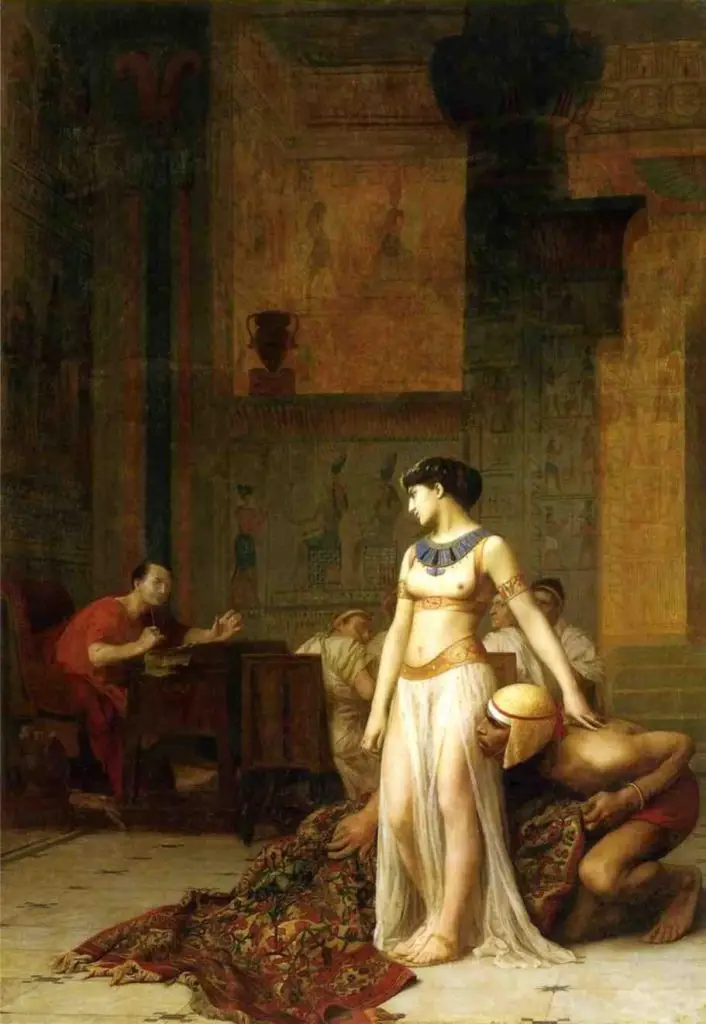
Cleopatra and Caesar (1866), a painting by Jean-Léon Gérôme (Wiki Image).
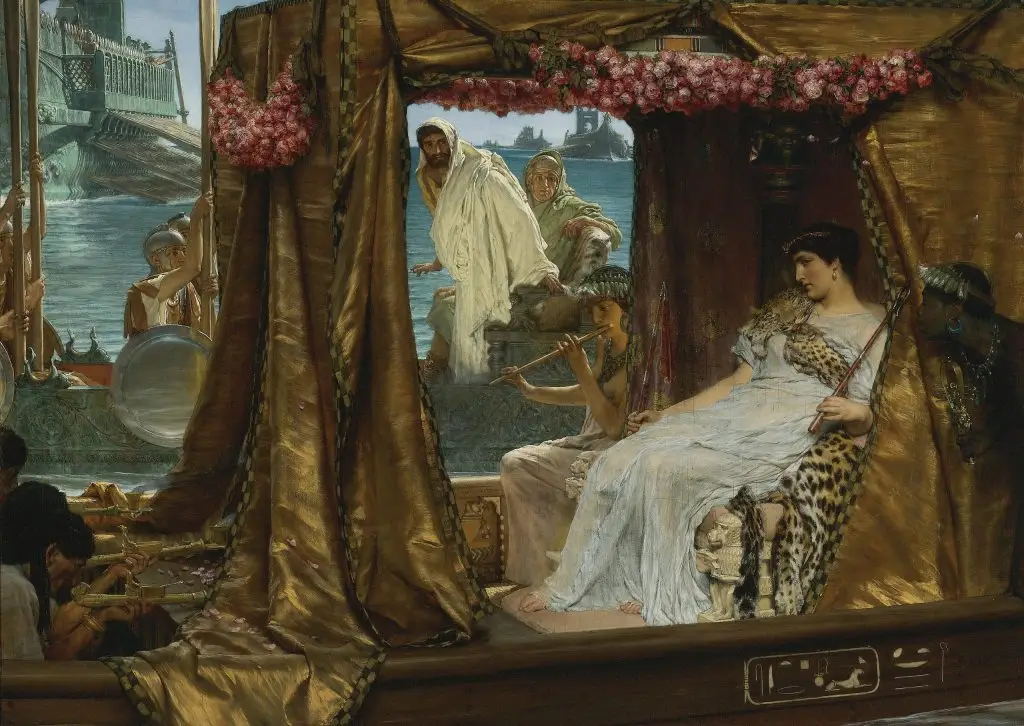
The Meeting of Antony and Cleopatra (1885), by Lawrence Alma-Tadema (Wiki image).
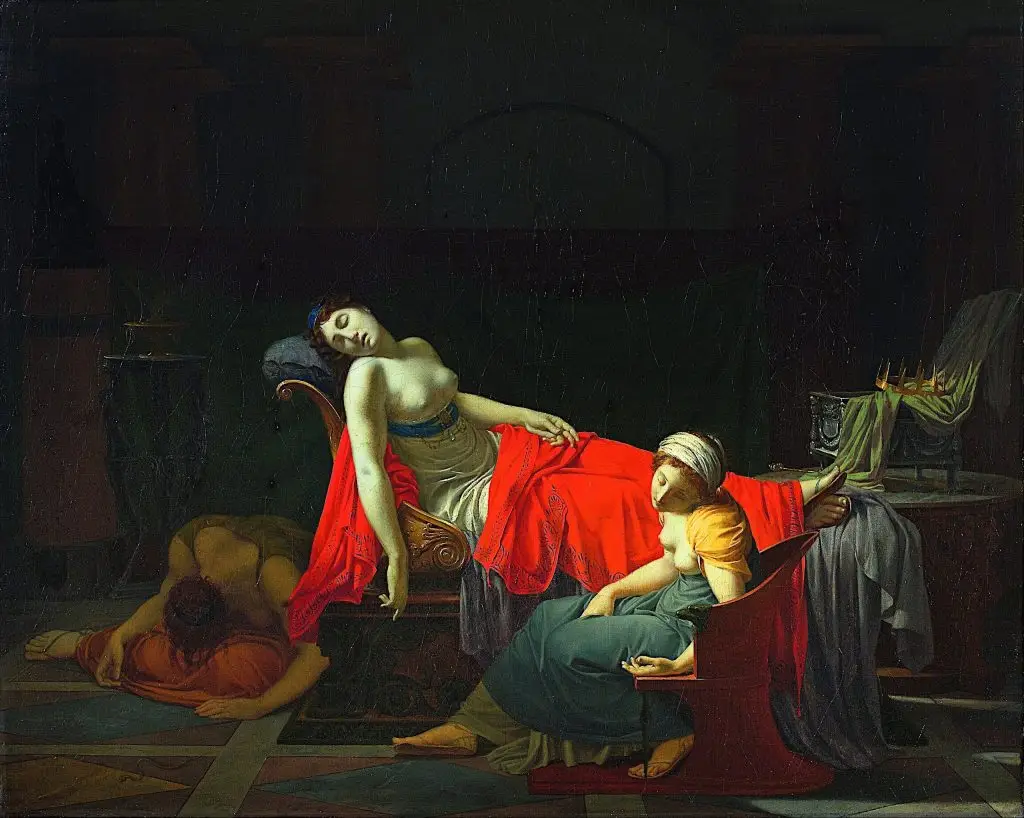
The Death of Cleopatra (1658), by Guido Cagnacci (Wiki Image).
Cleopatra and Julius Caesar:
- Plutarch on Caesar’s relationship with Cleopatra:
“Caesar was captivated by her charm, and though she was past her prime, he immediately began an affair with her.”
– Plutarch, Life of Caesar - Cleopatra’s seduction of Caesar:
“She came to see Caesar at Alexandria in a boat and brought with her countless gifts and treasures to win his favor.”
– Cassius Dio, Roman History - Cleopatra on her alliance with Caesar:
“I sought a great leader’s protection to keep Egypt strong and the crown secure.” - Shakespeare on Cleopatra’s impact on Caesar:
“Age cannot wither her, nor custom stale / Her infinite variety.”
– William Shakespeare, Antony and Cleopatra - Historian Adrian Goldsworthy on Cleopatra’s political role with Caesar:
“For Cleopatra, Caesar’s presence in Egypt presented an opportunity to regain her throne and stabilize her kingdom.”
– Adrian Goldsworthy, Caesar: Life of a Colossus
Cleopatra and Mark Antony:
- Plutarch on Antony’s love for Cleopatra:
“He was so utterly captivated by her that he decided to spend the winter with her at Alexandria.”
– Plutarch, Life of Antony - Cleopatra on her bond with Antony:
“It was not Caesar, but Antony, who ruled my heart. He gave me a kingdom of love.” - Shakespeare on Cleopatra and Antony’s passion:
“If it be love indeed, tell me how much.”
– William Shakespeare, Antony and Cleopatra - Plutarch on Cleopatra’s power over Antony:
“Cleopatra had such a hold on Antony that he was often content to neglect serious matters of state to spend time with her.” - Antony’s devotion to Cleopatra:
“Let Rome in Tiber melt, and the wide arch / Of the ranged empire fall! Here is my space.”
– William Shakespeare, Antony and Cleopatra
| Year | Age (Cleopatra) | Event | Significance |
|---|---|---|---|
| 48 BC | 21 | Meets Julius Caesar in Alexandria | Cleopatra seeks Caesar’s support in a power struggle with her brother/co-ruler Ptolemy XIII. |
| 47 BC | 22 | Gives birth to Ptolemy Caesarion | Claims Caesarion is Caesar’s son; solidifies her alliance with him. |
| 46 BC | 23 | Travels to Rome with Caesarion | Lives with Caesar in Rome, further strengthening their relationship and her influence. |
| 44 BC | 25 | Caesar is assassinated | Cleopatra returns to Egypt, facing an uncertain future. |
| 41 BC | 28 | Meets Mark Antony in Tarsus | Cleopatra seeks Antony’s support to secure her position and expand her kingdom. |
| 41-40 BC | 28-29 | Spends the winter with Antony in Alexandria | Their romantic and political alliance begins. |
| 37 BC | 30 | Gives birth to twins, Alexander Helios and Cleopatra Selene II | Further strengthens her bond with Antony. |
| 36 BC | 31 | Antony formally marries Cleopatra (though already married to Octavia) | Their relationship becomes more open and politically significant. |
| 34 BC | 33 | “Donations of Alexandria” | Antony declares Caesarion Caesar’s legitimate heir and grants territories to their children, angering Octavian. |
| 32 BC | 35 | War breaks out between Antony and Octavian | Cleopatra supports Antony with troops and resources. |
| 30 BC | 36 | Antony and Cleopatra are defeated at the Battle of Actium | They flee back to Egypt. |
| 30 BC | 36 | Antony and Cleopatra commit suicide | Ends their reign and marks the beginning of Roman rule in Egypt. |
Cleopatra: The Story of the Queen of Egypt (Complete) – Great …
CLEOPATRA: The Story of the Queen of Egypt (FULL …
The Secrets Behind Cleopatra’s Rise to Power
(YouTube video)
Cleopatra VII and Julius Caesar/Mark Antony: The Lovers Who Shaped the Fate of Egypt and Rome
Cleopatra VII, the last active ruler of the Ptolemaic Kingdom of Egypt, is remembered for her intelligence, political acumen, and romantic liaisons with two of Rome’s most powerful men: Julius Caesar and Mark Antony. Cleopatra’s relationships with Caesar and Antony were driven by passion and political necessity, as Egypt’s survival depended on its alliances with Rome. These relationships ultimately shaped the course of Roman and Egyptian history, culminating in a love story intertwined with power, ambition, and tragedy.
Cleopatra first met Julius Caesar in 48 BC when he arrived in Egypt during internal strife. Cleopatra, embroiled in a conflict with her brother Ptolemy XIII over the throne, saw in Caesar a powerful ally who could help her regain control of Egypt. According to legend, Cleopatra had herself smuggled into Caesar’s presence, wrapped in a carpet, to appeal to him for support. Impressed by her charm, wit, and political astuteness, Caesar soon became her lover and ally. Together, they defeated Ptolemy XIII, and Cleopatra was restored to the throne, ruling alongside her younger brother Ptolemy XIV.
In 47 BC, Cleopatra gave birth to a son, Ptolemy XV, better known as Caesarion, meaning “little Caesar.” Though Caesar never publicly acknowledged Caesarion as his son, it was widely believed that the child was his. Cleopatra’s relationship with Caesar allowed her to secure her position in Egypt and maintain its independence from Rome. However, her time with Caesar was short-lived, as he was assassinated in 44 BC by Roman senators who feared his growing power. Though saddened by Caesar’s death, Cleopatra remained in Egypt and focused on her rule.
After Caesar’s assassination, Rome was thrown into turmoil, with various factions vying for control. One of these factions was led by Mark Antony, a loyal ally of Caesar and a member of the Second Triumvirate, the political alliance formed to stabilize Rome. In 41 BC, Antony summoned Cleopatra to Tarsus, seeking her support in the ongoing power struggle. Cleopatra agreed to meet him, understanding the importance of securing Rome’s favor. Their encounter began one of history’s most famous love stories.
Unlike her relationship with Caesar, Cleopatra’s affair with Antony was marked by genuine affection and mutual respect. Antony was captivated by Cleopatra’s intelligence, charisma, and beauty, while Cleopatra saw in Antony both a powerful protector and a man she could influence. The two quickly became inseparable, and Antony spent the winter of 41–40 BC in Alexandria, enjoying the luxuries of Cleopatra’s court. In 40 BC, Cleopatra gave birth to twins Alexander Helios and Cleopatra Selene, further cementing their bond.
As their relationship deepened, Antony’s involvement with Cleopatra began to strain his ties with Rome. Many Romans, including his political rival Octavian (the future Emperor Augustus), viewed Antony’s alliance with Cleopatra as a betrayal of Rome’s interests. Antony’s decision to divorce his Roman wife, Octavia (Octavian’s sister), in favor of Cleopatra only intensified the tensions between the two men. By 32 BC, these tensions had escalated into open conflict, with Octavian declaring war on Cleopatra and Antony.
The final confrontation between Octavian and the lovers came in 31 BC at the Battle of Actium, a naval battle off the coast of Greece. Octavian’s fleet decisively defeated Antony and Cleopatra’s combined forces. Following their defeat, Antony and Cleopatra retreated to Egypt, facing the grim reality of their impending downfall. In 30 BC, with Octavian’s forces closing in on Alexandria, Antony committed suicide, believing Cleopatra had already taken her own life. Upon hearing of Antony’s death, Cleopatra, devastated and unwilling to be paraded as a captive in Octavian’s triumph, also took her own life, reportedly by allowing a venomous asp to bite her.
The deaths of Antony and Cleopatra marked the end of the Ptolemaic dynasty and the beginning of Roman rule in Egypt. Octavian, now the undisputed ruler of Rome, annexed Egypt as a Roman province, and Cleopatra’s son Caesarion was executed, extinguishing the last hope of Ptolemaic sovereignty. The tragic end of Antony and Cleopatra’s love affair symbolized the demise of Egyptian independence and the Roman Republic, as Octavian would become Rome’s first emperor, Augustus.
Despite their tragic fate, Cleopatra and Antony’s love story has endured for centuries, immortalized in literature, art, and popular culture. Their relationship is often romanticized as the ultimate tale of love and power, where personal desire and political ambition intertwine. Cleopatra, in particular, remains a figure of fascination, admired for her ability to wield power in a male-dominated world and for her role as a symbol of Egypt’s last great struggle for independence.
Ultimately, Cleopatra and Antony’s love affair was not just a personal relationship but a political alliance that influenced the fate of two great civilizations. Their lives, loves, and tragic deaths marked the end of an era. Still, their legacy continues to captivate imaginations today, reminding us of the ancient world’s power, loyalty, and love complexities.
Heloise and Peter Abelard Lovers (France)
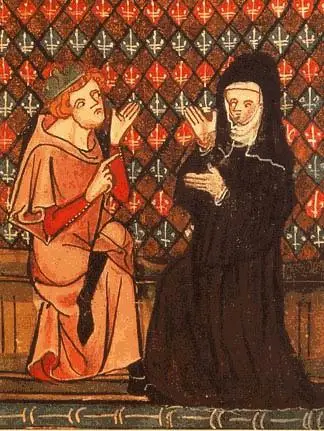
Abelard and Héloïse in a manuscript of the Roman de la Rose (14th century) (Wiki Image).
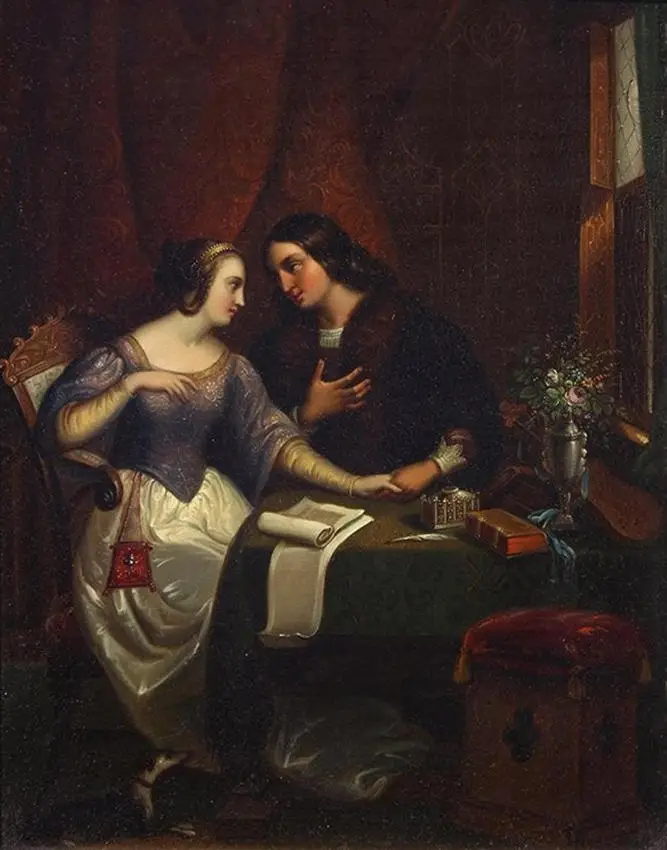
Jean-Baptiste Goyet, Héloïse et Abailard, oil on copper, c. 1829 (Wiki Image).
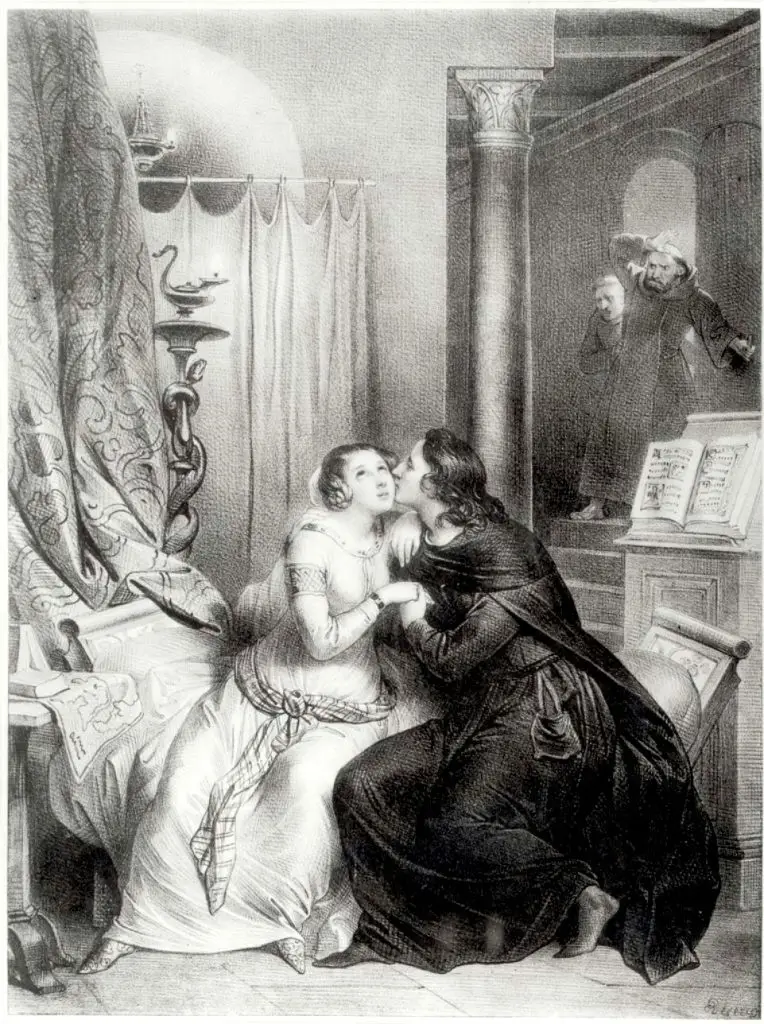
Heloise and Abelard, Achille Devaria, 19th c. engraving (Wiki Image).
You’re seeking to delve into the passionate and tragic love story of Heloise and Peter Abelard through their own words. Here are ten quotes that offer a glimpse into their profound connection, the challenges they faced, and the enduring legacy of their love:
Heloise:
- “God knows I never sought anything in you except yourself; I wanted simply you, nothing of yours.” – This reveals the pure and selfless nature of Heloise’s love for Abelard, transcending worldly concerns.
- “When we fell, we fell together, but I was the more crushed.” – This poignantly expresses the unequal consequences of their forbidden love, with Heloise bearing the brunt of societal condemnation.
- “We who were joined by the strongest ties of love are now separated by the vastest distance.” – Despite the physical separation imposed by their circumstances, their emotional bond remained powerful.
- “You are my only thought. In you I live; in you, I die.” – Heloise’s words convey the all-consuming nature of her love for Abelard, even in the face of adversity.
- “O vows! O convent! I have not lost my humanity beneath your veil, but my lover.” – This quote expresses Heloise’s internal conflict between her religious vows and her enduring love for Abelard.
Abelard:
- “I can forget everything but you. You are my only thought.” – Abelard’s words mirror Heloise’s, emphasizing the reciprocal nature of their deep connection.
- “Love is a grave mental disease.” – This seemingly harsh statement reflects the turmoil and suffering their love brought upon them due to societal constraints.
- “It is by the agency of letters that absent friends are present, that the dead live.” – This quote highlights the importance of their written correspondence in maintaining their connection despite separation.
- “The pleasures of love are always followed by bitterness.” – Abelard acknowledges the bittersweet nature of their love, marked by both ecstasy and anguish.
- “Heaven is my witness that it was your command, not any love for the monastic life, that dragged me to the altar.” – This reveals Abelard’s sacrifice for Heloise, highlighting the depth of his love and willingness to prioritize her well-being.
| Year (approx.) | Age (Heloise) | Age (Abelard) | Event | Significance |
|---|---|---|---|---|
| 1115 | ~14 | ~36 | Abelard and Heloise meet in Paris | Abelard, a renowned philosopher and theologian, becomes Heloise’s tutor. Their intellectual connection quickly turns into a passionate love affair. |
| 1116 | ~15 | ~37 | Heloise becomes pregnant | Abelard sends Heloise to his sister’s home in Brittany to conceal the pregnancy. |
| 1117 | ~16 | ~38 | Heloise gives birth to their son, Astrolabe | |
| 1117 | ~16 | ~38 | Abelard and Heloise marry in secret | They attempt to appease Heloise’s uncle, Fulbert, but Heloise resists the public acknowledgment of the marriage to protect Abelard’s career. |
| 1118 | ~17 | ~39 | Heloise enters the convent at Argenteuil | Abelard sends Heloise to the convent, ostensibly for her safety, but also to further conceal their marriage. |
| 1118 | ~17 | ~39 | Abelard is attacked and castrated | Fulbert, enraged by the perceived betrayal, arranges for Abelard to be brutally attacked. |
| 1119 | ~18 | ~40 | Abelard becomes a monk at St. Denis | Devastated and disgraced, Abelard retreats to monastic life. |
| 1121 | ~20 | ~42 | Heloise becomes a nun | At Abelard’s insistence, Heloise takes vows and becomes the abbess of the Paraclete convent. |
| 1130s | 30s | 50s | Exchange of letters | Their famous correspondence begins, revealing their enduring love, intellectual connection, and struggles with their religious commitments. |
| 1142 | ~41 | ~63 | Abelard dies | |
| 1164 | ~63 | – | Heloise dies | |
| 12th Century | – | – | Their remains are reunited | Initially buried separately, their remains are eventually moved and reburied together, symbolizing their enduring love story. |
Heloise and Abelard Love Story | LittleArtTalks
Famous Love Stories: The Letters of Abelard and Heloise
Abelard and Heloise: Medieval Romance and Philosophy
(YouTube video)
Heloise and Peter Abelard: A Tragic Love Story of Passion and Intellect (France)
Heloise and Peter Abelard’s love story is one of medieval history’s most famous and tragic. It is a tale of deep intellectual connection, forbidden love, scandal, and enduring devotion. In the early 12th century, Heloise, a brilliant and educated young woman, met Peter Abelard, a renowned philosopher and teacher in Paris. Their relationship began as one of teacher and student but soon developed into a passionate and intense love affair that would ultimately lead to great joy and devastating heartbreak.
Peter Abelard was one of the most celebrated philosophers and theologians of his time. Known for his sharp intellect and controversial ideas, he was already a prominent figure in Paris when he met Heloise. She was the niece of Fulbert, a canon of Notre Dame, and her reputation as a learned and articulate woman preceded her. Abelard, intrigued by Heloise’s intellect, arranged to become her tutor under the pretext of providing her with further education, but his true intentions were more personal.
Heloise and Abelard’s relationship quickly turned from academic mentorship to romantic involvement. Their affair was passionate and intense, and despite their efforts to keep it secret, it soon became known to those around them, including Heloise’s uncle, Fulbert. When Fulbert discovered the affair, he was furious, as he had hoped to preserve Heloise’s reputation and future. Despite the risks, Heloise and Abelard continued their relationship, and Heloise became pregnant. Abelard sent her to his family’s home in Brittany to give birth to their son, whom they named Astrolabe.
To placate Fulbert and avoid further scandal, Abelard proposed a secret marriage to Heloise. However, Heloise was initially reluctant, fearing marriage would damage Abelard’s career and academic reputation. She argued that their love was pure and did not need the institution of marriage to validate it. Nevertheless, out of concern for her uncle’s wrath and to protect their relationship, Heloise eventually agreed to the marriage. Despite their efforts to keep it hidden, the marriage became known, further angering Fulbert.
Tragedy struck when Fulbert, still enraged by the scandal, sought revenge on Abelard. He arranged for a group of men to break into Abelard’s chambers and brutally castrate him while he slept. This violent act effectively ended Abelard’s career as a public intellectual and marked the beginning of the couple’s physical separation. Abelard, humiliated and devastated, became a monk at the Abbey of Saint-Denis, while Heloise, at his urging, entered a convent.
Though physically separated, Heloise and Abelard’s emotional and intellectual connection endured. They exchanged letters that remain some of history’s most famous and poignant correspondences. In their letters, Heloise expressed her undying love for Abelard, her struggles with her new life as a nun, and her reflections on their past relationship. Though deeply regretful of their suffering, Abelard focused more on spiritual matters, encouraging Heloise to find solace in her faith.
The letters between Heloise and Abelard reveal the depth of their love, but they also highlight the tension between their desires and the demands of religious and societal expectations. Heloise’s letters, in particular, are remarkable for their honesty and passion. She did not shy away from expressing her ongoing love for Abelard, even as she grappled with her role as a nun. For his part, Abelard expressed his affection for Heloise but was more focused on his spiritual redemption.
Despite their physical distance and challenges, Heloise and Abelard remained connected through their letters and shared intellectual pursuits. Abelard continued to write theological works, while Heloise became the abbess of the Paraclete, a convent that Abelard had founded for her. Even in their separate religious lives, their love and mutual respect persisted.
Abelard and Heloise’s love story is a tragic separation and enduring devotion tale. Their letters provide insight into the complex nature of their relationship—one that combines intellectual companionship, romantic passion, and spiritual longing. Despite their personal and societal obstacles, Heloise and Abelard’s love transcended their circumstances, and their story has continued to resonate throughout the centuries.
The legacy of Heloise and Abelard endures because of the drama and tragedy of their love affair and the profound intellectual and emotional connection they share. Their story speaks to the power of love, the pain of loss, and the struggle between personal desire and public duty. Today, they are remembered as one of history’s most iconic pairs of lovers. Their tombs rest side by side in Paris’s Père Lachaise Cemetery, where visitors still leave tributes to their extraordinary love.
Anne Boleyn and Henry VIII Lovers (England)

King Henry and Anne Boleyn Deer shooting in Windsor Forest by William Powell Frith, 1903 (Wiki Image).
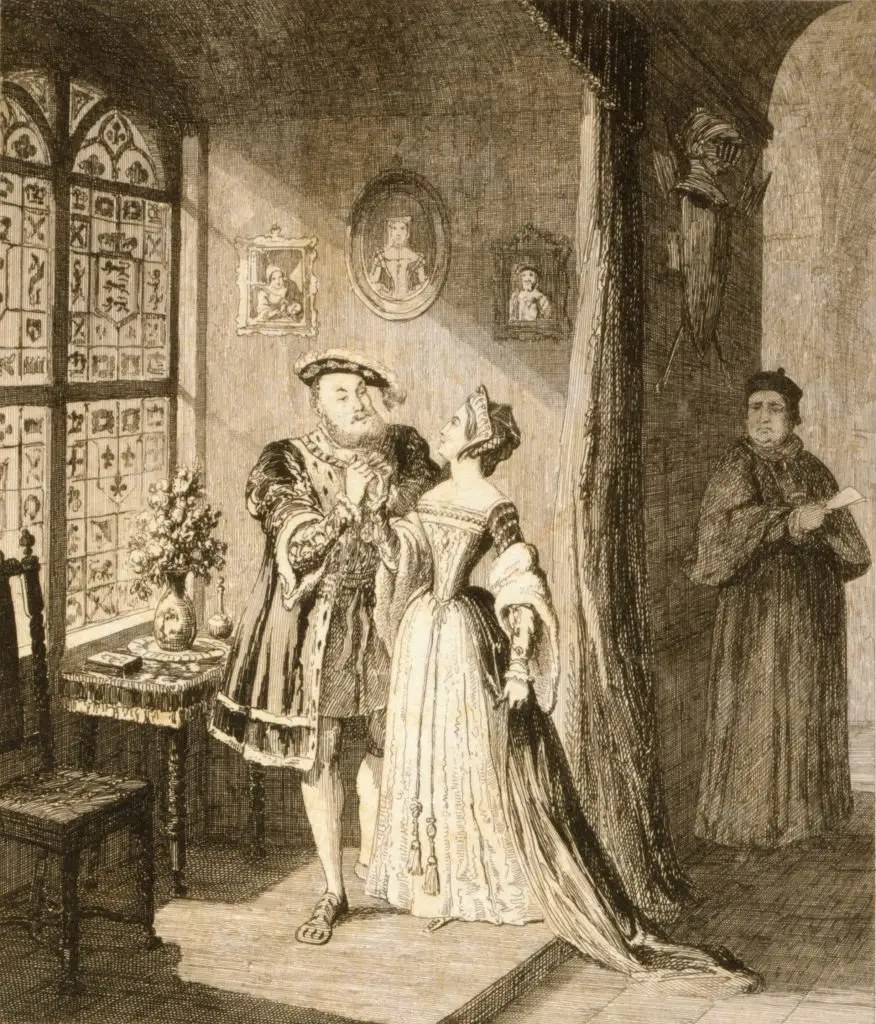
Henry’s Reconciliation with Anne Boleyn, by George Cruikshank, 19th century (Wiki Image).
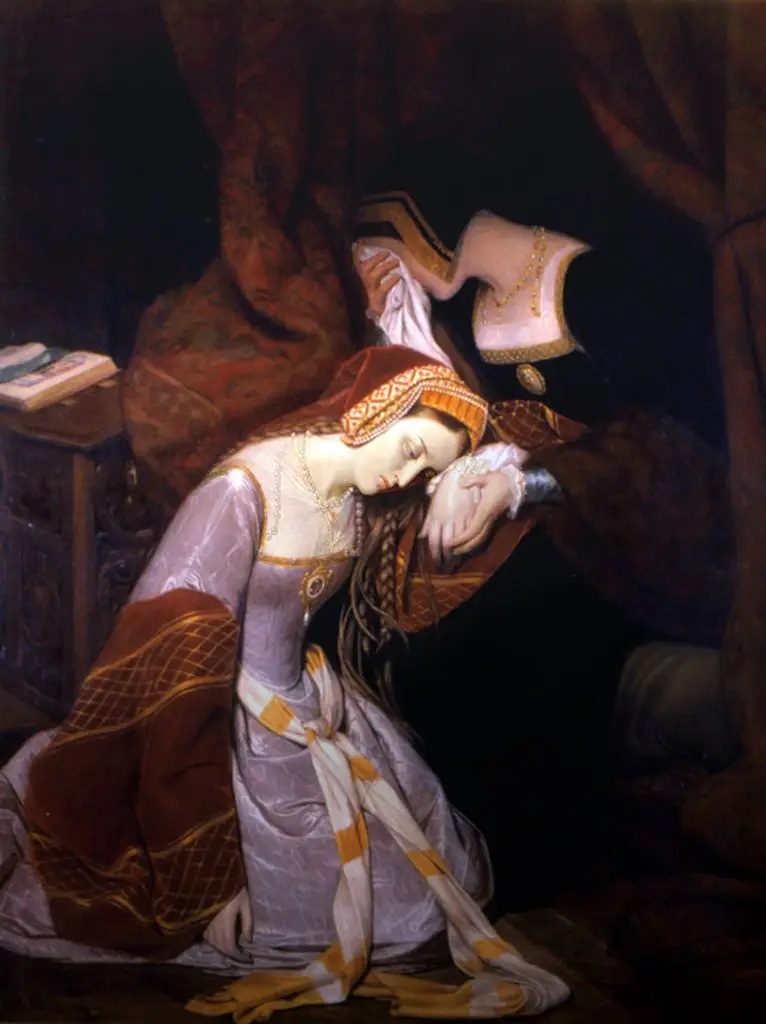
Anne Boleyn in the Tower by Édouard Cibot (1799–1877) (Wiki image).
You’re seeking to capture the essence of Anne Boleyn and Henry VIII’s tumultuous relationship through their words! It’s a fascinating and complex story of love, ambition, and tragedy. Here are ten quotes that offer a glimpse into their passionate affair and its dramatic consequences:
Anne Boleyn:
- “Sir, your wife, I cannot be, both in respect to my own unworthiness and also because you have a Queen already. Your mistress I will not be.” – This quote reveals Anne’s initial resistance to Henry’s advances, refusing to be merely a mistress and demanding recognition as his rightful wife.
- “I beseech you now with all my heart definitely to let me know your whole mind as to the love between us two. For I must tell you plainly that I will not be kept in this suspense any longer.” – Anne’s words express her frustration with Henry’s indecision and her desire for a clear commitment from him.
- “Give me the crown and the fine clothes, and you’ll have a queen.” – This quote, though likely apocryphal, captures Anne’s ambition and awareness of the power and status of being queen.
- “O Death, rock me asleep, bring me to quiet rest, let pass my weary guiltless ghost out of my careful breast.” – These lines, attributed to Anne while imprisoned in the Tower of London, reflect her despair and sense of injustice before her execution.
Henry VIII:
- “I have been more than seven years, struck with the dart of love for Anne Boleyn.” – Henry’s words reveal the depth of his infatuation with Anne and the long-lasting nature of his desire for her.
- “Lovingly and most heartily I thank you for your letter, which gave me such joy and comfort as I never had before.” – This quote from one of Henry’s many love letters to Anne expresses his passionate feelings and the happiness she brought him.
- “If it please you to do the office of a true loyal mistress and friend, and to give up yourself body and heart to me, who will be, and have been your most loyal servant…” – Henry’s words reveal his desire for Anne’s complete devotion and his willingness to elevate her to the position of queen.
- “The King commands that you surrender this whole matter into his hands. Otherwise, the court will condemn you.” – This quote, spoken to Catherine of Aragon, demonstrates Henry’s determination to divorce his first wife and marry Anne, even if it means defying the Church and risking political turmoil.
Together:
- “The King and Queen, her father, mother, and I, went to mass… after which they danced.” – This quote from a Venetian ambassador describes the early days of their courtship, highlighting the public nature of their relationship and the initial joy it brought.
- “The King is very well and merry, and, the Queen also, such is the love he bears her.” – This observation from a Spanish diplomat captures the apparent happiness of the couple in the early years of their marriage before the tragic turn of events that led to Anne’s downfall.
| Year | Age (Anne) | Age (Henry) | Event | Significance |
|---|---|---|---|---|
| 1525 | ~24 | 34 | Henry VIII becomes enamored with Anne Boleyn | Anne, a lady-in-waiting to Queen Catherine of Aragon, catches Henry’s eye. He begins pursuing her, initiating a period of intense courtship. |
| 1526 | ~25 | 35 | Henry seeks an annulment from Catherine of Aragon | Henry, determined to marry Anne, seeks to annul his marriage to Catherine, citing biblical grounds and claiming their marriage is cursed due to her previous marriage to his brother. |
| 1527 | ~26 | 36 | Henry breaks with the Roman Catholic Church | Unable to secure an annulment from the Pope, Henry declares himself Supreme Head of the Church of England, paving the way for his divorce from Catherine. |
| 1533 | ~32 | 42 | Henry secretly marries Anne Boleyn | With his marriage to Catherine annulled, Henry secretly weds Anne. |
| 1533 | 32 | 42 | Anne is crowned Queen | Anne is crowned Queen Consort in a lavish ceremony, marking a significant shift in England’s religious and political landscape. |
| 1533 | 32 | 42 | Anne gives birth to Elizabeth | Anne gives birth to a daughter, Elizabeth (later Queen Elizabeth I), but Henry is disappointed by the lack of a male heir. |
| 1534 | 33 | 43 | Act of Supremacy | Parliament passes the Act of Supremacy, formally establishing Henry as the head of the Church of England. |
| 1536 | 35 | 45 | Anne miscarries a son | Anne suffers a miscarriage, further straining her relationship with Henry and diminishing her chances of providing a male heir. |
| 1536 | 35 | 45 | Anne is arrested and accused of adultery, incest, and treason | Facing growing opposition and Henry’s desire for a new wife, Anne is accused of various crimes, likely fabricated. |
| 1536 | 35 | 45 | Anne is found guilty and beheaded | Anne is executed at the Tower of London, marking a tragic end to her tumultuous relationship with Henry. |
The Reality Of Henry VIII And Anne Boleyn’s Relationship …
Lust To Loathing: Henry VIII & Anne Boleyn’s Turbulent Love …
Anne Boleyn: A Queen Condemned (2023)
(YouTube video)
Anne Boleyn and Henry VIII: A Tumultuous and Transformative Love Affair
The love story of Anne Boleyn and Henry VIII is one of history’s most famous and tragic romances. Their relationship began in the early 1520s when Anne, a young and intelligent lady-in-waiting to Queen Catherine of Aragon, caught the eye of the king. Unlike other women who had succumbed to Henry’s advances, Anne was stubborn and refused to become his mistress. This resistance intrigued Henry and only deepened his desire for her. However, Anne made it clear that she would not yield to him unless he made her his queen, a bold stance that set the stage for one of the most significant upheavals in English history.
By the mid-1520s, Henry VIII desperately needed a male heir to secure the Tudor dynasty. His wife, Queen Catherine, had failed to produce a surviving son after numerous pregnancies, leaving Henry increasingly frustrated. He saw in Anne Boleyn the possibility of both personal and political salvation. However, there was a significant obstacle in his path—his marriage to Catherine was still valid in the eyes of the Catholic Church. Determined to marry Anne, Henry petitioned the Pope for an annulment, citing Catherine’s previous marriage to his brother, Arthur, as grounds for the dissolution of their union.
When the Pope refused to grant the annulment, Henry became increasingly enraged. His desire to marry Anne and produce an heir was so intense that he was willing to break away from the Roman Catholic Church. With Anne’s encouragement, Henry took the drastic step of establishing the Church of England, declaring himself the Supreme Head of the Church. This bold move allowed Henry to annul his marriage to Catherine without papal approval, and in 1533, he married Anne in a secret ceremony. Later that year, Anne was crowned queen, but her coronation was met with mixed reactions from the English people, many of whom still supported Catherine.
Anne Boleyn’s early days as queen were filled with anticipation, especially when she became pregnant shortly after marrying Henry. She and the king hoped for a son, but on September 7, 1533, Anne gave birth to a daughter, Elizabeth. Although disappointed, Henry remained hopeful that Anne would soon provide him with a male heir. However, Anne’s subsequent pregnancies ended in miscarriage or stillbirth, which began to erode her position in court. Meanwhile, Henry’s affection for Anne, which had once burned so brightly, started to cool.
Anne’s inability to produce a male heir was not the only factor in her downfall. Her assertive nature and willingness to involve herself in political matters alienated many at court, including some of Henry’s closest advisors. Furthermore, Henry had begun to take an interest in Jane Seymour, one of Anne’s ladies-in-waiting, whose quiet demeanor starkly contrasted Anne’s fiery personality. As Henry’s attention shifted to Jane, Anne’s enemies at court, including Thomas Cromwell, saw an opportunity to rid the king of his troublesome queen.
In 1536, Anne Boleyn was arrested on charges of adultery, incest, and treason. The accusations were likely fabricated, as the evidence against her was weak and primarily based on rumors and confessions extracted under duress. Nevertheless, Anne was put on trial, and despite her eloquent defense, she was found guilty. On May 19, 1536, Anne was executed at the Tower of London by beheading. Her death marked the tragic end of her rise to power, and she became the first English queen to be executed.
Although Anne Boleyn’s life ended in tragedy, her legacy lived on through her daughter, Elizabeth. In a twist of fate, Elizabeth ascended the throne in 1558 and became one of England’s greatest monarchs, reigning for 45 years during a period known as the Elizabethan Age. Under Elizabeth’s rule, England flourished both politically and culturally, cementing Anne’s posthumous significance in English history.
Anne’s relationship with Henry VIII was more than just a love affair—it catalyzed monumental change. Their union led to the English Reformation, the dissolution of the monasteries, and the establishment of the Church of England. These changes had lasting consequences, shaping England’s religious, social, and political landscape for generations. Despite the tragic ending of their romance, Anne Boleyn’s legacy as a key figure in one of the most transformative periods in English history endures.
Today, Anne Boleyn is remembered as a complex and controversial figure, both a victim of her ambitions and a woman who helped shape the course of English history. Her love for Henry VIII, which led to her rise and fall, remains one of the most compelling stories of power, passion, and tragedy in the annals of history.
Josephine and Napoleon Bonaparte Lovers (France)
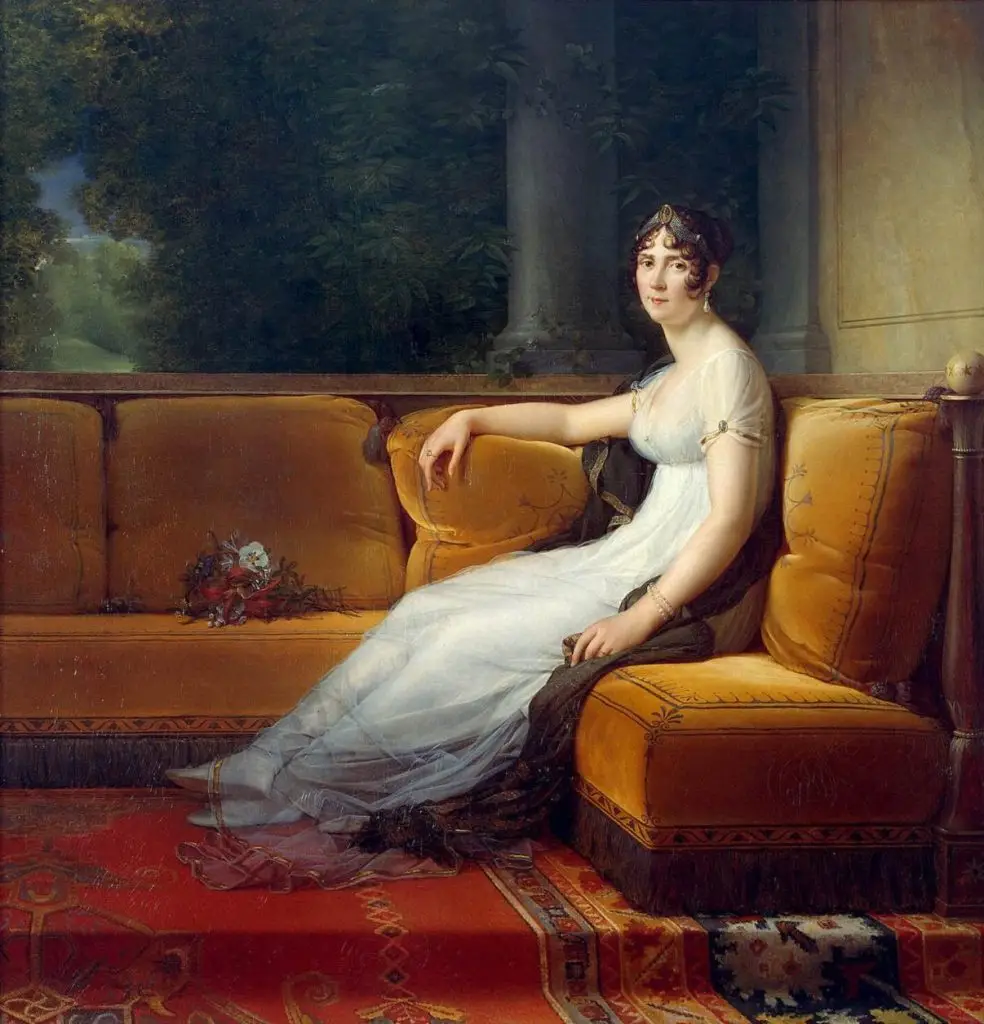
Joséphine de Beauharnais at the château de Malmaison. 1801. By François Gérard (Wiki Image).
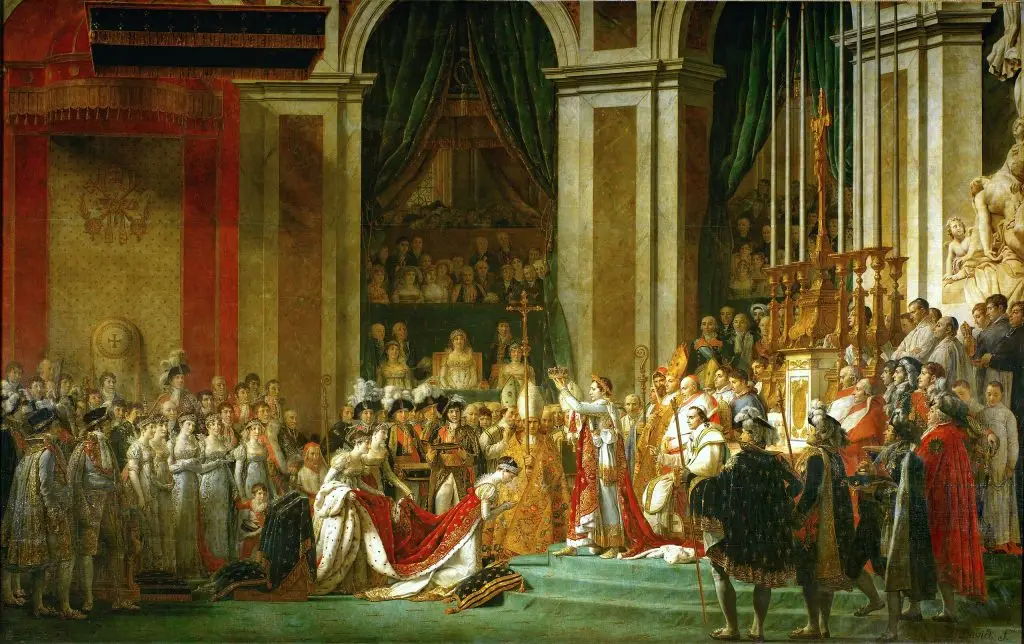
The Coronation of Napoleon by Jacques-Louis David (1804) (Wiki Image).
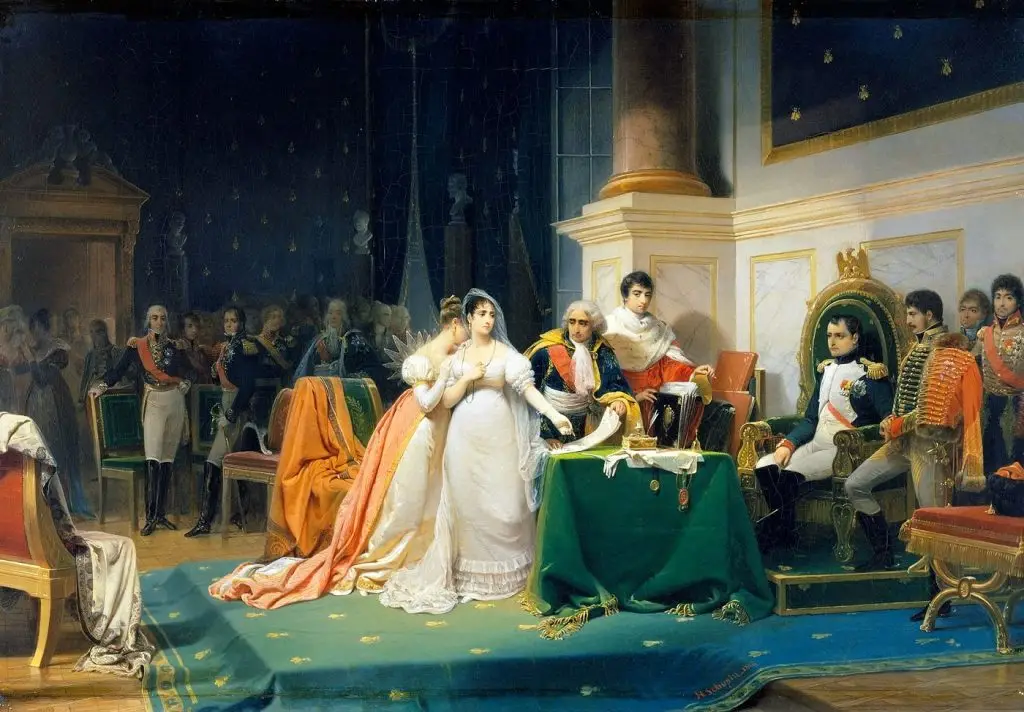
The Divorce of the Empress Josephine in 1809 by Henri Frédéric Schopin (Wiki Image).
Ah, the tempestuous romance of Josephine and Napoleon! Their relationship was a whirlwind of passion, ambition, betrayal, and heartbreak. Here are ten quotes that capture the essence of their complex love story:
From Napoleon:
- “I awaken filled with thoughts of you. Your portrait and the intoxicating evening which we spent yesterday have left my senses in turmoil.” – This reveals the intensity of Napoleon’s early infatuation with Josephine, his thoughts consumed by her.
- “Since I left you, I have been constantly depressed. My happiness is to be near you. Incessantly I live over in my memory your caresses, your tears, your affectionate solicitude. The charms of the incomparable Josephine kindle are continually burning, and there is a brilliant flame in my heart.” This passionate declaration highlights the depth of his feelings and his longing for her presence.
- “I don’t love you anymore; on the contrary, I detest you. You are a wretch, truly perverse and truly stupid.” – Napoleon’s fiery temper and volatile emotions are evident in this outburst, revealing a darker side to their relationship.
- “Power is my mistress. I have worked too hard at her conquest to allow anyone to take her away from me.” – This quote reflects Napoleon’s ambition and his prioritization of power over love, foreshadowing the eventual end of their marriage.
- “Josephine, my destiny is stronger than my will. My dearest love, be less beautiful, less graceful, less tender, and especially, less good.” – Despite his love for Josephine, Napoleon acknowledges the pressures of his position and the need for an heir, which she could not provide.
From Josephine:
- “I love you no less than you love me, but I shall not be jealous. I shall not write you things that might distress you.” – Josephine’s words reveal her understanding of Napoleon’s demanding nature and her willingness to support him without complaint.
- “Bonaparte, do not be a tyrant! You used to love me because I loved you and did not seek to dominate you. Do not lose these advantages.” – This quote shows Josephine’s attempt to maintain a sense of equality in their relationship, urging Napoleon not to let power corrupt his love for her.
- “I have wept much since your departure. You have never been away so long, nor have I ever been so long without receiving news of you. Ah! Surely you must have ceased to love your Josephine!” – Josephine’s words express her vulnerability and fear of losing Napoleon’s affection due to his prolonged absences.
- “I watched you depart, my very soul went with you, and, until I see you again, I shall be but half alive.” – This quote conveys Josephine’s deep attachment to Napoleon and the profound impact his absence had on her.
- “Farewell, my friend, may the good God protect you and never punish you for having made me so happy.” – Even in their final farewell, Josephine expresses gratitude for the happiness she experienced with Napoleon despite the pain of their separation.
| Year | Age (Josephine) | Age (Napoleon) | Event | Significance |
|---|---|---|---|---|
| 1795 | 32 | 26 | Meet at a social gathering | Josephine, a widow and socialite, is introduced to the ambitious young general, Napoleon Bonaparte. |
| 1796 | 33 | 27 | Marry in a civil ceremony | Despite their different backgrounds and social circles, they are quickly drawn to each other and marry. |
| 1796-1799 | 33-36 | 27-30 | Napoleon’s Italian and Egyptian campaigns | Napoleon’s military successes increase his power and fame, while Josephine remains in Paris, navigating the social and political scene. |
| 1799 | 36 | 30 | Napoleon returns to Paris and stages a coup | He becomes First Consul of France, solidifying his power. |
| 1804 | 41 | 35 | Napoleon crowns himself Emperor of France | Josephine is crowned Empress alongside him, marking the height of their power and influence. |
| 1805-1809 | 42-46 | 36-40 | Strained relationship and rumors of infidelity | The couple faces growing pressure to produce an heir, and rumors of infidelity on both sides strain their relationship. |
| 1809 | 46 | 40 | Napoleon divorces Josephine | Unable to have children with Josephine, Napoleon divorces her to marry Marie Louise of Austria, hoping to secure a dynastic heir. |
| 1810 | 47 | 41 | Napoleon marries Marie Louise | Josephine is heartbroken but maintains a cordial relationship with Napoleon. |
| 1814 | 51 | 45 | Napoleon’s first abdication and exile | Josephine remains loyal to Napoleon, even in his defeat. |
| 1815 | 52 | 46 | Napoleon’s return and defeat at Waterloo | |
| 1815 | 52 | 46 | Josephine dies at Malmaison | Napoleon is devastated by her death, reportedly keeping a locket with her hair for the rest of his life. |
Napoleon & Josephine: France’s Tragic Love Story | The …
Napoleon’s Complicated Relationship With His Wife Josephine
Josephine Bonaparte – Wife of Napoleon & Empress of the …
(YouTube video)
Josephine and Napoleon Bonaparte: A Love That Shaped an Empire (France)
Josephine de Beauharnais and Napoleon Bonaparte’s love story is filled with passion, power, and political intrigue. Born Marie Josèphe Rose Tascher de La Pagerie in 1763, Josephine came from a wealthy colonial family in Martinique. She first married Alexandre de Beauharnais, a French nobleman, and had two children, Eugène and Hortense. However, her first marriage ended in tragedy during the Reign of Terror when Alexandre was executed by guillotine. Josephine narrowly escaped the same fate, but her life changed forever when she met Napoleon Bonaparte, a young and ambitious military officer, in 1795.
Napoleon, six years her junior, was immediately smitten with Josephine despite her reputation as a widow with children. She was not the typical beauty of the time, but her charm, grace, and social connections captivated him. Napoleon pursued Josephine relentlessly, and she eventually accepted his advances. Their marriage, which took place on March 9, 1796, marked the beginning of a relationship that would shape their personal lives and the course of French history. Napoleon was deeply in love with her, referring to her as “my incomparable Josephine” in his letters, filled with romantic longing and passion.
However, their marriage was far from perfect. While Napoleon was madly in love with Josephine, her feelings toward him were initially more tepid. She was known to have had affairs with other men, particularly during the early years of their marriage while Napoleon was away on military campaigns. These infidelities deeply hurt Napoleon, who was often consumed with jealousy. Despite this, he remained devoted to her, though his letters became increasingly desperate and accusing as rumors of her affairs reached him.
As Napoleon’s military success grew, so did his political ambitions. In 1804, he declared himself Emperor of the French, and Josephine became Empress. Her charm and sophistication helped Napoleon solidify his rule, and she played the role of empress with elegance and grace. However, despite their public image as a powerful couple, their marriage faced one significant obstacle: Josephine could not bear Napoleon as an heir. Napoleon adored her two children from her first marriage but was determined to have a legitimate son to secure his dynasty.
This inability to produce an heir placed an enormous strain on their relationship. Though still deeply affectionate toward Josephine, Napoleon began to see the necessity of securing his political future. In 1809, after years of internal conflict, Napoleon decided to divorce Josephine. The divorce was a heartbreaking moment for both of them, but it was done with mutual respect. Napoleon wept during the proceedings, and Josephine reportedly fainted. Though their marriage ended, their emotional bond remained strong, and they continued to correspond and visit each other.
Following their divorce, Napoleon remarried in 1810, taking Marie Louise, an Austrian archduchess, as his second wife. She would eventually give him the son he desired, but Josephine’s presence in his life never truly faded. Napoleon often thought of her and spoke of her fondly. For her part, Josephine retired to her private residence at Malmaison, where she spent her remaining years focusing on her gardens and family. She remained a beloved figure in France, even after her time as empress had ended.
Josephine passed away in 1814, just months before Napoleon’s first exile to Elba. Upon hearing of her death, Napoleon is said to have locked himself in his room for two days, overcome with grief. Despite their separation, Josephine had been the love of his life, and her death marked the end of an era for him. He carried a locket containing her portrait during his final days in exile on Saint Helena, where he would die in 1821.
The love story of Josephine and Napoleon is remembered not only for its intense passion and heartbreak but also for the profound impact it had on both of their lives. Josephine’s grace and connections helped pave the way for Napoleon’s rise to power, and despite their tumultuous relationship, they remained bound by a deep and enduring affection. Their love story is one of history’s most famous and complex, symbolizing both the power of personal relationships and their role in shaping the fate of nations.
Simone de Beauvoir and Jean-Paul Sartre Lovers (France)
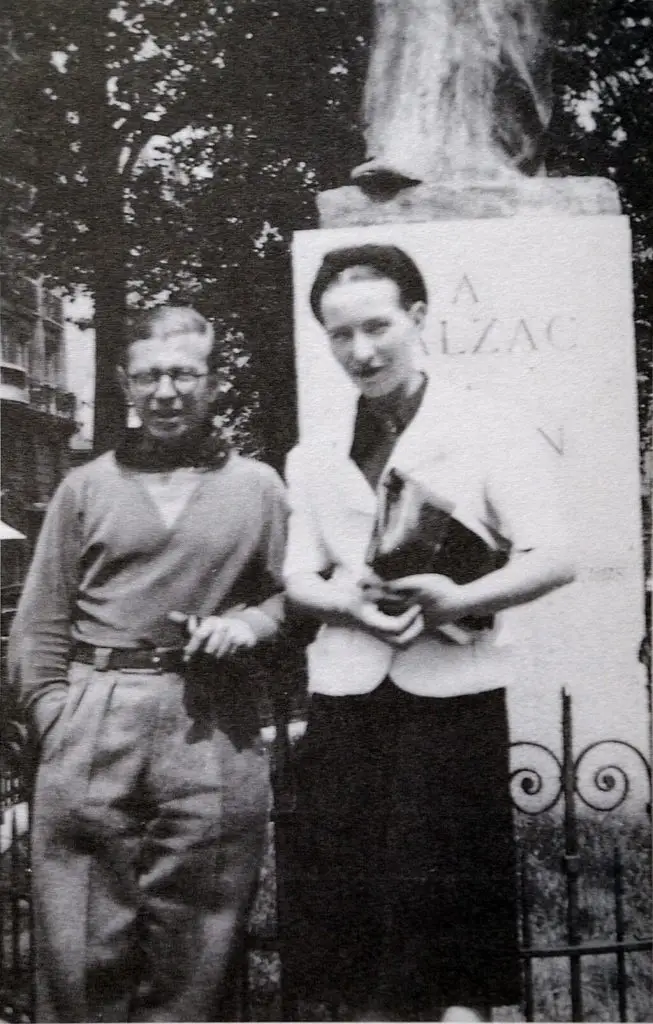
Jean-Paul Sartre and Simone de Beauvoir at the Balzac Memorial (Wiki Image).
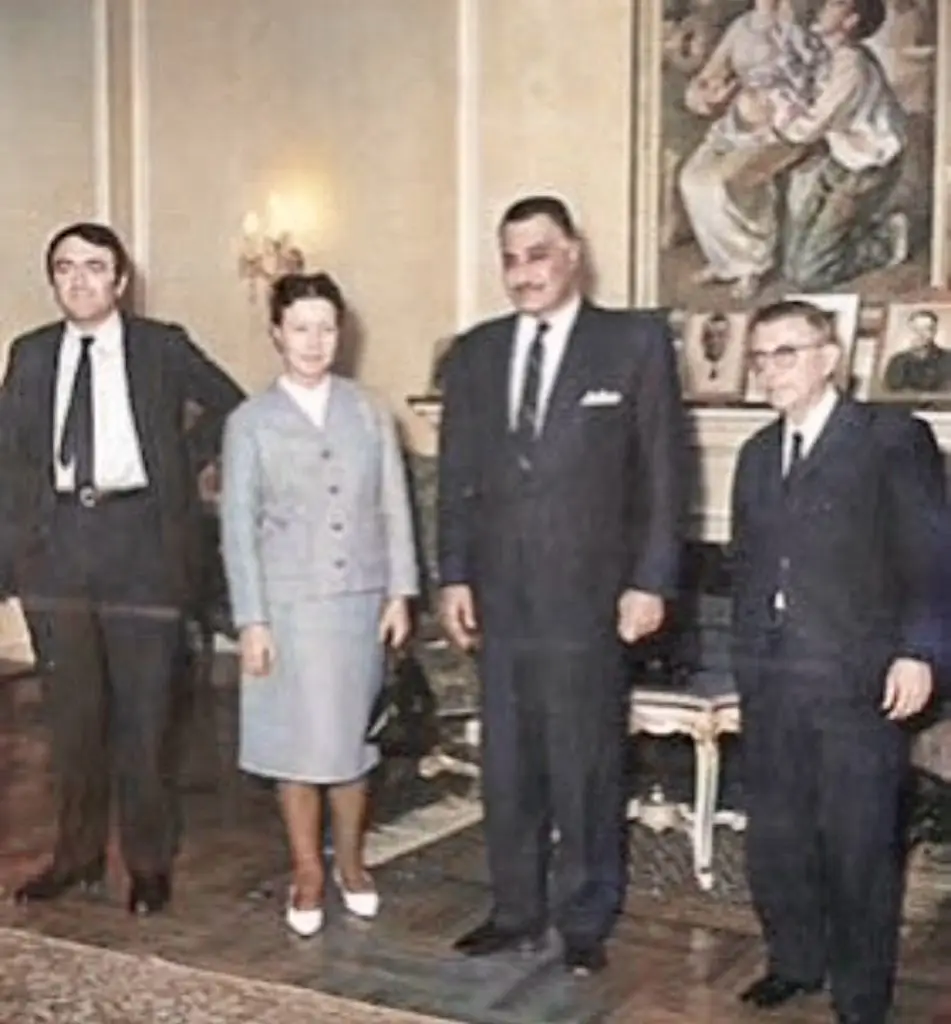
Egypt’s President Gamal Abdel Nasser, Beauvoir, Sartre in Cairo, 1967 (Wiki Image).
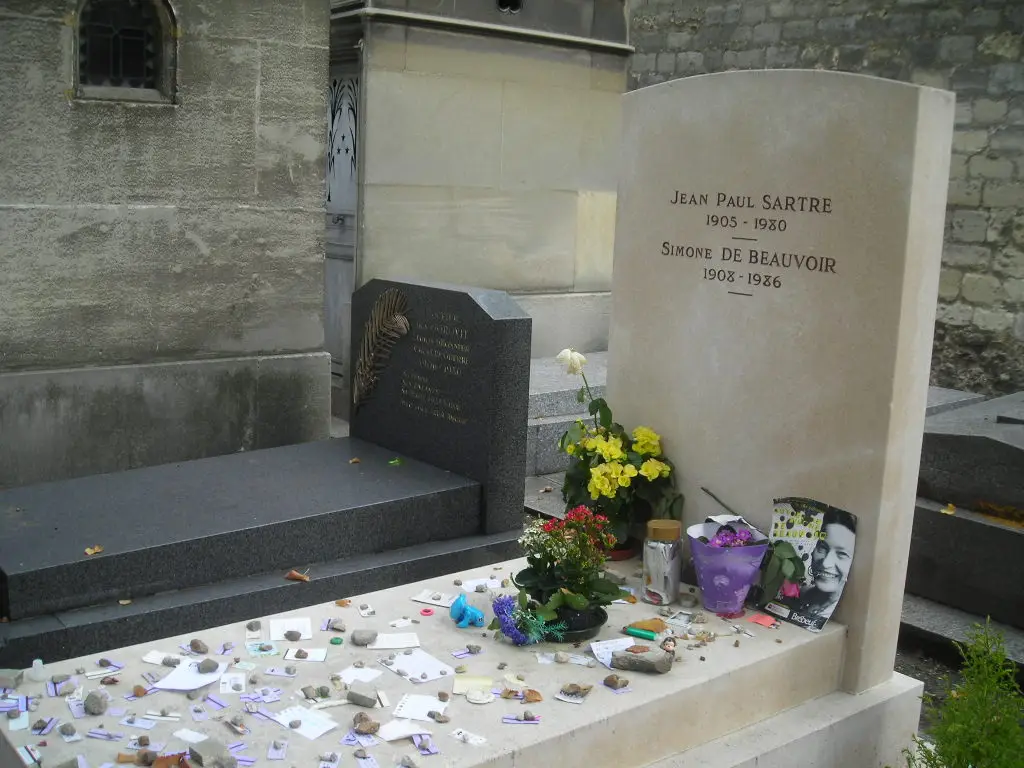
Beauvoir’s and Sartre’s grave at the Cimetière du Montparnasse (Wiki Image).
Ah, the intellectual and passionate bond between Simone de Beauvoir and Jean-Paul Sartre! Their unconventional relationship defied societal norms and became a testament to their shared commitment to freedom and existentialist philosophy. Here are ten quotes that offer a glimpse into their unique connection:
From Simone de Beauvoir:
- “I wish I had been the first to discover Sartre, but it was he who discovered me.” – This reveals the profound impact Sartre had on her intellectual and personal development.
- “Between Sartre and me, there was a kind of essential agreement which bound us together.” – This highlights the deep intellectual connection and shared values that formed the foundation of their relationship.
- “I tore myself away from the safe comfort of certainties through my love for Sartre.” – Her love for Sartre challenged her conventional upbringing and pushed her to embrace a more independent and unconventional life.
- “Our relationship was a unique adventure, and I wouldn’t trade it for anything.” – Despite its complexities, Beauvoir cherished their unconventional bond and the freedom it afforded them.
- “I am incapable of conceiving infinity, and yet I do not accept finity.” – This quote from her philosophical work reflects the existentialist ideas that she and Sartre explored together, questioning the nature of existence and human freedom.
From Jean-Paul Sartre:
- “She is the most intelligent woman I have ever met.” – Sartre recognized and admired Beauvoir’s intellectual brilliance, a key element in their connection.
- “Our love was a necessity, not a choice.” – This suggests that their bond was something deeper than a mere romantic connection, a fundamental aspect of their identities.
- “I love you for your freedom, and I want you to love me for mine.” – This reflects their shared commitment to individual autonomy and their rejection of traditional, possessive relationships.
- “We were two of a kind, and our love was a reflection of that.” – Sartre recognized their shared intellectual curiosity and passion for life as the foundation of their bond.
- “She is my double, and I am hers.” This powerful statement encapsulates their profound connection and mutual understanding as they see each other as reflections of themselves.
| Year | Age (de Beauvoir) | Age (Sartre) | Event | Significance |
|---|---|---|---|---|
| 1929 | 21 | 24 | Meet as students preparing for the agrégation in philosophy | They quickly bond over their shared intellectual interests and ambitions. |
| 1929 | 21 | 24 | Begin their lifelong “pact” | They agree to a unique relationship based on intellectual freedom and “essential love,” allowing for “contingent love affairs” with others. |
| 1930s | 20s | 20s | Early years of their relationship | They travel, write, and engage in philosophical discussions, establishing themselves as leading intellectuals in Paris. |
| 1940s | 30s | 30s | World War II and its aftermath | Sartre is captured and imprisoned by the Germans; de Beauvoir actively participates in the Resistance. Their experiences during the war shape their philosophical and political views. |
| 1949 | 41 | 44 | De Beauvoir publishes The Second Sex | A groundbreaking feminist work that explores the social and historical construction of womanhood. Sartre strongly supports her work. |
| 1950s-1960s | 40s-50s | 40s-50s | Height of their intellectual and political influence | They become prominent figures in the existentialist movement and engage in political activism. Their open relationship continues, with both having other lovers. |
| 1970s | 60s | 60s | Sartre’s health declines | De Beauvoir becomes increasingly involved in caring for Sartre. |
| 1980 | 72 | 75 | Sartre dies | De Beauvoir is deeply affected by his death. |
| 1981 | 73 | – | De Beauvoir publishes Adieux: A Farewell to Sartre | A moving account of Sartre’s final years and their relationship. |
| 1986 | 78 | – | De Beauvoir dies | She is buried next to Sartre in Montparnasse Cemetery. |
The meaning of life according to Simone de Beauvoir – Iseult …
Sartre & Beauvoir on Feminism & Relationships
Jean-Paul Sartre and Simone de Beauvoir Screener
(YouTube vidoe)
Simone de Beauvoir and Jean-Paul Sartre were one of the most iconic intellectual couples of the 20th century. Their personal and professional relationship challenged the traditional norms of love, marriage, and partnership, reflecting their deep commitment to existential philosophy. The two first met in 1929 at the Sorbonne, where they were both studying for the highly competitive agrégation in philosophy. De Beauvoir, only 21 at the time, was immediately drawn to Sartre’s brilliance and unconventional approach to life, and Sartre, impressed by de Beauvoir’s intellect and beauty, initiated what would become a lifelong partnership.
From the beginning, Sartre and de Beauvoir agreed that their relationship would be unique. They rejected the idea of traditional monogamy, opting instead for what they called a “necessary love,” which allowed for “contingent loves” or other romantic and sexual relationships outside of their primary bond. This arrangement, which was highly unusual for the time, became a defining aspect of their relationship and a practical extension of their existentialist philosophy. Sartre believed in absolute freedom and argued that social institutions like marriage should not constrain human beings. While sharing similar views, De Beauvoir often found herself more emotionally attached to Sartre than he was to her, but she maintained her independence throughout their lives.
Their relationship was challenging. Sartre’s frequent affairs, particularly with much younger women, often strained his bond with de Beauvoir. However, the two were intellectually inseparable, collaborating on many philosophical and political projects. Sartre’s existentialist views, particularly the idea that existence precedes essence, influenced much of de Beauvoir’s work, including her groundbreaking feminist text The Second Sex. In return, de Beauvoir’s exploration of women’s oppression and freedom gave Sartre a more nuanced understanding of gender and personal autonomy.
Though Sartre and de Beauvoir never married or lived together, their emotional and intellectual intimacy endured for over 50 years. They maintained separate apartments but wrote to each other constantly when apart, sharing their thoughts, experiences, and even details about their other relationships. Their letters reveal a complex mix of love, jealousy, intellectual admiration, and sometimes resentment. Yet, despite the emotional complications, they remained each other’s most trusted confidants and collaborators.
Both Sartre and de Beauvoir were politically engaged in their time’s significant social and political movements. They were outspoken critics of colonialism, capitalism, and traditional power structures. Sartre’s involvement in leftist politics, particularly his support for Marxism and anti-colonial struggles, often aligned with de Beauvoir’s feminist activism. While de Beauvoir’s feminism sometimes led to friction between them, mainly when Sartre was slow to recognize certain aspects of gender inequality, their shared commitment to political causes cemented their bond.
Their partnership was not only intellectual but also deeply emotional. Despite their unconventional approach to love, Sartre and de Beauvoir remained profoundly connected until Sartre died in 1980. De Beauvoir was devastated by his passing, and in her memoir Adieux: A Farewell to Sartre, she wrote about his final days, reflecting on the nature of their relationship, his philosophical legacy, and her grief at losing the man who had been her companion in life and thought for over five decades.
In the years after Sartre’s death, de Beauvoir continued to write and advocate for feminist causes, but she was never the same without him. While often controversial, their relationship was a remarkable testament to the possibility of love and companionship outside the boundaries of societal conventions. It also highlighted the tensions and difficulties of such an arrangement, especially when emotions are involved.
Today, Simone de Beauvoir and Jean-Paul Sartre are remembered for their contributions to philosophy and literature and their groundbreaking and provocative relationship. Their partnership defied norms and continues to inspire discussions about the nature of love, freedom, and the complexity of human relationships. While some may view their relationship as a model of intellectual companionship, others see it as a cautionary tale about the challenges of maintaining personal freedom within a committed partnership.
Queen Victoria and Prince Albert Lovers (United Kingdom)
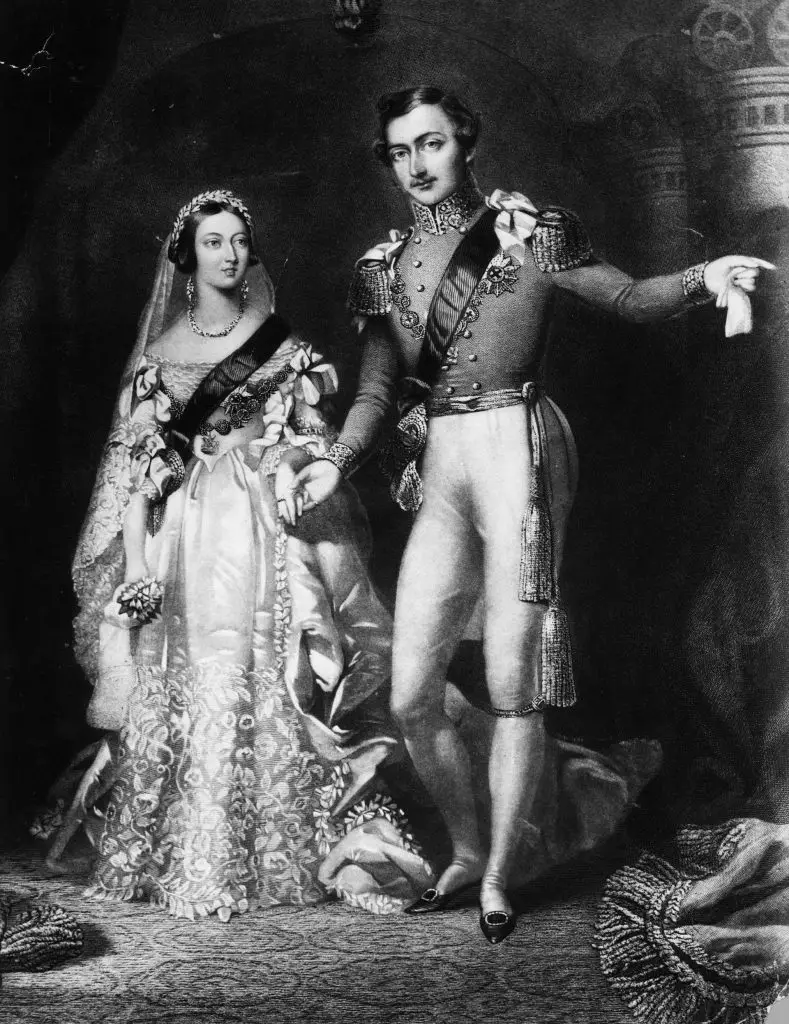
Queen Victoria and Prince Albert on their return from the marriage service at St James’s Palace, London, 10 February 1840. Engraved by S Reynolds after F Lock (Wiki Image).
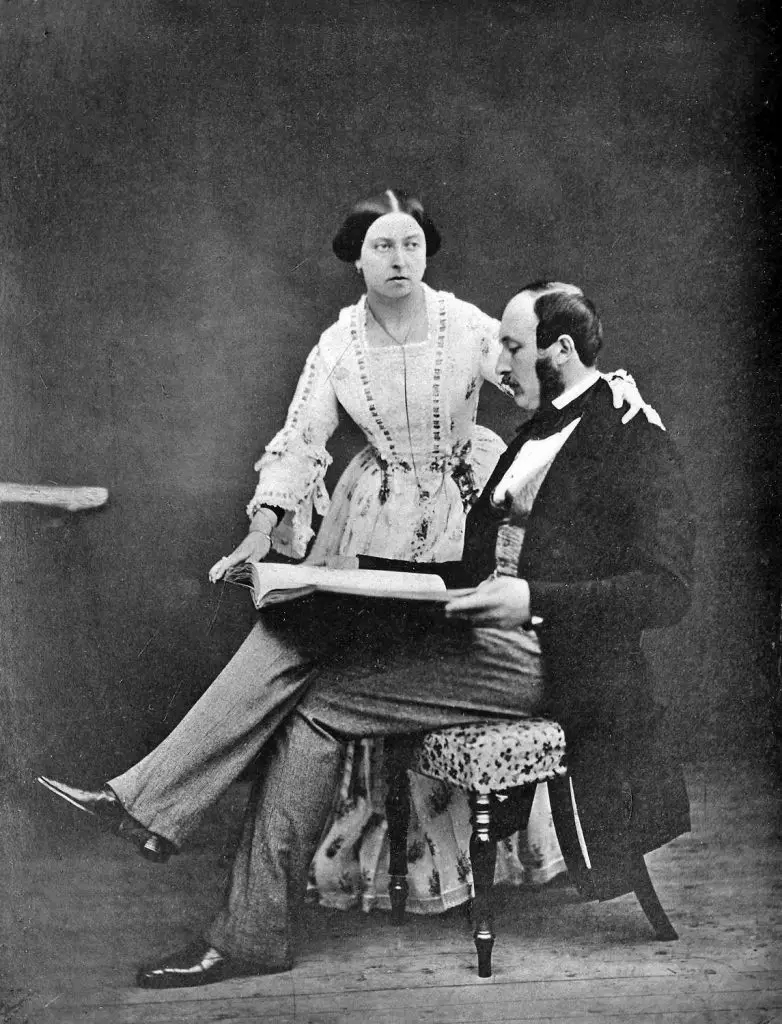
Queen Victoria and Prince Albert, 1854 (Wiki Image).
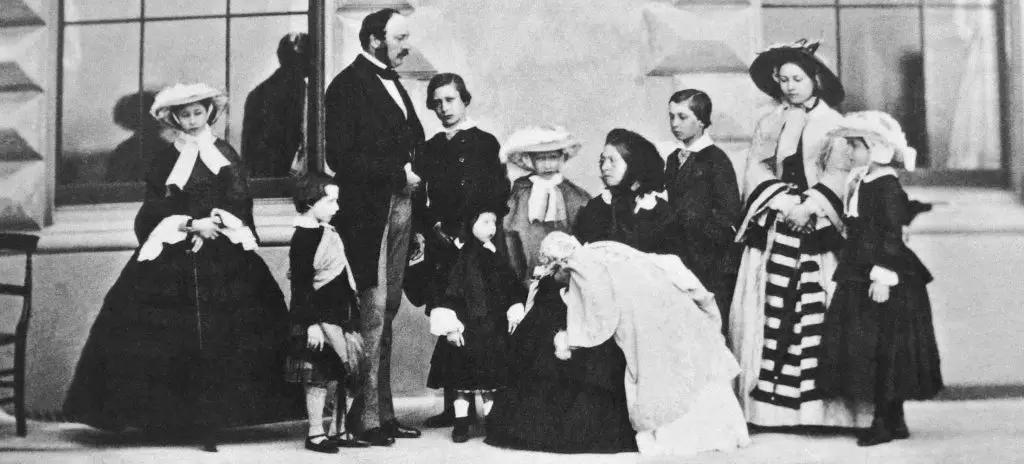
Prince Albert, Queen Victoria, and their nine children, 1857. Left to right: Alice, Arthur, Albert (Prince Consort), Albert Edward (Prince of Wales), Leopold, Louise, Queen Victoria with Beatrice, Alfred, Victoria and Helena (Wiki Image).
Ah, the enduring love story of Queen Victoria and Prince Albert! Their marriage was a true partnership, defying the expectations of royal unions at the time. Here are ten quotes that capture the depth of their affection and the profound impact they had on each other’s lives:
From Queen Victoria:
- “He is so handsome that I cannot look at him without a shudder.” – This early quote reveals Victoria’s initial infatuation with Albert, highlighting his striking appearance.
- “I NEVER, NEVER spent such an evening! MY DEAREST, DEAR Albert … his excessive love & affection gave me feelings of heavenly love & happiness I never could have hoped to have felt before!” – Victoria’s diary entry on their wedding night expresses her overwhelming joy and the depth of their connection.
- “Without him, everything loses its interest.” – This quote highlights Albert’s central role in Victoria’s life and the void his absence created.
- “He clasped me in his arms, and we kissed each other again and again!” – Victoria’s candid description of their affection reveals a passionate and intimate side to their relationship.
- “Never did I meet a man so perfect, so pure, so good, so truly angelic as he is.” – Victoria’s admiration for Albert’s character and virtues is evident in this glowing tribute.
From Prince Albert:
- “I am very happy now, but the excitement of the last few days was such that I have not been able to think much.” – Albert’s words after their wedding convey his happiness and the whirlwind of emotions surrounding their union.
- “I long for the time when I can be always with you.” – This quote expresses Albert’s deep affection for Victoria and his desire to be constantly by her side.
- “She is the only person who can exist with me without causing weariness.” Albert’s words reveal their unique compatibility and understanding.
Together:
- “Albert is indeed a great comfort to me. I cannot do without him.” – Victoria’s reliance on Albert for support and guidance is evident in this statement.
- “He is my treasure, my joy, my pride, my all in all.” Victoria’s heartfelt declaration encapsulates her profound love and devotion to her husband.
| Year | Age (Victoria) | Age (Albert) | Event | Significance |
|---|---|---|---|---|
| 1836 | 17 | 17 | First meeting | Victoria and Albert, who were first cousins, meet at Windsor Castle. Victoria finds Albert attractive, but their relationship is initially that of friendly cousins. |
| 1839 | 20 | 20 | Albert visits Victoria in Windsor | This visit sparks a deeper connection. Victoria is impressed by Albert’s intelligence, charm, and artistic talents. |
| 1839 | 20 | 20 | Victoria proposes to Albert | As the reigning monarch, Victoria takes the initiative and proposes marriage to Albert. |
| 1840 | 21 | 21 | Wedding at Chapel Royal, St. James’s Palace | A grand royal wedding solidifies their union. Victoria famously wears a white satin gown, setting a trend for white wedding dresses. |
| 1840-1857 | 21-38 | 21-38 | Birth of nine children | Victoria and Albert have a large family, with four sons and five daughters. |
| 1840s-1850s | 20s-30s | 20s-30s | Shared interests and collaborations | They share a passion for art, music, and social causes. Albert becomes a trusted advisor and partner in Victoria’s royal duties. |
| 1851 | 32 | 32 | Great Exhibition | Albert plays a key role in organizing the Great Exhibition, a showcase of industrial technology and design, further demonstrating his abilities and influence. |
| 1850s | 30s | 30s | Growing political influence of Albert | Albert becomes increasingly involved in political affairs, acting as a mediator and advisor to Victoria. |
| 1861 | 42 | 42 | Death of Prince Albert | Albert’s untimely death from typhoid fever devastates Victoria. She enters a long period of mourning and wears black for the rest of her life. |
| 1861-1901 | 42-81 | – | Victoria reigns as widow | Victoria continues to rule for another 40 years, but Albert’s influence remains strong. She cherishes his memory and often refers to him in her diaries and letters. |
The Forbidden Love Of Queen Victoria
A Brief History of Queen Victoria, 1837-1901
What Was Queen Victoria Like Behind Closed Doors …
(YouTube video)
Queen Victoria and Prince Albert shared a legendary love story that significantly shaped the British monarchy and the nation’s history. Their relationship began in 1839 when Albert, a German prince of Saxe-Coburg and Gotha, visited England. The young Queen Victoria, who had ascended to the throne just two years earlier, was immediately taken by Albert’s intelligence, kindness, and charm. Though the match had been encouraged by their families, particularly by Victoria’s uncle, King Leopold I of Belgium, Victoria herself proposed marriage. They were wed on February 10, 1840, in what was both a personal union and a political partnership that would span 21 years.
Victoria and Albert’s marriage was deeply passionate and affectionate, and Victoria was besotted with her husband from the beginning. She often called him her “angel” and “perfect husband.” Though reserved and introspective, Albert reciprocated Victoria’s love with unwavering devotion. Despite Victoria’s powerful position as monarch, Albert took on the role of her confidant and advisor, particularly in matters of state, where he played a crucial role behind the scenes. His influence helped Victoria navigate the complexities of her reign, and together, they formed a formidable team that modernized the British monarchy and stabilized the royal family after years of scandal and instability.
Albert’s role in Victoria’s life was not without its challenges. As a foreign prince, his initial position in the royal court was unclear, and many in Britain were skeptical of his influence. However, Albert gradually won over the British public and political establishment by taking on essential responsibilities, including overseeing education, science, and arts reforms. He was instrumental in organizing the Great Exhibition of 1851, a groundbreaking international showcase of industry and culture. Through these contributions, Albert supported Victoria’s reign and left a lasting legacy of modernization and reform in Britain.
Their marriage was also notable for its progressive approach to parenting. Victoria and Albert had nine children, and while Victoria found pregnancy and childbirth difficult, she and Albert were deeply involved in their children’s upbringing. Albert, in particular, emphasized education and moral values, raising their children to be well-versed in European politics and diplomacy. Their offspring would marry into many of Europe’s royal families, earning Victoria the nickname “Grandmother of Europe.” Despite their large family, Victoria’s writings reveal that she often struggled with the demands of motherhood and ruling, while Albert’s calming influence helped her navigate these pressures.
The deep affection between Victoria and Albert was evident in their personal correspondence and public displays of unity. They complemented each other in personality and responsibility, with Albert often being more measured and logical, while Victoria was emotional and passionate. This balance was crucial in their relationship, allowing them to present a unified front in private and public life. Together, they set a new standard for royal marriages, presenting a model of domestic bliss and moral rectitude that resonated with the Victorian public.
However, the stability and strength of their relationship were tragically cut short. In December 1861, Prince Albert fell seriously ill, and despite the efforts of doctors, he passed away from what was likely typhoid fever. His death devastated Victoria, who was overcome with grief and spent the rest of her life mourning his loss. She withdrew from public life for many years, wearing black for the remainder of her reign and keeping Albert’s rooms in their various residences precisely as he had left them. His death marked a turning point for Victoria, and she would never again be the same vibrant, energetic queen she had been during their marriage.
Despite Albert’s death, his influence on Victoria and the monarchy endured. Even after passing, Victoria idolized Albert, often referring to him as her guide and mentor. She commissioned numerous statues, monuments, and memorials in his honor, most famously the Albert Memorial in Kensington Gardens, London. Albert’s emphasis on constitutional monarchy and his commitment to public service continued to shape Victoria’s reign and the monarchy’s role in British society.
In the years following Albert’s death, Victoria remained devoted to his memory, and her love for him became a central aspect of her identity. Their relationship, built on mutual respect, intellectual partnership, and deep emotional connection, left a lasting impact on the British monarchy. Victoria and Albert redefined the royal family’s role, transforming it into a national unity and moral leadership symbol. This legacy continues to influence the monarchy to this day. Their love story remains one of history’s most enduring and celebrated royal romances.
Frida Kahlo and Diego Rivera Lovers (Mexico)
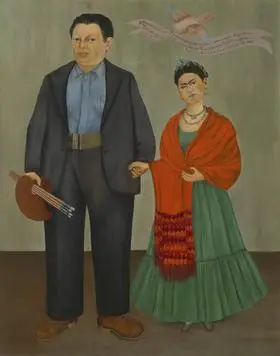
Frieda and Diego Rivera (Wiki Image).
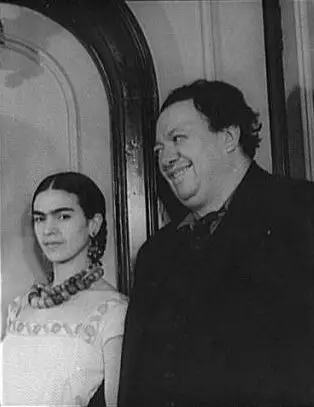
Frida Kahlo and Diego Rivera in 1932, photo by: Carl Van Vechten (Wiki Image).

Dolores del Río‘s portrait by Diego Rivera in the Museum Casa-Estudio Diego Rivera & Frida Kahlo in Mexico City (Wiki Image).
Frida Kahlo and Diego Rivera’s relationship was fiery and complex, full of passion, pain, betrayal, and unwavering love. Their artistic and personal lives were deeply intertwined, and their tumultuous connection left an indelible mark on them. Here are ten quotes that offer a glimpse into their passionate and turbulent love story:
From Frida Kahlo:
- “I suffered two grave accidents in my life. One in which a streetcar knocked me down…The other accident is Diego.” – This quote starkly illustrates the profound impact Diego had on her life, comparing him to a traumatic physical injury.
- “Diego is my husband. Diego is my friend. Diego is my mother. Diego is my father. Diego is my son. Diego is me.” – This reveals the all-encompassing nature of her love for Diego, seeing him as fulfilling multiple roles in her life.
- “I love you more than my own skin and even though you don’t love me the same way, you love me somehow, don’t you? And if you don’t, I’ll always have the hope that you do, and I’m satisfied with that. Love you like that, unconditionally, with no expectations.” – This expresses the depth of her love and her acceptance of its complexities, even with the pain of unrequited feelings.
- “Diego was everything; my child, my lover, my universe.” – Frida saw Diego as the center of her world, a source of immense joy and profound sorrow.
- “I don’t think the banks of a river suffer because they let the river flow.” – This metaphorical quote reflects Frida’s acceptance of Diego’s infidelity, acknowledging his nature while still loving him.
From Diego Rivera:
- “If I ever loved a woman, the more I loved her, the more I wanted to hurt her. Frida was only the most obvious victim of this disgusting trait.” – This disturbing confession reveals a darker side to Diego’s personality and his tendency to inflict pain on those he loved.
- “July 13, 1954, was the most tragic day of my life. I had lost my beloved Frida forever.” – Despite their tumultuous relationship, Diego expresses profound grief over Frida’s death, acknowledging her irreplaceable presence in his life.
- “I recommend her to you, not as a husband but as an enthusiastic admirer of her work, acid, and tender, hard as steel and delicate and fine as a butterfly’s wing, lovable as a beautiful smile, and as profound and cruel as the bitterness of life.” – This quote captures the essence of Frida’s art and personality, reflecting Diego’s admiration for her talent and complex nature.
Together:
- “Their union was like the collision of an elephant and a dove.” – This metaphor, often used to describe their relationship, highlights the stark contrast between their personalities and physical appearances.
- “They were a strange couple, but they had a deep and abiding love for each other.” – This observation acknowledges the unconventional nature of their relationship while emphasizing the enduring bond between them.
| Year | Age (Kahlo) | Age (Rivera) | Event | Significance |
|---|---|---|---|---|
| 1928 | 21 | 41 | Kahlo seeks Rivera’s opinion on her paintings | The young Kahlo, already developing her artistic style, approaches the renowned muralist Rivera for feedback. |
| 1929 | 22 | 42 | Marry in a civil ceremony | Despite their age difference and differing personalities, they are drawn to each other’s passion and intellect. |
| 1930s | 20s | 40s | Early years of their marriage, marked by infidelity and creative collaboration | They travel to the United States for Rivera’s mural commissions, where Kahlo further develops her artistic style. Their relationship is turbulent, with both having affairs. |
| 1934 | 27 | 47 | Kahlo has a miscarriage | A traumatic event that deeply affects Kahlo and is reflected in her art. |
| 1935 | 28 | 48 | Kahlo discovers Rivera’s affair with her sister Cristina | A devastating betrayal that leads to their separation. |
| 1939 | 32 | 52 | Divorce | Unable to reconcile after Rivera’s infidelity, they officially divorce. |
| 1940 | 33 | 53 | Remarry | Despite their difficulties, their bond remains strong, and they remarry a year later. |
| 1940s-1950s | 30s-40s | 50s-60s | Later years of their relationship | They continue to support each other’s artistic endeavors while maintaining a complex and often tumultuous relationship. |
| 1954 | 47 | 67 | Kahlo dies | Rivera is deeply saddened by her death. |
| 1957 | – | 70 | Rivera dies | He requests to be buried with Kahlo’s ashes, but his wish is not granted. |
Frida Kahlo and Diego Rivera. Rare Video Footage & Love …
Frida Kahlo & Diego Rivera
Frida Kahlo and Diego Rivera | Art, Love, & Collaboration Pt. 2 …
(YouTube video)
Frida Kahlo and Diego Rivera are among history’s most celebrated artistic couples. They are known for their tumultuous yet passionate relationship that mirrored the complexities of their individual lives and art. They first met in the early 1920s when Rivera, a prominent muralist, was commissioned to paint a mural at the National Preparatory School in Mexico City, where a young Frida was a student. Frida, already deeply influenced by her love for art and burgeoning political consciousness, was captivated by Rivera’s larger-than-life personality and reputation as a revolutionary artist. Their initial connection was fueled by mutual admiration for each other’s work, leading to a romantic relationship that would define their lives for decades.
Kahlo and Rivera married in 1931, but their union was anything but conventional. Both artists were passionate about their work and committed to their political beliefs, often challenging societal norms. Their marriage was marked by infidelities on both sides; Rivera’s numerous affairs, including a notorious relationship with actress Maria Felix, strained their bond, while Kahlo’s relationships with women and men, including a brief affair with Leon Trotsky, reflected her quest for identity and independence. Despite the chaos, their love remained a constant thread, woven through their shared passions for art, politics, and the Mexican culture they both cherished.
Kahlo and Rivera influenced each other’s artistic styles and ideologies throughout their relationship. Rivera, a leading figure in the Mexican muralist movement, often incorporated elements of indigenous culture and revolutionary themes into his work. On the other hand, Frida developed her unique painting style, characterized by vivid colors, surrealism, and deeply personal themes that explored her pain, identity, and femininity. Their conversations and artistic collaborations provided a fertile ground for creativity, allowing both to challenge and inspire one another. Kahlo’s paintings often reflected her inner turmoil, and Rivera’s support helped her gain recognition in the male-dominated art world.
Despite their artistic synergy, their relationship was fraught with emotional turmoil. Kahlo struggled with physical and emotional pain throughout her life, stemming from a childhood illness and a severe bus accident that left her with lifelong injuries. Rivera, while loving and supportive, sometimes struggled to understand the depth of her suffering, leading to tension between them. Kahlo’s often autobiographical works provided an outlet for her pain, exploring themes of identity, loss, and the female experience. Rivera’s robust persona contrasted sharply with Kahlo’s vulnerability, yet this juxtaposition contributed to their profound bond.
The couple’s political activism further intertwined their lives. Both were passionate about communism and social justice, participating in various political movements throughout Mexico. Rivera was a prominent member of the Communist Party, while Kahlo’s commitment to leftist politics and her Mexican heritage infused her art. Together, they advocated for workers’ rights, indigenous culture, and social equality, using their art as a platform to convey their political beliefs. Their shared commitment to activism forged a deep connection that transcended their struggles, highlighting their dedication to a more significant cause.
However, their relationship was also marked by periods of separation. After a tumultuous first marriage, they divorced in 1939, but their love for one another remained unwavering. This separation allowed them to explore their identities as individuals and artists without the constraints of their marriage. Kahlo embraced her independence, developed her artistic voice, and gained recognition as a painter. Rivera, too, continued to work prolifically, but he realized he could not live without Kahlo. In a testament to their enduring love, they remarried a year later, reinforcing the idea that their bond transcended traditional norms.
The couple’s artistic and personal struggles shaped their lives until their deaths. Kahlo’s health deteriorated over the years, leading to numerous surgeries and a decline in her physical condition. Despite her suffering, she remained fiercely dedicated to her art, producing iconic works that resonate with themes of resilience and identity. Rivera, in turn, continued to create monumental murals, often celebrating Mexican culture and history. Their art was a legacy of their tumultuous relationship, capturing their passions, struggles, and unyielding love for one another.
Today, Frida Kahlo and Diego Rivera are celebrated for their artistic contributions and passionate and complex love story. Their relationship defied conventional norms and expectations, showcasing a partnership built on mutual respect, admiration, and an unwavering commitment to their art and political beliefs. Kahlo’s vibrant, introspective paintings and Rivera’s grand murals remain influential, telling a story of love, pain, and the relentless pursuit of identity. Their legacy is a powerful reminder of the interplay between love and art and how personal experiences can shape creative expression.
Isabella I of Castile and Ferdinand II of Aragon Lovers (Spain)
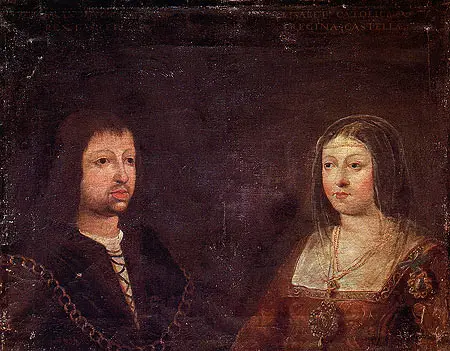
The wedding portrait of Ferdinand and Isabella, c. 1469 (Wiki Image).
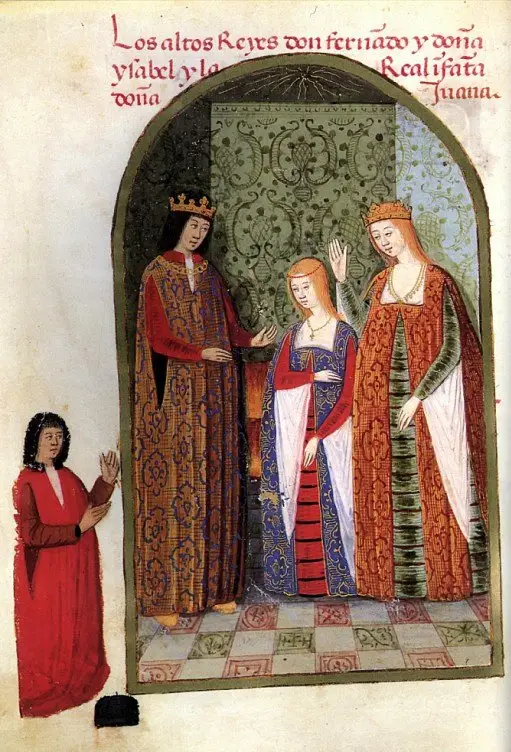
Isabella and Ferdinand with their daughter, Joanna, c. 1482 (Wiki Image).
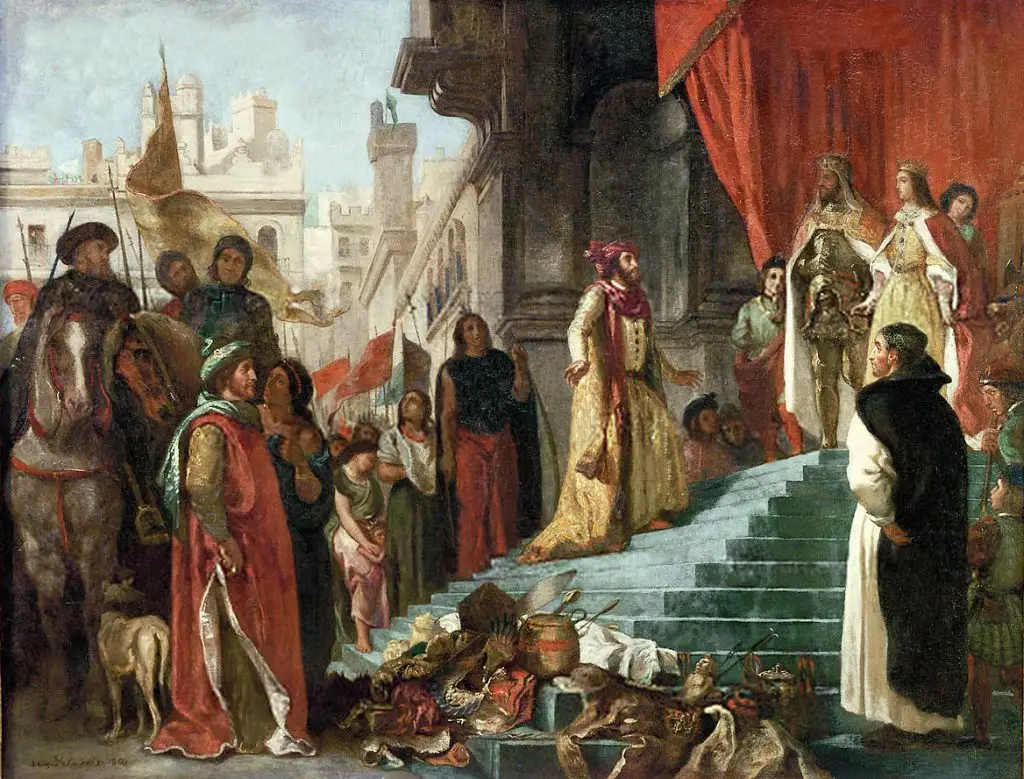
The return of Christopher Columbus; his audience before King Ferdinand and Queen Isabella (Wiki Image).
You’re looking to delve into the fascinating partnership of Isabella I of Castile and Ferdinand II of Aragon, the “Catholic Monarchs” who united Spain! Their relationship was a complex blend of political strategy, personal affection, and shared ambition. Here are ten quotes that offer a glimpse into their unique bond and its impact on history:
From Isabella:
- “Neither will I marry without your consent nor will I consent to your marrying against my will.” – This early declaration to Ferdinand reveals Isabella’s determination to maintain agency and equality in their partnership.
- “I beseech you and charge you to love me.” – While their marriage was initially a political alliance, Isabella’s words suggest a desire for genuine affection and emotional connection.
- “Your Highness must know that it is my will and desire that you and I should always be partners in our royal estate, and that no discord should ever arise between us.” – This quote emphasizes Isabella’s commitment to a shared rulership, recognizing the strength of their united front.
- “I have always loved you and done all that I could to honor and serve you.” – Isabella’s words express her enduring love and dedication to Ferdinand, highlighting the personal dimension of their relationship.
From Ferdinand:
- “Much as I love my children, I would not sacrifice the slightest portion of my power to them.” – This quote reveals Ferdinand’s pragmatic nature and his prioritization of political power, even above familial bonds.
- “I have no other desire than to serve you and to please you.” – Despite his ambition, Ferdinand expresses his devotion to Isabella and his willingness to support her.
Together:
- “Tanto monta, monta tanto, Isabel como Fernando” (“It matters as much, it’s the same, Isabella as Ferdinand”) – This motto, adopted by the monarchs, symbolized their equal partnership and shared authority.
- “We shall not beat our swords into plowshares until we have driven the Moors from Spain.” – This quote reflects their shared ambition to complete the Reconquista, expelling Muslim rule from the Iberian Peninsula.
- “Our marriage is the greatest event in the history of Spain.” – This bold statement highlights the significance of their union in uniting the kingdoms of Castile and Aragon, laying the foundation for modern Spain.
- “Together we are strong.” – This simple yet powerful statement encapsulates the essence of their partnership, recognizing the strength and stability derived from their shared vision and mutual support.
| Year | Age (Isabella) | Age (Ferdinand) | Event | Significance |
|---|---|---|---|---|
| 1469 | 18 | 17 | Secret Marriage in Valladolid | They marry in secrecy due to political opposition, defying Isabella’s half-brother, King Henry IV of Castile. This act demonstrates their determination and sets the stage for their joint rule. |
| 1474 | 23 | 22 | Isabella becomes Queen of Castile | Following Henry IV’s death, Isabella claims the throne of Castile. |
| 1479 | 28 | 27 | Ferdinand becomes King of Aragon | Ferdinand inherits the throne of Aragon, uniting the two kingdoms under their joint rule. |
| 1479-1504 | 28-53 | 27-52 | Joint Rule as the “Catholic Monarchs” | They rule together, strengthening the Spanish monarchy, completing the Reconquista, and sponsoring Christopher Columbus’s voyages. |
| 1474-1498 | 23-47 | 22-46 | Birth of five children | Isabella gives birth to five children, including Juana (who would inherit the throne), Catherine of Aragon (future Queen of England), and Maria. |
| 1492 | 41 | 40 | Completion of the Reconquista | They capture Granada, the last Moorish stronghold in Spain, marking a turning point in Spanish history. |
| 1492 | 41 | 40 | Sponsorship of Christopher Columbus’s voyage | Isabella supports Columbus’s expedition, leading to the discovery of the Americas and the expansion of the Spanish Empire. |
| 1504 | 53 | 52 | Isabella dies | Ferdinand becomes regent for their daughter Juana, who is mentally unstable. |
| 1516 | – | 63 | Ferdinand dies | Their grandson, Charles V, inherits the throne, uniting Spain and the Habsburg Empire. |
Isabella I of Castile – Europe’s First Great Queen Documentary
How Queen Isabella Conquered And United Spain
Isabella I of Castile and Ferdinand II of Aragon — Love, Power …
(YouTube video)
Isabella I of Castile and Ferdinand II of Aragon, commonly known as the Catholic Monarchs, forged one of the most significant dynastic unions in Spanish history, transforming the political landscape of the Iberian Peninsula. Their marriage in 1469 was more than a romantic alliance; it was a strategic partnership that united two of the most powerful kingdoms in Spain. Isabella, the heir to the Kingdom of Castile, and Ferdinand, the heir to the Kingdom of Aragon, met as teenagers and quickly developed a deep bond. Their shared vision for a united Spain and their devout Catholic faith set the stage for an influential reign to shape the nation’s future.
The union of Isabella and Ferdinand was politically motivated, aimed at consolidating power and creating a more robust front against external threats, particularly from Portugal and the growing influence of Islamic powers in the south. Their marriage was initially met with skepticism and opposition, especially from nobles within their respective kingdoms. However, Isabella’s determination and Ferdinand’s strategic prowess helped them navigate the complexities of court politics. Together, they successfully unified their kingdoms, establishing a central authority to lay the groundwork for the modern Spanish state.
As monarchs, Isabella and Ferdinand undertook significant reforms to strengthen their rule. They centralized administrative power, reducing the influence of the nobility and increasing the efficiency of the government. Their commitment to justice and order was reflected in their efforts to reform the legal system and establish a more organized judiciary. This dedication to governance earned them the respect and loyalty of their subjects as they worked tirelessly to improve the welfare of their kingdoms. Their reign also saw the expansion of trade and exploration as they sought to increase Spain’s influence in the world.
One of the most transformative aspects of their reign was the completion of the Reconquista in 1492, culminating in the conquest of Granada, the last Islamic stronghold in Spain. This victory not only solidified their power but also fulfilled a long-held goal of the Spanish monarchy. Following the conquest, Isabella and Ferdinand issued the Alhambra Decree, which expelled Jews from Spain unless they converted to Christianity. This decision reflected their commitment to religious uniformity and laid the foundation for the Spanish Inquisition, which sought to root out heresy and maintain Catholic orthodoxy in their realms.
Despite their political and religious ambitions, Isabella and Ferdinand’s marriage was deeply rooted in love and mutual respect. They shared a profound partnership, supporting each other in personal and political endeavors. Their letters reveal a genuine affection, with Isabella often seeking Ferdinand’s counsel and valuing his opinions. This emotional bond was particularly evident during challenging times, such as when Ferdinand was away on military campaigns. Their ability to work together effectively as partners and rulers was key to their success as monarchs.
The couple also prioritized education and the arts, recognizing the importance of cultural development in their kingdoms. They supported scholars, artists, and explorers, leading to significant advancements in literature, science, and the arts. The patronage of Christopher Columbus was their most famous decision, as they sponsored his voyages, which ultimately resulted in the discovery of the Americas in 1492. This monumental event marked the beginning of Spain’s global empire and transformed the world, ushering in an era of exploration and colonization.
Isabella and Ferdinand’s legacy extended far beyond their reign. Their children married into various European royal families, effectively making them the grandparents of Europe. This strategic maneuvering helped to establish alliances and strengthen Spain’s position on the continental stage. However, their reign also laid the groundwork for future conflicts, particularly regarding religious intolerance and colonial exploitation. The consequences of their policies, especially the expulsion of Jews and the establishment of the Inquisition, reverberated throughout Spain and its empire for centuries.
In the end, Isabella I of Castile and Ferdinand II of Aragon remain emblematic figures in Spanish history, celebrated for their contributions to the unification and expansion of Spain. Their love story, marked by passion and pragmatism, reflects the complexities of their reign. Their partnership transformed Spain and left an indelible mark on European history. Today, they are remembered as the Catholic Monarchs whose shared vision and unwavering commitment to their kingdoms reshaped the landscape of the Iberian Peninsula and set the stage for Spain’s emergence as a global power.
Eva Perón and Juan Perón Lovers (Argentina)
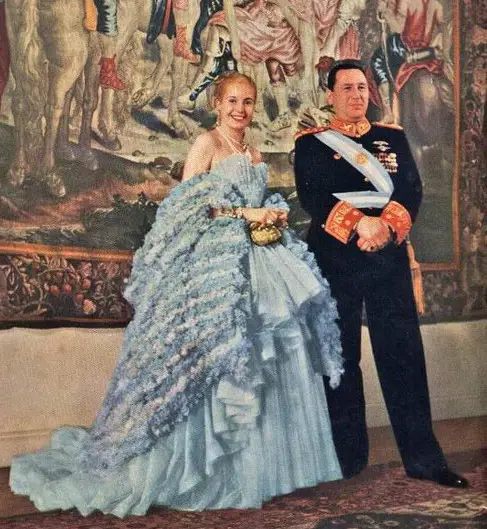
Evita and Juan Perón in 1947 (Wiki Image).

An estimated two million people gathered in 1951 to support the Juan Perón–Eva Perón ticket (Wiki Image).

Nearly 3 million people attended Evita’s funeral in the streets of Buenos Aires (Wiki Image).
Eva Perón and Juan Perón’s relationship was a powerful force in Argentine politics, blending passionate love with a shared ambition to uplift the working class and transform their nation. Here are ten quotes that offer a glimpse into their connection and its impact:
From Eva Perón:
- “I knew that for Perón, as for me, the people were everything.” – This reveals their shared dedication to serving the Argentine people, a cornerstone of their political and personal bond.
- “I chose the right man. I know that beside Perón I will be able to give the people all that I have promised them.” – Eva recognized Juan Perón as a partner who shared her vision and would enable her to fulfill her promises to the people.
- “I would have given my life to have him with me, but I would have given my life a thousand times to keep him with the people.” – This powerful statement highlights Eva’s selfless dedication to both Juan and the Argentine people, placing their needs above her own desires.
- “When Perón died, the world was with me. But when I died, Perón was alone.” – This poignant reflection underscores the profound impact of their partnership and the sense of loss she anticipated upon her death.
- “I may not have a college degree, but I have a doctorate in humanity.” – Eva’s words emphasize her connection to the people and her understanding of their struggles, a key source of her influence and popularity.
From Juan Perón:
- “Eva was the soul of the people, and I was their body.” – This metaphor captures the essence of their partnership, with Eva representing the emotional connection to the masses and Juan embodying the political power to enact change.
- “I have lost not only a wife but a collaborator and an irreplaceable friend.” – Juan Perón’s words upon Eva’s death express the profound loss he experienced, both personally and politically.
- “Eva Perón was the spiritual leader of our nation.” – This statement acknowledges Eva’s unique ability to inspire and mobilize the Argentine people, transcending her official role as First Lady.
Together:
- “Together, we will build a new Argentina.” – This shared vision of a more just and equitable society fueled their political ambitions and strengthened their bond.
- “Our love for each other was a reflection of our love for the people.” – This quote highlights the interconnectedness of their personal and political lives; their love for each other intertwined with their dedication to serving the Argentine people.
| Year | Age (Eva) | Age (Juan) | Event | Significance |
|---|---|---|---|---|
| 1944 | 25 | 48 | Meet at a charity event for earthquake victims | Eva, a rising actress, and Juan, a powerful colonel, are drawn to each other despite their different backgrounds. |
| 1945 | 26 | 49 | Begin living together | Their relationship deepens, and they become inseparable, both personally and politically. |
| 1945 | 26 | 49 | Juan Perón is imprisoned | Eva rallies support for his release, demonstrating her growing political influence and solidifying their bond. |
| 1945 | 26 | 49 | Marry in a civil ceremony | They officially marry, formalizing their partnership. |
| 1946 | 27 | 50 | Juan Perón is elected President of Argentina | Eva becomes First Lady, using her position to advocate for the poor and working class. |
| 1947-1951 | 28-32 | 51-56 | Eva’s “Rainbow Tour” of Europe | She travels to Europe, meeting with world leaders and promoting Argentina and Peronism. |
| 1947 | 28 | 51 | Eva establishes the Eva Perón Foundation | The foundation provides social assistance, healthcare, and education to the less fortunate, further increasing Eva’s popularity. |
| 1949 | 30 | 54 | Eva helps secure women’s suffrage in Argentina | Her advocacy leads to women gaining the right to vote, a landmark achievement. |
| 1951 | 32 | 56 | Eva is diagnosed with cervical cancer | Her health deteriorates, but she continues her political and social work. |
| 1952 | 33 | 57 | Eva declines the vice-presidential nomination | Facing pressure from the military and her declining health, she chooses not to run for vice president. |
| 1952 | 33 | 57 | Eva dies from cancer | Her death triggers national mourning and solidifies her status as a legendary figure in Argentina. |
Eva Peron – Former First Lady of Argentina | Mini Bio | BIO
Evita and Juan Perón: Argentina’s Power Couple
Peron & Eva Campaigning (1940)
(YouTube video)
Eva Perón and Juan Perón are iconic figures in Argentine history, renowned not only for their political roles but also for their passionate love story that transcended the ordinary boundaries of romance and became a symbol of devotion and dedication to their country. Their relationship began in the early 1940s when Juan Perón was an emerging political figure and Eva, then known as Eva Duarte, was an actress seeking to establish herself in Buenos Aires. They met at a charity event in 1944, where their instant chemistry sparked a partnership that would soon grow beyond personal attraction to a powerful political alliance.
Eva’s early life was marked by struggles and a desire for recognition, having grown up in a poor family in the rural province of Buenos Aires. Her journey to stardom in the entertainment industry shaped her worldview and fueled her ambition. After meeting Juan, Eva became increasingly involved in his political career. Their shared commitment to social justice and improving the lives of the working class resonated deeply with the Argentine populace. Their union was a romantic partnership and a merger of their aspirations, as both were driven by a desire to create a more equitable society in Argentina.
Their marriage in 1945 marked the beginning of a transformative era for Juan and Eva. Following their wedding, Juan Perón was elected president of Argentina, and Eva quickly emerged as a significant figure in her own right. She advocated for labor rights, women’s suffrage, and social welfare programs. Her passion for the marginalized and dedication to the working class endeared her to the Argentine people, earning her the affectionate title “Evita.” Juan, recognizing her influence and charisma, encouraged Eva to take on an active political role, enabling her to channel her passion for social change into tangible initiatives.
Eva’s work as First Lady transformed the role of women in Argentine society. She actively campaigned for women’s rights, leading to the passage of women’s suffrage in 1947. Eva Perón became a trailblazer through her efforts, championing education, healthcare, and labor rights. She established the Eva Perón Foundation, which provided social services, food, and financial assistance to the needy, significantly improving the lives of countless Argentines. Her dedication to the poor and her ability to connect with the masses reinforced her husband’s political position, creating a powerful dynamic between the two.
Despite their political successes, the Peróns faced significant challenges, including military and elite opposition: their leftist policies and commitment to social justice generated controversy, leading to a tumultuous political landscape. In 1955, a military coup ousted Juan Perón from power, forcing him into exile. During this time, Eva steadfastly supported her husband, using her public persona to rally support for their political cause. Her unwavering loyalty and determination to continue their shared vision symbolized their deep love and partnership, even in adversity.
Eva’s health began to decline in the early 1950s due to cancer, yet she continued to work tirelessly for her causes, even as her condition worsened. Juan Perón’s return to Argentina in 1973 after years of exile was celebrated, but it was also a bittersweet reunion, as Eva had passed away in 1952 at 33. Her death was a profound loss for Juan, who had been deeply affected by her passing. In his sorrow, he honored her legacy and continued to advocate for the social reforms they had championed together, ensuring that her impact would be felt long after her death.
The love story of Eva and Juan Perón remains a poignant narrative in Argentine history. Their partnership, characterized by mutual support, shared ambitions, and a commitment to social justice, resonates with many as a testament to the power of love in political life. Even today, Eva Perón is revered as a symbol of hope and empowerment, inspiring generations of Argentines and women worldwide. Her legacy as a feminist icon and advocate for the oppressed continues to influence social movements, while Juan Perón’s political philosophy shaped the trajectory of Argentine politics for decades.
In the years since their deaths, the Peróns’ influence has endured, and their love story has become an integral part of Argentine cultural identity. Eva’s life and contributions have been immortalized in various forms, from books and films to musicals, capturing the essence of her spirit and her partnership with Juan. The duality of their love and political aspirations remains a source of fascination and admiration, reminding us of the complexities and intricacies of human relationships within the realm of power and politics. The Peróns’ story is a vivid reminder of how love can inspire change and how the bonds between individuals can shape history.
Elizabeth Barrett Browning and Robert Browning Lovers (United Kingdom)
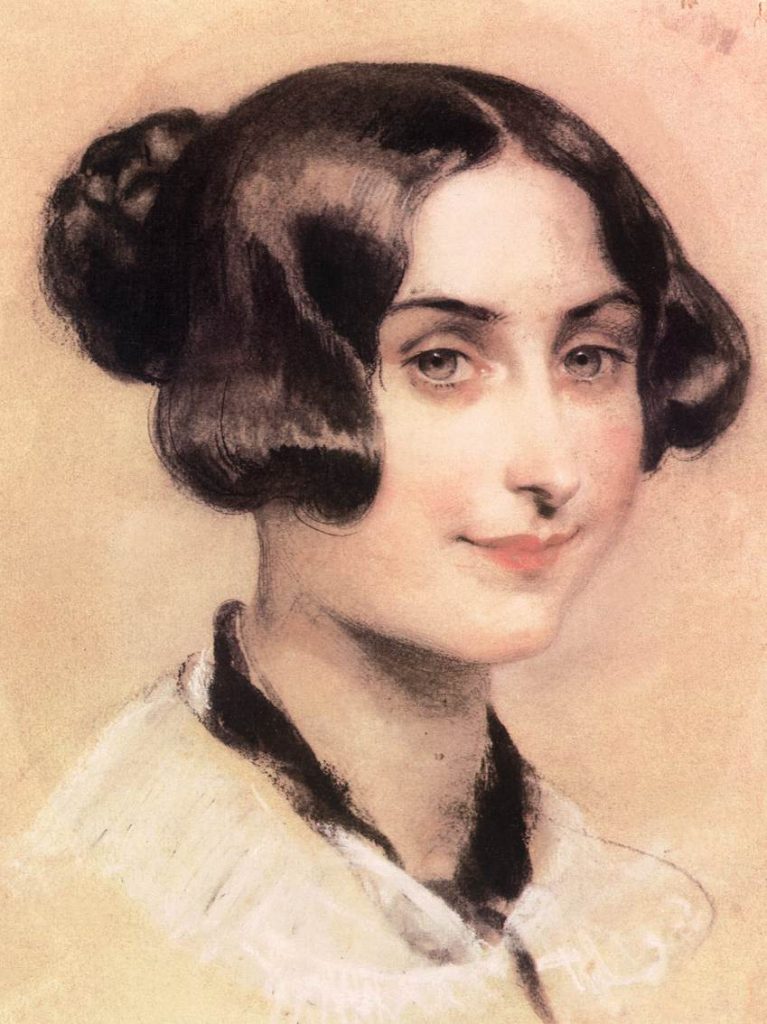
Portrait of Elizabeth Barrett by Károly Brocky, c. 1839–1844 (Wiki Image).
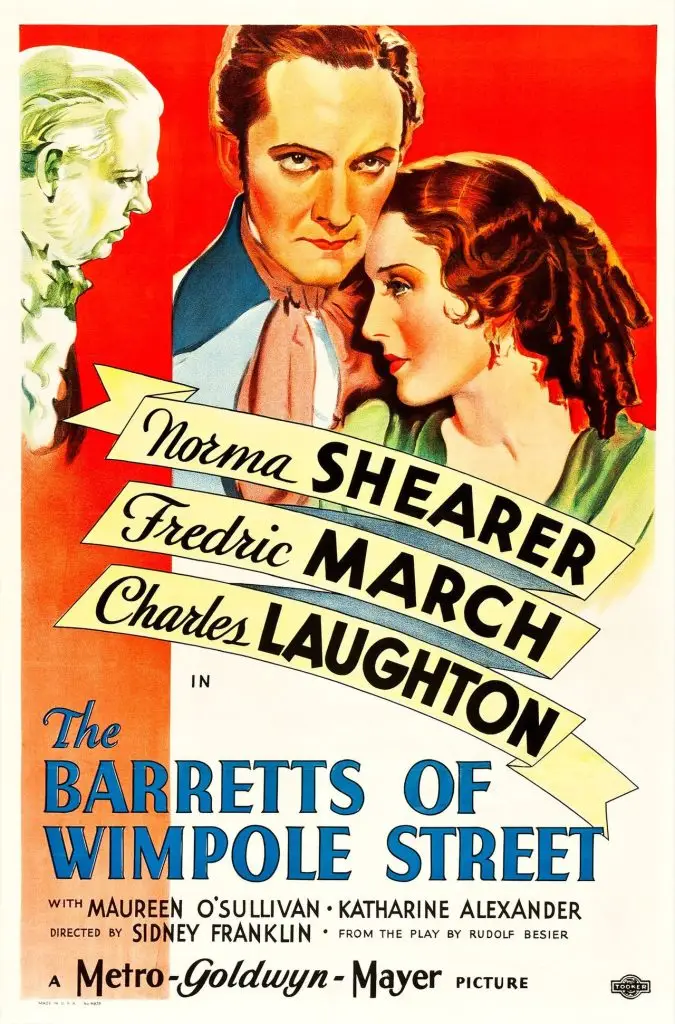
It depicts the real-life romance between poets Elizabeth Barrett (Norma Shearer) and Robert Browning (Fredric March), despite the opposition of her abusive father, Edward Moulton-Barrett (Charles Laughton) (Wiki Image).
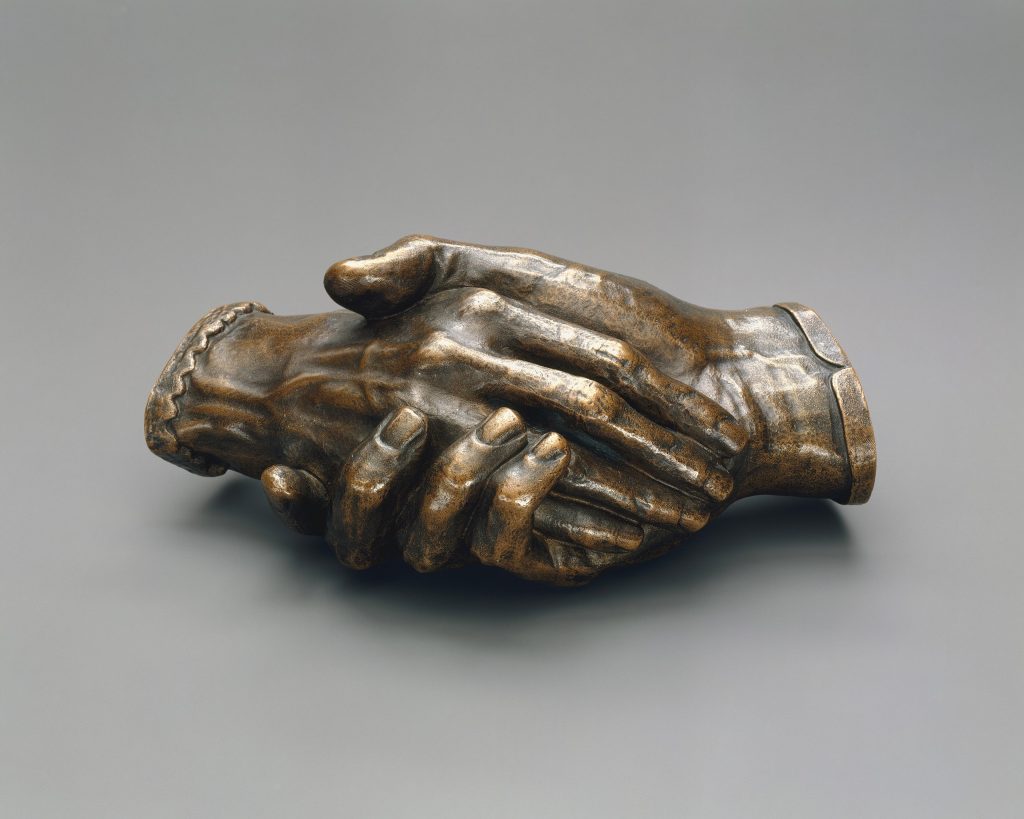
Clasped Hands of Robert and Elizabeth Barrett Browning, 1853 by Harriet Hosmer (Wiki Image).
Ah, the Brownings! Their love story is one for the ages, a testament to the power of passion, poetry, and unwavering support. Here are ten quotes that capture the essence of their enduring bond:
From Elizabeth Barrett Browning:
- “How do I love thee? Let me count the ways.” – This iconic line from her sonnet sequence Sonnets from the Portuguese perfectly encapsulates the boundless nature of her love for Robert.
- “I love thee to the depth and breadth and height my soul can reach.” – Another beautiful expression of her all-encompassing love, highlighting the depth and intensity of her feelings.
- “You have touched me more profoundly than I thought even you could have touched me – my heart was full when you came here today. Henceforward, I am yours for everything.” – This reveals the transformative power of their love and how Robert unlocked depths within Elizabeth she hadn’t known existed.
- “My future will not copy fair my past—on any leaf but thine.” – With Robert, she found a new beginning, a fresh start filled with love and possibility.
- “If thou must love me, let it be for nought except for love’s sake only.” – Elizabeth desired to be loved for who she was, not for any external factors or expectations.
From Robert Browning:
- “I love your verses with all my heart, dear Miss Barrett,—and this is no off-hand complimentary letter that I shall write,—whatever else, no prompt matter-of-course recognition of your genius…” – Robert’s genuine admiration for Elizabeth’s poetry was evident from the beginning, forming a key part of their connection.
- “I would give up all fame and success… to have you beside me.” – This reveals the depth of his love for Elizabeth, prioritizing her above all else, including his own artistic ambitions.
- “You are my religion.” – Robert saw Elizabeth as a source of inspiration and spiritual fulfillment, elevating her to a sacred level in his life.
Together:
- “What is genius but the power of expressing a new individuality?” – This quote from Elizabeth reflects their shared belief in the importance of individual expression and artistic freedom, which nurtured their creative partnership.
- “Love that endures, from life that disappears!” – This line from one of Robert’s poems speaks to the enduring nature of their love, transcending even death itself.
| Year | Age (Elizabeth) | Age (Robert) | Event | Significance |
|---|---|---|---|---|
| 1845 | 39 | 33 | Robert writes to Elizabeth | Impressed by her poetry, Robert sends a letter expressing his admiration. This begins their fervent correspondence. |
| 1845-1846 | 39-40 | 33-34 | Courtship through letters | They exchange hundreds of letters, discussing poetry, literature, and their deepening feelings for each other. |
| 1846 | 40 | 34 | First meeting | Despite Elizabeth’s poor health and reclusive lifestyle, they meet in person and their connection intensifies. |
| 1846 | 40 | 34 | Secret Marriage | They elope and marry in secret, defying Elizabeth’s controlling father. |
| 1846 | 40 | 34 | Escape to Italy | The newlyweds flee to Italy to escape her father’s wrath and start a new life together. |
| 1846-1861 | 40-55 | 34-49 | Life in Italy | They live in Florence and Rome, enjoying artistic and intellectual freedom. Their love and shared experiences inspire their poetry. |
| 1849 | 43 | 37 | Birth of their son, Robert Wiedemann Barrett Browning (“Pen”) | The birth of their son brings them great joy. |
| 1850s | 40s | 30s-40s | Continued literary success | Both continue to write and publish, achieving critical acclaim and recognition. |
| 1861 | 55 | 49 | Elizabeth dies in Florence | Robert is devastated by her loss. |
| 1861-1889 | – | 49-77 | Robert raises their son and continues writing | He dedicates himself to preserving Elizabeth’s legacy and promoting her work. |
How Do I Love Thee?
How do I love thee? Let me count the ways.
I love thee to the depth and breadth and height
My soul can reach, when feeling out of sight
For the ends of being and ideal grace.
I love thee to the level of every day’s
Most quiet need, by sun and candle-light.
I love thee freely, as men strive for right.
I love thee purely, as they turn from praise.
I love thee with the passion put to use
In my old griefs, and with my childhood’s faith.
I love thee with a love I seemed to lose
With my lost saints. I love thee with the breath,
Smiles, tears, of all my life; and, if God choose,
I shall but love thee better after death.
How Do I Love Thee? (Sonnet 43) by Elizabeth Barrett …
Robert Browning and Elizabeth Barrett Browning
Robert and Elizabeth Browning
The life and work of Elizabeth Barrett Browning
(YouTube video)
Elizabeth Barrett Browning and Robert Browning are celebrated as one of literature’s most passionate couples, whose love story has captivated readers for generations. Their relationship began in the mid-19th century when Elizabeth was already an established poet known for her work in the Victorian literary scene. Stricken by illness and confined to her father’s home, Elizabeth led a reclusive life, yet her intellect and creativity flourished. In 1845, Robert, a young poet and admirer of Elizabeth’s work, sent her a letter complimenting her poetry. This initial correspondence blossomed into a deep and transformative love.
The letters exchanged between Elizabeth and Robert reveal a profound emotional connection that transcends societal norms. Elizabeth, who was 39 then, was deeply touched by Robert’s admiration and affection for her work. Their correspondence quickly evolved into a passionate romance, with Robert often expressing his admiration for Elizabeth’s intellect, beauty, and spirit. Elizabeth, in turn, found solace and inspiration in Robert’s unwavering support and love. Their literary exchanges served as a means of communication and a creative partnership, enriching their artistic pursuits.
Despite the challenges posed by Elizabeth’s strict upbringing and her father’s disapproval of her romantic relationships, the couple’s love persevered. Elizabeth’s father, a domineering figure, forbade his children from marrying, which posed a significant obstacle to their union. In defiance of this, Elizabeth and Robert decided to elope, showcasing the depth of their commitment to one another. They secretly married on September 12, 1846, in a small ceremony in London. This bold act of love represented a significant turning point in their lives, allowing them to embrace their future together as equals.
After their marriage, Elizabeth and Robert settled in Italy, where they found the freedom and inspiration to pursue their artistic ambitions—their time in Florence proved to be a fertile period for both poets. Elizabeth’s health, which had been frail for much of her life, improved significantly in the Italian climate. Here, she wrote some of her most acclaimed works, including Sonnets from the Portuguese, a collection of 44 love sonnets dedicated to Robert. These poems eloquently express her passionate feelings and the transformative power of love, showcasing the intensity of their relationship.
Robert Browning, in turn, was inspired by Elizabeth’s work and persona, and his writings began to reflect their deep bond. He became more involved in the literary scene, advocating for Elizabeth’s poetry and ensuring her voice was heard. The couple often discussed literature and shared their insights, creating a unique intellectual partnership. Their mutual respect and admiration fueled their creativity, creating an extraordinary work that resonates with readers today.
The couple’s relationship was not without its challenges, however. Elizabeth’s health issues persisted throughout her life, and she faced periods of debilitating illness that would later take a toll on her well-being. Robert was a devoted partner, caring for her and encouraging her to pursue her passion for writing despite her struggles. Their unwavering support for one another is a testament to their profound love, which endured the trials of life and illness. Elizabeth’s poems often reflect her vulnerability and longing, revealing the complexities of her emotional state as she navigated her health challenges.
Tragically, Elizabeth Barrett Browning passed away in 1861 at the age of 55, leaving Robert heartbroken. Her death marked the end of a remarkable chapter in both their lives, and Robert mourned her deeply, often referencing her in his later works. The depth of his love for Elizabeth was evident in the way he continued to honor her legacy, championing her poetry and preserving her memory. Their love story, marked by its intensity and creativity, has inspired countless artists and writers, symbolizing love’s power to transcend time and adversity.
Today, Elizabeth Barrett Browning and Robert Browning are remembered for their contributions to literature and their enduring love story. Their correspondence, poetry, and unwavering support for one another resonate with readers, inspiring new generations to explore the depths of romantic and creative partnerships. The legacy of their love, encapsulated in Elizabeth’s sonnets and Robert’s enduring praise, remains a poignant reminder of the profound connections between the two souls. Their story is a testament to the transformative power of love and its lasting impact on individuals and the world around them.
Yang Guifei and Emperor Xuanzong Lovers (China)
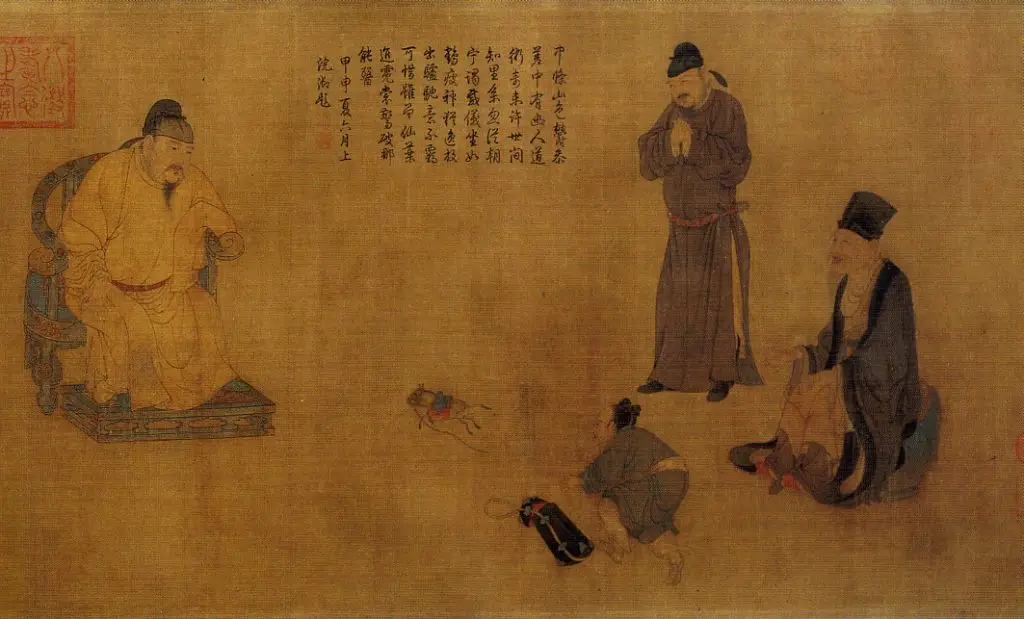
Emperor Xuanzong gave the audience to Zhang Guo by Renfa (1254–1327) (Wiki Image).
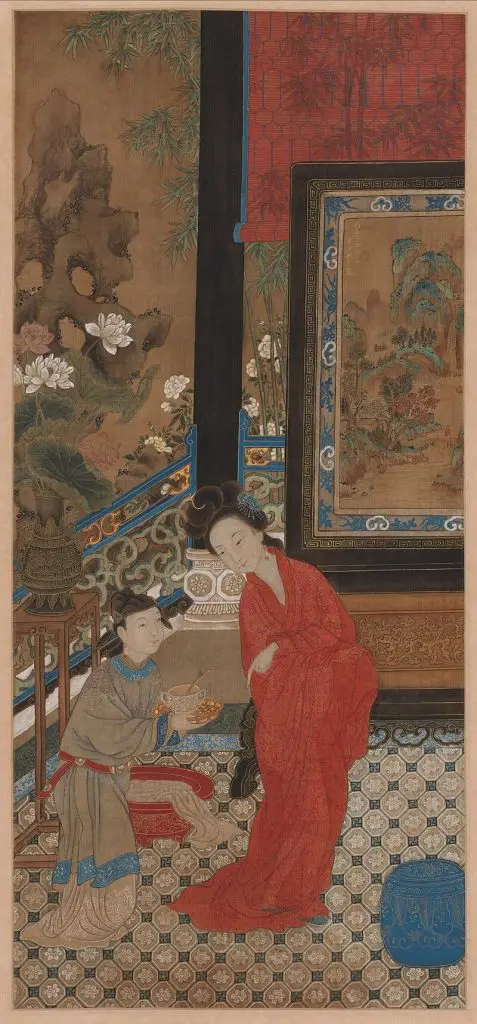
Yang Guifei Leaving the Bath by Gu Jianlong (1606–after 1689) (Wiki Image).
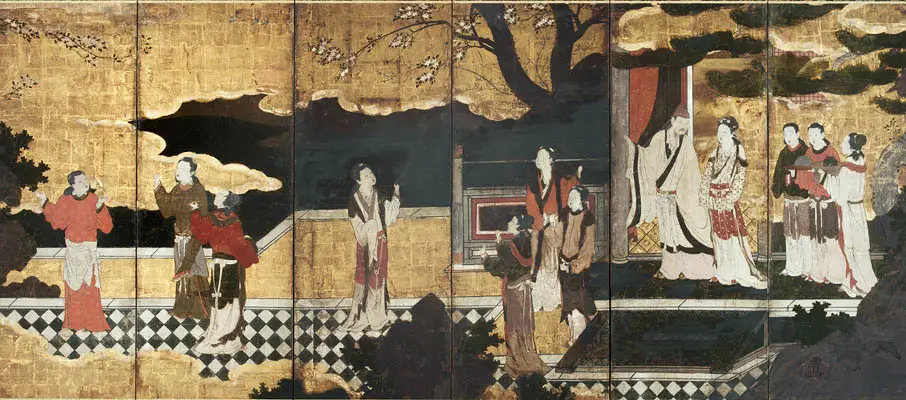
Xuanzong with Consort Yang on a terrace with their attendants, by Japanese artist Kanō Eitoku (1543–1590) (Wiki Image).
The love story of Yang Guifei and Emperor Xuanzong of Tang is a legendary tale of passion, beauty, and tragedy. While filled with romance and extravagance, their relationship ultimately contributed to political turmoil and a devastating rebellion. Here are ten quotes that capture the essence of their love and its consequences:
From Emperor Xuanzong:
- “When she turned her head, her glance was like lightning. When she lowered her head, her shoulders were like cut jade.” – This poetic description conveys the Emperor’s infatuation with Yang Guifei’s beauty and grace.
- “One glance at her was enough to captivate the whole kingdom.” – The Emperor recognized the power of Yang Guifei’s beauty and ability to enchant all who beheld her.
- “My heart is filled with sorrow, and I cannot bear to part with you.” – These words, spoken as the Emperor was forced to have Yang Guifei executed, reveal his deep affection for her despite the tragic circumstances.
- “The heavens weep for our love, and the earth mourns our separation.” – This poetic lament expresses the Emperor’s grief and the magnitude of their loss.
- “Her laughter was like the music of heaven, and her dance was like the swaying of willows in the breeze.” – The Emperor cherished Yang Guifei’s artistic talents and the joy she brought to his life.
From Yang Guifei (attributed or inspired by her story):
- “The beauty of a woman is a treasure beyond price.” – This quote reflects Yang Guifei’s awareness of her own beauty and its power to captivate and influence.
- “My love for the Emperor is as deep as the sea and as boundless as the sky.” – These words express the intensity of her affection for Xuanzong and the all-encompassing nature of their love.
- “I would rather die than be separated from you.” – This declaration of devotion highlights Yang Guifei’s willingness to sacrifice everything for her love for the Emperor.
About their relationship:
- “Their love was like a flame, burning brightly but destined to consume all that it touched.” This metaphor captures their relationship’s passionate but ultimately destructive nature.
- “The story of Yang Guifei and Emperor Xuanzong is a cautionary tale of love and power, a reminder that even the most powerful rulers can be undone by their passions.” – This observation reflects the historical consequences of their love affair and its impact on the Tang Dynasty.
| Year | Age (Yang Guifei) | Age (Emperor Xuanzong) | Event | Significance |
|---|---|---|---|---|
| 734 | ~15 | 60 | First encounter at a royal feast | Yang Guifei, originally married to the emperor’s son, catches the eye of Emperor Xuanzong with her beauty and grace. |
| 735 | ~16 | 61 | Enters the imperial palace as a Taoist nun | To circumvent social conventions, Yang Guifei becomes a Taoist nun, allowing her to be closer to the emperor. |
| 740 | ~21 | 66 | Officially becomes an imperial consort | Xuanzong elevates Yang Guifei to the highest consort rank, demonstrating his deep affection for her. |
| 740s | 20s | 60s | Years of favor and influence | Yang Guifei’s family gains prominence, and she exerts considerable influence in the imperial court. |
| 745 | ~26 | 71 | An Lushan is introduced to the court | The general An Lushan becomes a favored figure, and rumors of a close relationship with Yang Guifei arise. |
| 750s | 30s | 70s | Growing political unrest and extravagance | The emperor’s favoritism towards Yang Guifei and her family leads to resentment and instability within the court. |
| 755 | ~36 | 81 | An Lushan Rebellion begins | The rebellion, partly fueled by resentment towards Yang Guifei’s family, throws the Tang Dynasty into chaos. |
| 756 | ~37 | 82 | Flight from the capital Chang’an | The emperor and his court flee the capital as rebels advance. |
| 756 | ~37 | 82 | Yang Guifei is executed at Mawei | Blamed for the rebellion and pressured by his guards, the emperor reluctantly orders Yang Guifei’s death. |
The Woman Who DESTROYED an Empire With her Beauty …
Extravagant “Short” Life of China’s Consort- Yang Guifei | Four …
[MULTI SUB]Full Movie《Yang Guifei》|fantasy|Original version …
(YouTube video)
Yang Guifei and Emperor Xuanzong of the Tang Dynasty are one of the most celebrated romantic pairs in Chinese history, their love story intricately woven into the fabric of Tang culture and literature. Their relationship began in the mid-8th century when Yang Guifei, originally named Yang Yuhuan, caught the eye of the emperor. Yang, known for her extraordinary beauty and artistic talent, quickly rose to prominence at the imperial court. Her enchanting presence and graceful demeanor captivated Emperor Xuanzong, known for his passion for art and music, leading to a profound and passionate love affair.
Yang Guifei was born into a prominent family, and her marriage to the emperor elevated her status from a court dancer to a favored consort. Emperor Xuanzong, who ruled from 712 to 756, was enchanted by her beauty and intellect, leading him to shower her with gifts and favors. She became the emperor’s primary consort, enjoying a life of luxury and influence. The couple’s love was not merely personal; it had significant political implications, as Yang Guifei wielded considerable power within the court, often influencing decisions and policies during Xuanzong’s reign.
As their relationship deepened, Yang Guifei’s influence over Emperor Xuanzong grew. She symbolized beauty and grace in the Tang Dynasty, inspiring countless poems, songs, and artistic works that celebrated their love. The emperor’s affection for Yang Guifei led him to prioritize her happiness, often at the expense of state affairs. This devotion fostered a golden age for the arts and culture in the Tang Dynasty, as Xuanzong encouraged poets, musicians, and artists to flourish under his reign, using his love for Yang as a muse.
However, their romance was challenging. The power dynamics at the court were complex, with Yang Guifei facing jealousy and resentment from other members of the imperial family and court officials. The political landscape became increasingly tumultuous, culminating in the An Lushan Rebellion in 755, which posed a severe threat to the stability of the Tang Dynasty. This rebellion was fueled by social unrest and dissatisfaction with the emperor’s policies, exacerbated by the favoritism shown toward Yang Guifei. The love story that once flourished under the golden light of the palace was soon overshadowed by impending doom.
Emperor Xuanzong fled the capital with Yang Guifei when the rebellion broke out, but their escape marked a turning point in their relationship. The emperor faced immense pressure from his advisors and military leaders to abandon Yang, whom they viewed as a source of misfortune. In the face of mounting blame and chaos, Xuanzong made the heart-wrenching decision to sacrifice his beloved Yang Guifei to restore order. She was accused of having brought misfortune to the emperor and the kingdom, and he ordered her death to appease the military leaders and save his reign.
The tragic execution of Yang Guifei is one of the most poignant moments in Chinese literature and history, symbolizing the clash between love and duty. Xuanzong’s heartache over Yang’s death was profound, and he spent the remainder of his reign mourning her loss. The story of their love became a legend, immortalized in poems and plays highlighting their relationship’s beauty and tragedy. Xuanzong’s sorrow and guilt over Yang’s death underscored the emotional depth of their bond, showcasing the human cost of political machinations.
Yang Guifei’s legacy endured in the following years, symbolizing idealized beauty and tragic love in Chinese culture. Poets, scholars, and artists drew inspiration from their stories, crafting works that reflected love, loss, and longing themes. The famed poet Bai Juyi immortalized their love in his poem “Song of Everlasting Regret,” which vividly recounts their romance and the subsequent tragedy of Yang Guifei’s death. This poem has become one of the most beloved works in Chinese literature, echoing the sentiments of countless lovers through the ages.
Today, Yang Guifei and Emperor Xuanzong remain iconic figures in Chinese history and literature, representing the complexities of love intertwined with power and politics. Their story serves as a reminder of the sacrifices made in the name of love and the impact of personal relationships on historical events. The allure of their romance continues to resonate, inspiring modern adaptations in literature, film, and other artistic expressions. The enduring legacy of Yang Guifei and Emperor Xuanzong is a testament to the timeless nature of love, beauty, and tragedy, etched into the annals of Chinese cultural memory.
Mumtaz Mahal and Shah Jahan Lovers (India)
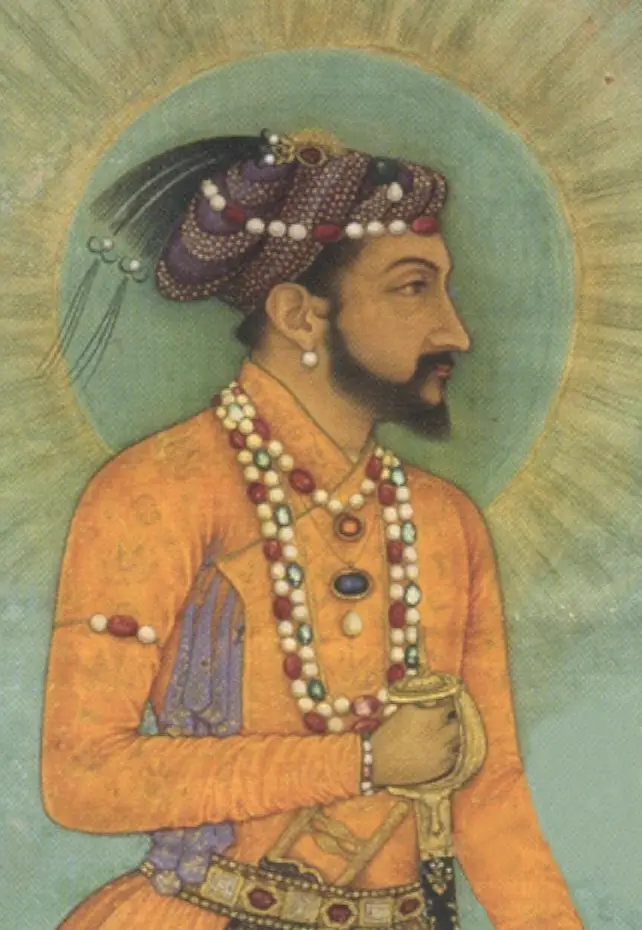
Shah Jahan I, Portrait by Bichitr, c. 1630 (Wiki Image).
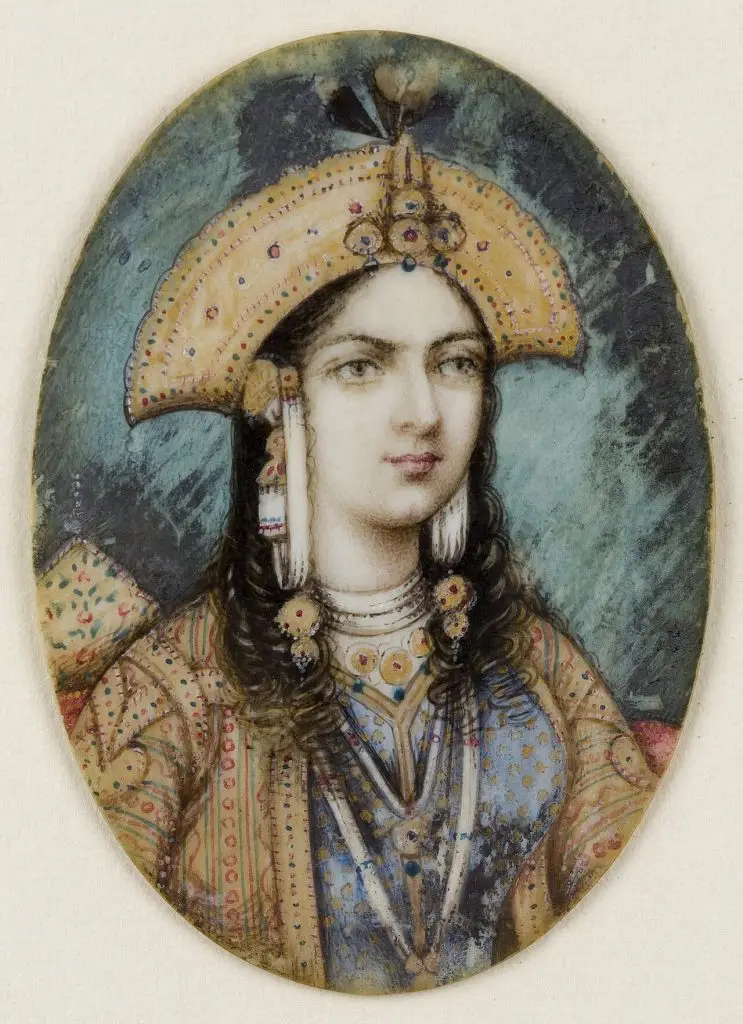
Portrait of Mumtaz Mahal on ivory, 17th‑century, held at the Lahore Museum in Lahore, Pakistan (Wiki Image).
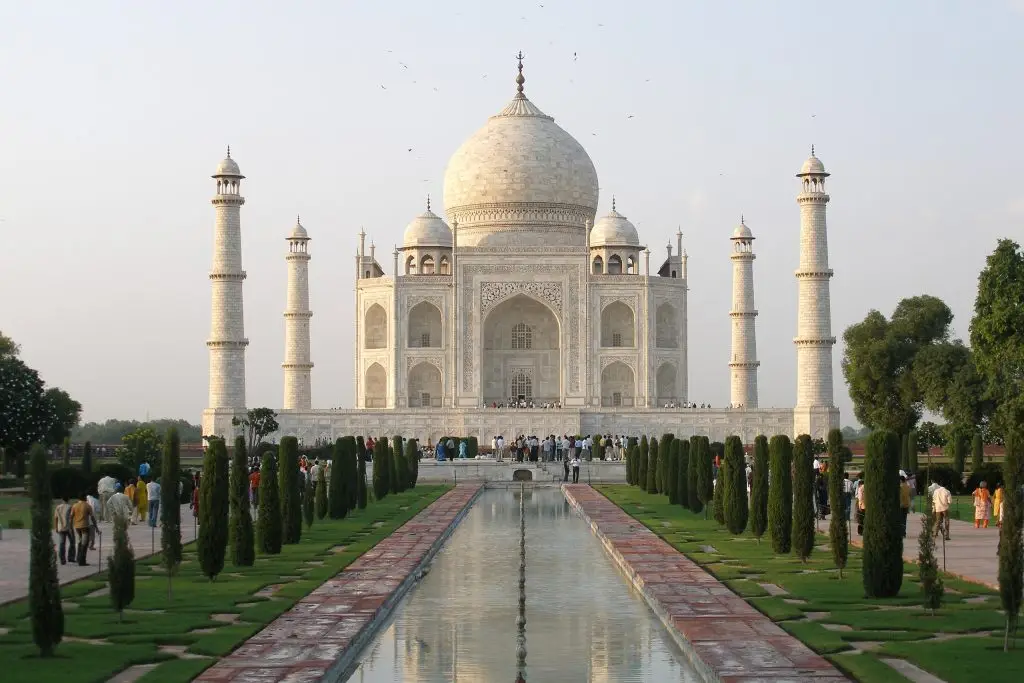
A UNESCO World Heritage Site, the Taj Mahal is the final resting place of Mumtaz Mahal and Shah Jahan (Wiki Image).
The love story of Mumtaz Mahal and Shah Jahan is one of the most legendary romances in history, immortalized in the breathtaking beauty of the Taj Mahal. Their deep connection, marked by devotion, passion, and tragedy, has captivated hearts and minds for centuries. Here are ten quotes that offer a glimpse into their enduring bond:
From Shah Jahan:
- “My love for her was such that I felt as if I had no power over my own spirit.” – This reveals the all-consuming nature of his love for Mumtaz Mahal, a force that transcended his earthly power and authority.
- “She was the perfect woman, a companion of my heart and a source of endless joy.” – Shah Jahan cherished Mumtaz Mahal’s companionship and the happiness she brought to his life.
- “When she died, my world crumbled, and I was left with an emptiness that could never be filled.” – Her death devastated him, leaving a void that no amount of power or wealth could fill.
- “I shall build a monument so magnificent that it will forever enshrine her memory and our love.” – This vow led to the creation of the Taj Mahal, a testament to his enduring grief and devotion.
- “The Taj Mahal is a teardrop on the cheek of time, a symbol of my eternal love for Mumtaz Mahal.” – This poetic description captures the essence of the monument and the emotions it embodies.
About Mumtaz Mahal:
- “Her beauty was such that it could illuminate the darkest night.” – Mumtaz Mahal’s captivating beauty was legendary, inspiring countless poems and artistic depictions.
- “She was a woman of grace, intelligence, and compassion, a true Empress in every sense of the word.” – Beyond her beauty, Mumtaz Mahal was admired for her character and her role as a trusted advisor to Shah Jahan.
- “Her love for Shah Jahan was as boundless as the sky and as deep as the ocean.” – Their love was a reciprocal and profound connection, a source of strength and solace for both.
About their love:
- “Their love was a beacon of light in a world of darkness, a testament to the enduring power of human connection.” – Their story continues to inspire and resonate, reminding us of the transformative power of love.
- “The Taj Mahal stands as a symbol of their eternal love, a monument that will forever inspire awe and wonder in all who behold it.” – Their love story, immortalized in the Taj Mahal, transcends time and culture, a testament to the enduring power of human connection.
| Year | Age (Mumtaz Mahal) | Age (Shah Jahan) | Event | Significance |
|---|---|---|---|---|
| 1607 | 14 | 15 | Betrothal | The young Prince Khurram (later Shah Jahan) is betrothed to Arjumand Banu Begum (later Mumtaz Mahal). |
| 1612 | 19 | 20 | Marriage | After a five-year engagement, they are married in a lavish ceremony. Shah Jahan is captivated by her beauty and character. |
| 1612-1631 | 19-38 | 20-39 | Years of devotion and companionship | Mumtaz Mahal becomes Shah Jahan’s most trusted confidante and accompanies him on military campaigns. |
| 1612-1631 | 19-38 | 20-39 | Birth of 14 children | Their relationship is blessed with many children, though only 7 survive infancy. |
| 1628 | 35 | 36 | Shah Jahan becomes Emperor | Mumtaz Mahal is bestowed the title “Mumtaz Mahal” (Chosen One of the Palace) and becomes Empress consort. |
| 1631 | 38 | 39 | Mumtaz Mahal dies in childbirth | While giving birth to their 14th child, Mumtaz Mahal dies. Shah Jahan is inconsolable. |
| 1631-1666 | – | 39-64 | Construction of the Taj Mahal | Shah Jahan commissions the Taj Mahal as a magnificent mausoleum for his beloved wife. |
The Taj Mahal Was Really Built for Love
17th June 1631: Mumtaz Mahal’s death prompts construction …
(YouTube video)
Mumtaz Mahal and Shah Jahan are renowned figures in Indian history. Their love story is immortalized through one of the most magnificent architectural marvels in the world, the Taj Mahal. Their romance blossomed during the early 17th century when Shah Jahan, then known as Prince Khurram, was captivated by the beauty and grace of Mumtaz Mahal, born Arjumand Banu Begum. Their union was a tale of passion and devotion, and it was a significant aspect of Mughal history, as their relationship symbolized the height of Mughal culture and artistic expression.
Shah Jahan and Mumtaz Mahal met in 1607 when she was just 14 years old and he was 15. The two were cousins, with Mumtaz being the daughter of a Persian nobleman. Their love blossomed over the years, culminating in a lavish wedding in 1612. Shah Jahan was deeply enamored with Mumtaz, often referring to her as his “jewel of the palace” (Mumtaz Mahal means “the chosen one of the palace”). Their relationship was characterized by mutual respect, affection, and a shared commitment, making them one of history’s most iconic couples.
As their love story unfolded, Mumtaz Mahal became Shah Jahan’s inseparable companion, accompanying him on military campaigns and public events. Despite being married to multiple wives, Mumtaz remained his favorite and was often seen as a partner in governance. Their bond deepened with the birth of their children, as they welcomed 14 children, including the famous princess Jahanara Begum. This growing family strengthened their connection, with Mumtaz playing a vital role in the Mughal court as a loving mother and trusted confidante.
Tragically, their idyllic life was disrupted by the death of Mumtaz Mahal during childbirth in 1631. Her passing left Shah Jahan devastated, plunging him into a deep state of mourning. He was inconsolable, reportedly refusing to participate in public affairs and neglecting his royal duties. His grief manifested in a profound sense of loss as he honored Mumtaz’s memory through artistic expression and introspection. This mourning period marked a significant turning point in Shah Jahan’s life as he sought to immortalize his love for Mumtaz in a lasting tribute.
In the wake of Mumtaz Mahal’s death, Shah Jahan embarked on constructing the Taj Mahal, a mausoleum that would become a symbol of eternal love and devotion. The design of the Taj Mahal was a collaboration between various artisans and architects, showcasing the exquisite beauty of Mughal architecture. Constructed with white marble and adorned with intricate carvings and inlay work, the Taj Mahal reflects both the grandeur of the Mughal Empire and the depth of Shah Jahan’s love for his beloved wife. The structure took over 20 years, with the emperor pouring his heart and soul into its creation.
The Taj Mahal is a testament to Shah Jahan’s and Mumtaz Mahal’s love, drawing millions of worldwide visitors. The structure’s symmetry, beauty, and the romantic tale behind its construction have made it one of the most recognizable monuments globally. Shah Jahan’s commitment to honoring Mumtaz’s memory through this architectural masterpiece speaks volumes about the enduring nature of their love. The Taj Mahal is not merely a tomb but a symbol of the profound bond shared between the two, encapsulating the ideals of love, loss, and remembrance.
As the years passed, Shah Jahan’s health began to decline, and he faced political challenges within the empire. In 1657, a power struggle ensued among his sons, leading to a civil war over succession. Eventually, Shah Jahan was overthrown by his son Aurangzeb, who imprisoned him in Agra Fort. Even in captivity, Shah Jahan spent his days gazing at the Taj Mahal, reminiscing about his beloved Mumtaz Mahal. His imprisonment marked a poignant end to his life, yet his love for Mumtaz continued to resonate within the walls of the Taj Mahal.
Today, Mumtaz Mahal and Shah Jahan’s love story is celebrated for its romantic elements and historical significance. Their relationship epitomizes the cultural richness of the Mughal Empire, highlighting the intersection of love, art, and architecture. The Taj Mahal serves as a reminder of the timeless nature of love and the lengths one may go to honor and remember a cherished partner. Their enduring legacy continues to inspire generations, illustrating the power of love to transcend time and leave an indelible mark on history.
Gertrude Stein and Alice B. Toklas Lovers (United States/France)
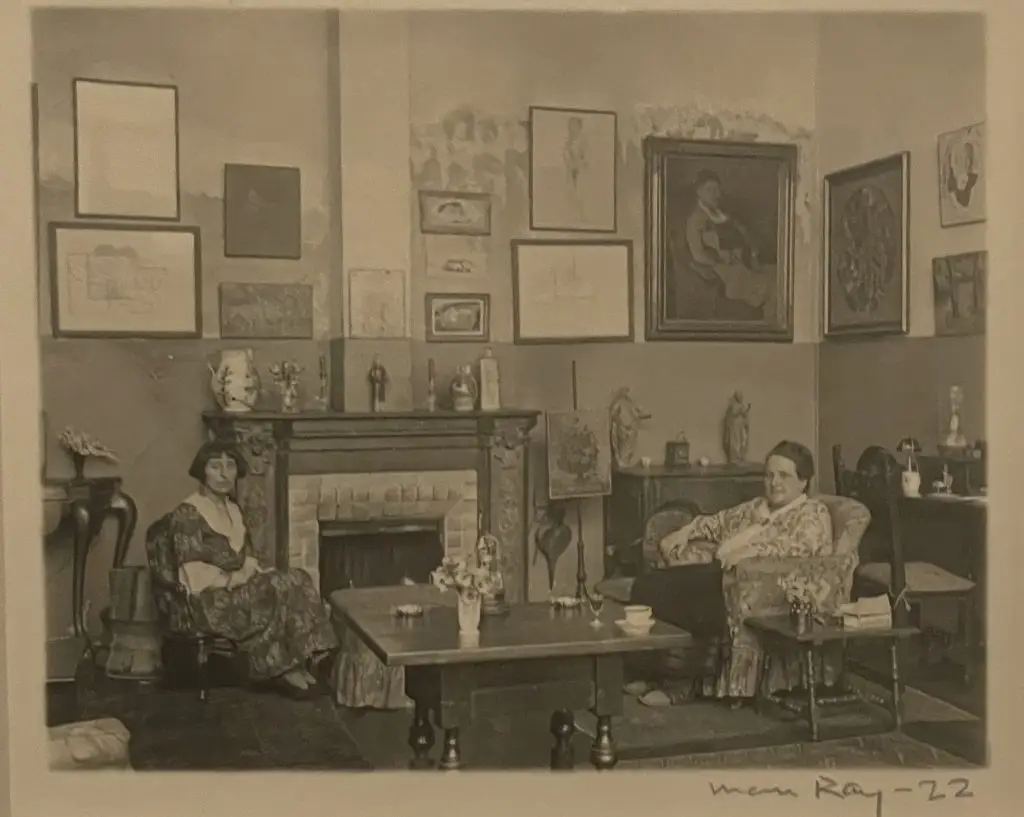
Alice B. Toklas and Gertrude Stein (1922) by Man Ray (Wiki Image).
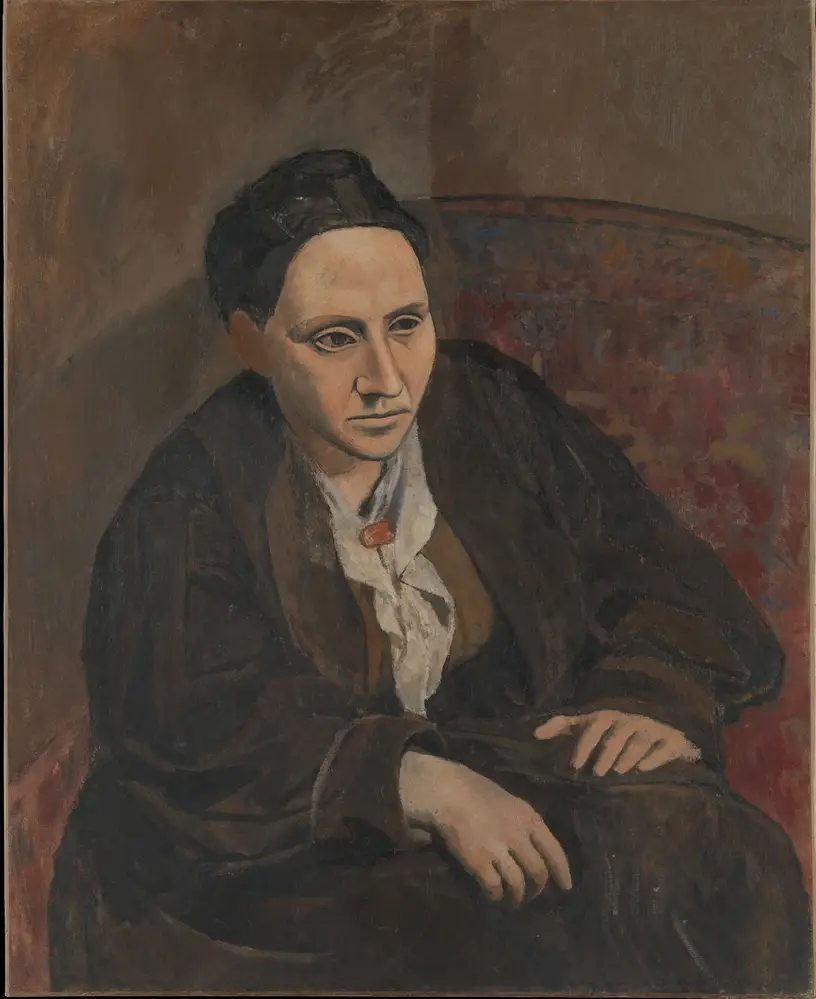
Pablo Picasso, Portrait of Gertrude Stein, 1906, Metropolitan Museum of Art, New York. When someone commented that Stein didn’t look like her portrait, Picasso replied, “She will.” Stein wrote “If I Told Him: A Completed Portrait of Picasso” (1923) in response to the painting (Wiki Image).
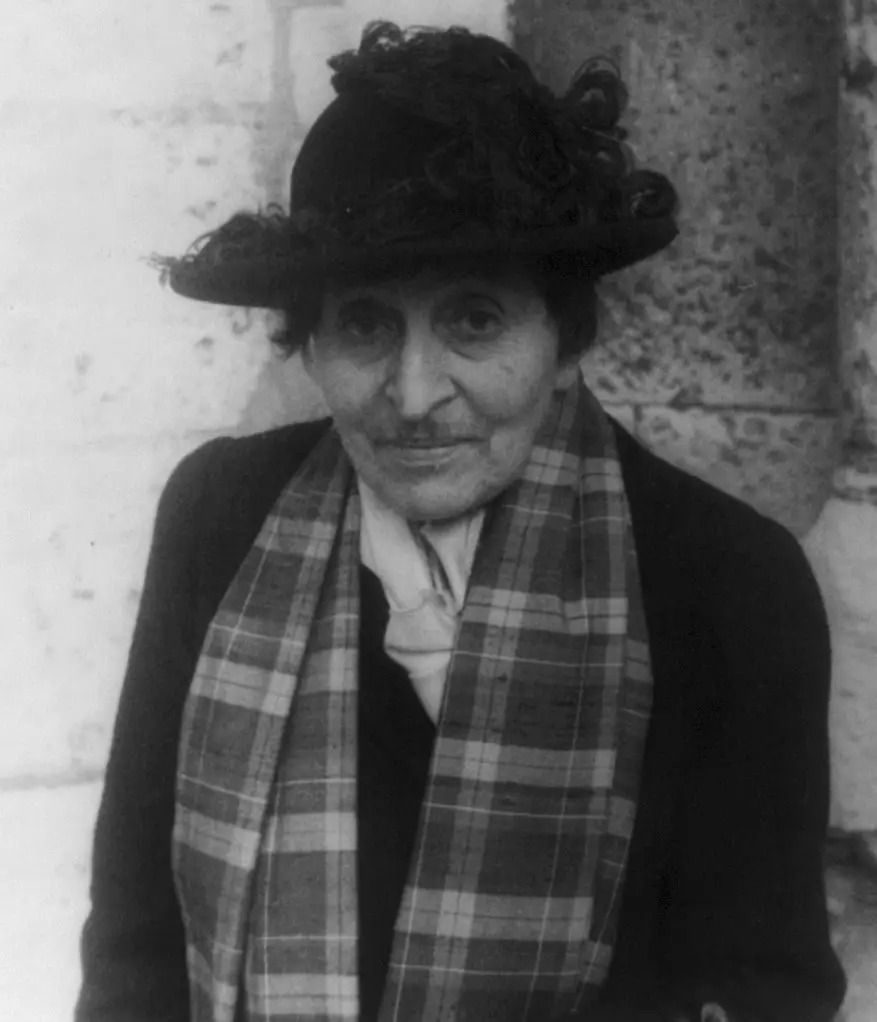
Toklas, photographed by Carl Van Vechten, 1949 (Wiki Image).
Gertrude Stein and Alice B. Toklas were pioneers of modernism and lesbian life in the 20th century. Their Parisian salon was legendary, and their love for each other was a constant throughout their lives. Here are ten quotes that give us a glimpse into their enduring bond:
From Gertrude Stein:
- “I love my love with a b because she is peculiar.” – This playful line from a poem captures Stein’s affection for Toklas’ unique personality.
- “Alice B. Toklas was the perfect audience.” – Stein recognized Toklas’ unwavering support and appreciation for her work, valuing her as her ideal reader and confidante.
- “When you live with another person, their life is as present as your own.” – This quote reflects the deep intimacy and intertwined lives they shared, their individual experiences inseparable from their partnership.
- “I write for myself and strangers.” – While this might seem impersonal, it also highlights the importance of Toklas as her constant companion and “known” audience, contrasting with the unknown “strangers.”
- “There is no there there.” – This famous line from Stein’s writing could also be interpreted as a reflection of their unconventional life together, defying traditional expectations and creating their own “there.”
From Alice B. Toklas:
- “I always say that you cannot tell what a picture really is or what an object really is until you dust it every day, and you cannot tell what a book is until you type it or proofread it.” – This quote from Toklas’ autobiography highlights her practical and meticulous nature, which complemented Stein’s creative spirit.
- “She was a golden brown presence, burned by the Tuscan sun and with a golden glint in her warm brown hair.” – Toklas’ description of their first meeting captures her immediate attraction to Stein’s vibrant personality.
- “Loving repeating being doing.” – This concise phrase from Toklas’ writing reflects the essence of their shared life, filled with love, repetition, and creative pursuits.
About their relationship:
- “Their salon was a crucible of modernism, where artists and writers gathered to exchange ideas and challenge conventions.” – Their partnership fostered a vibrant intellectual and artistic community, shaping the course of 20th-century art and literature.
- “Their love story was a quiet revolution, a testament to the enduring power of human connection in the face of societal constraints.” – Their enduring bond defied societal norms and paved the way for greater acceptance of same-sex relationships.
| Year | Age (Stein) | Age (Toklas) | Event | Significance |
|---|---|---|---|---|
| 1907 | 33 | 30 | Meet in Paris | Toklas, a recent arrival from San Francisco, is introduced to Stein, an established writer and art collector. Their connection is immediate and profound. |
| 1907-1910 | 33-36 | 30-33 | Early years of their relationship | They establish their home at 27 rue de Fleurus, which becomes a salon for artists and writers of the avant-garde. |
| 1910s-1930s | 30s-50s | 30s-50s | The “Lost Generation” and their salon | Their home becomes a hub for artists and writers like Picasso, Matisse, Hemingway, and Fitzgerald. Toklas manages the household and supports Stein’s writing. |
| 1914-1918 | 40-44 | 37-41 | World War I | They volunteer in France, driving ambulances and providing support to soldiers. |
| 1933 | 59 | 56 | Toklas publishes The Autobiography of Alice B. Toklas | Though written from Toklas’s perspective, the book is largely about Stein and their life together, further solidifying their public image as a couple. |
| 1930s-1940s | 50s-60s | 50s-60s | Continued literary success and wartime challenges | Stein continues writing and gains recognition for her experimental style. They navigate the challenges of World War II, remaining in occupied France. |
| 1946 | 72 | 69 | Stein dies from cancer | Toklas is devastated by the loss of her lifelong partner. |
| 1946-1967 | – | 69-90 | Toklas carries on Stein’s legacy | She publishes Stein’s unpublished works, manages her estate, and writes her own memoirs. |
| 1967 | – | 90 | Toklas dies |
Gertrude Stein – Author & Poet | Mini Bio | BIO
My Name is Alice B. Toklas
Gertrude Stein: The Enigma
(YouTube video)
Gertrude Stein and Alice B. Toklas are celebrated figures in modern literature and art, renowned for their contributions and remarkable love story that spanned over three decades. Their relationship began in the early 20th century when Alice moved to Paris, where she became Stein’s companion and muse, an avant-garde writer and prominent figure in the expatriate literary scene. Their partnership was personal and professional as they navigated the vibrant cultural landscape of Paris, attracting a diverse circle of artists and intellectuals.
Gertrude Stein, born in 1874 in Pennsylvania, was a trailblazer in modernist literature. Her innovative writing style, characterized by repetition and experimentation with form, set her apart from her contemporaries. In 1903, she moved to Paris, immersing herself in the city’s vibrant artistic community. It was here that she met Alice B. Toklas in 1907, a spirited and intelligent woman from San Francisco. Alice, who came to Paris to study, soon became integral to Stein’s life, providing companionship and inspiration. Their bond deepened, and they became inseparable, forging a unique partnership lasting until Stein died in 1946.
As their relationship developed, Alice became Stein’s collaborator and editor, helping refine her work while contributing her voice. The couple hosted salons at their Parisian apartment, where they gathered influential figures such as Pablo Picasso, Ernest Hemingway, and F. Scott Fitzgerald. These gatherings became legendary, fostering a creative environment that nurtured artistic expression and innovation. Stein’s famous phrase, “a rose is a rose is a rose,” reflects her belief in the importance of language and art, a philosophy that both women embraced as they navigated the complexities of their lives together.
The couple’s love was characterized by a deep emotional connection, marked by both affection and intellectual stimulation. Stein often referred to Alice as her “dear” and “darling,” demonstrating the warmth and tenderness that defined their relationship. They complemented each other in numerous ways, with Stein’s boldness and innovative spirit balancing Alice’s practicality and supportiveness. Their bond was not without challenges; Stein faced criticism for her avant-garde literary style, and their unconventional relationship often drew scrutiny. Nevertheless, their mutual respect and dedication to one another helped them weather these obstacles.
In 1933, Stein published The Autobiography of Alice B. Toklas, a groundbreaking work that brought her and Alice into the public eye. The book, written from Alice’s perspective, is a biography of Stein and a love letter to their life together. It chronicles their experiences in Paris and their interactions with other artists while highlighting the importance of their partnership. The book’s success catapulted Stein into literary stardom, solidifying her status as a leading figure in modern literature and further intertwining their lives in the public consciousness.
During World War II, the couple faced new challenges as they navigated the turbulent political landscape of occupied France. Despite the dangers posed by the Nazi regime, Stein and Toklas remained in Paris, steadfast in their love for one another. They adapted to their changing circumstances, using their wit and resilience to survive the hardships of war. Alice played a crucial role in managing their household and ensuring that Stein could continue her work, illustrating the strength of their partnership during trying times. Their commitment to each other was evident, as they relied on one another for emotional support and companionship.
After the war, Stein’s health began to decline, yet her love for Alice remained unwavering. The couple continued to share their lives until Stein died in 1946. Alice, who had been by her side throughout their journey, was left heartbroken but determined to preserve Stein’s legacy. Alice published her memoirs later, reflecting on their life together and Stein’s profound impact on her. She remained in Paris, cherishing the memories of their shared experiences and honoring the love that had defined their relationship.
The enduring legacy of Gertrude Stein and Alice B. Toklas is a testament to the power of love and creativity. Their partnership enriched their lives and left an indelible mark on the literary and artistic world. The couple’s story continues to resonate with those who appreciate the complexities of love, art, and identity. Today, they are celebrated as icons of modernism, and their love story inspires generations of artists and writers who seek to explore the depths of human connection and creativity. Their lives remind us that love can flourish in unconventional ways, transcending societal norms and leaving a lasting impact on the world.
Yoko Ono and John Lennon Lovers (Japan/England)
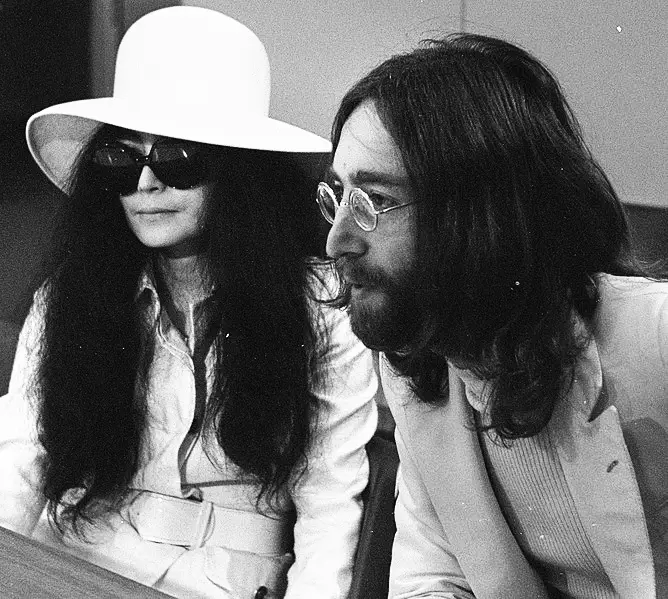
Yoko Ono and Lennon in March 1969 (Wiki Image).
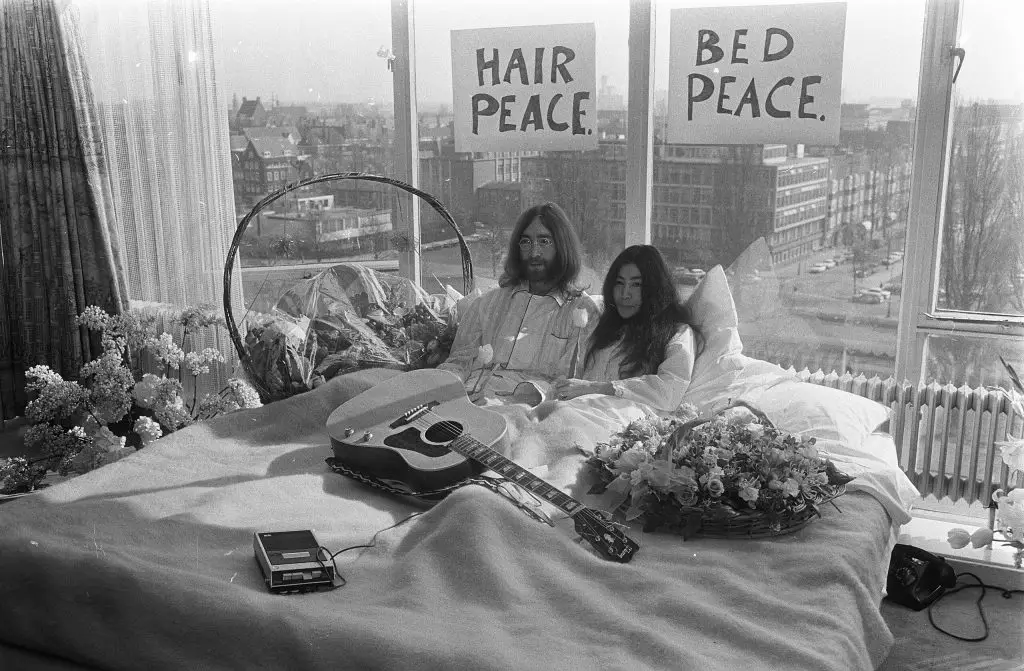
John Lennon and Yoko Ono on the first day of their Amsterdam bed-in (Wiki Image).
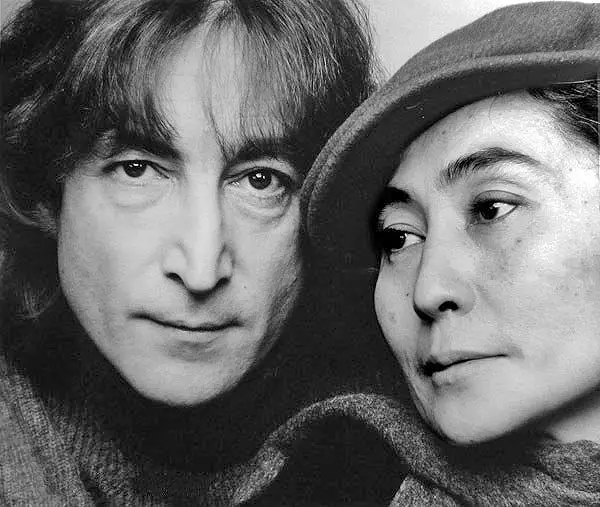
Lennon and Ono in 1980 by Jack Mitchell (Wiki Image).
John Lennon and Yoko Ono’s relationship was a powerful blend of love, art, and activism that captivated the world. Their often controversial yet undeniably strong connection fueled their creative endeavors and impacted music and culture. Here are ten quotes that offer a glimpse into their unique bond:
From John Lennon:
- “When I met Yoko, I thought I was in love, but it was beyond love. It was something more. It was like I’d been asleep, and she woke me up.” – This reveals the transformative power of their connection, awakening new depths within him.
- “Yoko is the greatest woman artist in the world.” – John championed Yoko’s artistic talent and vision, recognizing her as a groundbreaking artist in her own right.
- “We were a couple that faced the world together. We were two halves of the same soul.” – This emphasizes their unity and shared purpose, facing challenges and creating art as a united front.
- “Our love wasn’t just romantic love. It was a spiritual connection, a meeting of minds and souls.” – Their bond transcended the physical, encompassing a deep intellectual and spiritual connection.
- “She gave me the courage to be myself, to express my true feelings and beliefs.” – Yoko’s influence empowered John to embrace his individuality and pursue his artistic and activist passions.
From Yoko Ono:
- “I knew that we were meant to be together, that we had a mission to accomplish in the world.” – Yoko recognized their shared destiny and the potential to create positive change through their combined efforts.
- “Our love was a revolution, a challenge to the conventional norms of society.” – Their unconventional relationship defied expectations and became a symbol of love and peace.
- “John was my soulmate, my partner in everything. We were inseparable.” – This highlights the profound connection they shared, a bond that extended beyond romance to encompass all aspects of their lives.
Together:
- “We were two artists who came together to create something new and beautiful.” – Their collaborative artistic endeavors, including music, performance art, and activism, reflected their shared creative vision.
- “Our love was a force for peace, a message of hope and unity for the world.” – Their commitment to peace activism, exemplified in their “Bed-Ins for Peace” and other protests, showcased their belief in the power of love to inspire change.
| Year | Age (Ono) | Age (Lennon) | Event | Significance |
|---|---|---|---|---|
| 1966 | 33 | 26 | Meet at an art gallery in London | Lennon, already a global star with the Beatles, is intrigued by Ono’s avant-garde art and strong personality. |
| 1968 | 35 | 28 | Begin their relationship | Despite both being married to others, they embark on a passionate affair that would change their lives. |
| 1969 | 36 | 29 | Marry in Gibraltar | Their wedding becomes a media sensation, and they use their honeymoon as a “Bed-In” for peace. |
| 1969-1970 | 36-37 | 29-30 | Collaborate on music and art projects | They release experimental albums and engage in performance art, often blurring the lines between their personal and creative lives. |
| 1970 | 37 | 30 | The Beatles disband | Ono is often blamed for the band’s breakup, facing intense criticism and public scrutiny. |
| 1971 | 38 | 31 | Move to New York City | They seek a fresh start and become involved in political activism and the anti-war movement. |
| 1973 | 40 | 33 | Temporary separation (“Lost Weekend”) | They separate for 18 months, a period marked by personal struggles and creative exploration for both. |
| 1975 | 42 | 35 | Reconcile and welcome their son, Sean | They reunite, and Ono gives birth to their only child together. |
| 1975-1980 | 42-47 | 35-40 | Focus on family life and creative pursuits | Lennon takes a break from music to focus on raising Sean, while Ono continues her artistic endeavors. |
| 1980 | 47 | 40 | Lennon is murdered in New York City | A tragic end to their partnership that shocks the world and leaves a lasting impact on Ono and their son. |
| 1980-present | 47-present | – | Ono continues to champion Lennon’s legacy and her own artistic career | She manages his estate, releases his unreleased music, and remains a prominent artist and peace activist. |
The Beatles – The Ballad Of John And Yoko
The Truth About John Lennon And Yoko Ono’s Relationship
WE’RE ALL WATER by Yoko Ono
(YouTube video)
Yoko Ono and John Lennon are renowned figures in music and art, and their love story symbolizes creativity, activism, and profound emotional connection. Their relationship began in the mid-1960s when both were influential in their respective fields. John Lennon, a member of the iconic Beatles, was at the height of his fame. Yoko Ono was emerging as a pioneering artist known for her avant-garde work and experimental performances. Their paths crossed in November 1966 at an art exhibition in London. Lennon was immediately drawn to Ono’s bold and unconventional approach to art, setting the stage for a partnership that would captivate the world.
Lennon and Ono’s initial meeting sparked a deep intellectual and emotional connection that transcended the typical boundaries of celebrity romance. They shared a passion for art, music, and activism, which fostered a unique bond rooted in mutual respect and admiration. As they began to collaborate creatively, their relationship evolved from a romantic partnership into a profound artistic collaboration. The couple’s works often reflected their shared ideals, blending music and visual art to challenge societal norms and promote peace, love, and social justice.
In 1969, Lennon and Ono made headlines when they staged their infamous “Bed-In for Peace” in Amsterdam, a non-violent protest against the Vietnam War. The couple’s decision to hold a press conference while lying in bed was a striking statement that garnered worldwide attention. They invited journalists to discuss peace and love, using celebrity status to draw attention to the anti-war movement. This unconventional protest showcased their commitment to activism and belief in love as a powerful force for change. The Bed-In symbolized their love and shared vision for a more peaceful world.
Lennon and Ono faced significant criticism from the public and the media as their relationship deepened. Many Beatles fans were disillusioned by Lennon’s close association with Ono, believing she was a disruptive influence on the band. The intense scrutiny of their relationship often overshadowed their artistic achievements, leading to tension in their personal lives and Lennon’s career. Despite this adversity, the couple remained committed to each other and continued to produce groundbreaking work that reflected their ideals and experiences.
In 1970, after the breakup of the Beatles, Lennon and Ono released their collaborative album, Plastic Ono Band. The album, known for its raw emotional intensity and candid exploration of personal and political themes, showcased their creative synergy and expressed their love. The title track, “Mother,” and the song “Give Peace a Chance,” became anthems for the peace movement, resonating with audiences around the globe. Their partnership was not only romantic but also a driving force behind their artistic expression, as they sought to inspire change through their work.
Lennon and Ono’s love story took a tragic turn on December 8, 1980, when Lennon was shot and killed outside their apartment in New York City. His death sent shockwaves around the world, leaving Ono heartbroken and grappling with the loss of her partner and collaborator. In the wake of this tragedy, she became a vocal advocate for peace and social justice, continuing to honor Lennon’s legacy through her activism and art. Ono’s resilience in the face of unimaginable loss demonstrated the strength of her love for Lennon and her commitment to their shared ideals.
In the following years, Ono worked tirelessly to keep Lennon’s spirit alive, dedicating herself to charitable causes and promoting peace through her art. She often spoke of their love as a guiding force in her life, expressing gratitude for their time together. Ono’s artistic endeavors, including music, performance art, and exhibitions, reflected her dedication to their shared vision while exploring grief, healing, and hope themes. Her work is a testament to their relationship’s enduring impact and profound influence on her life and art.
Today, Yoko Ono and John Lennon are remembered not only for their contributions to music and art but also for their powerful love story that transcended the boundaries of fame and societal expectations. Their relationship exemplifies the intersection of love and activism, illustrating how personal connections can inspire collective change. As cultural icons, their legacy continues to resonate with those who seek to embrace the ideals of peace, love, and creativity. The story of Yoko Ono and John Lennon remains a poignant reminder of the transformative power of love and its lasting impact on individuals and society.
Wallis Simpson and Edward VIII Lovers (America/England)
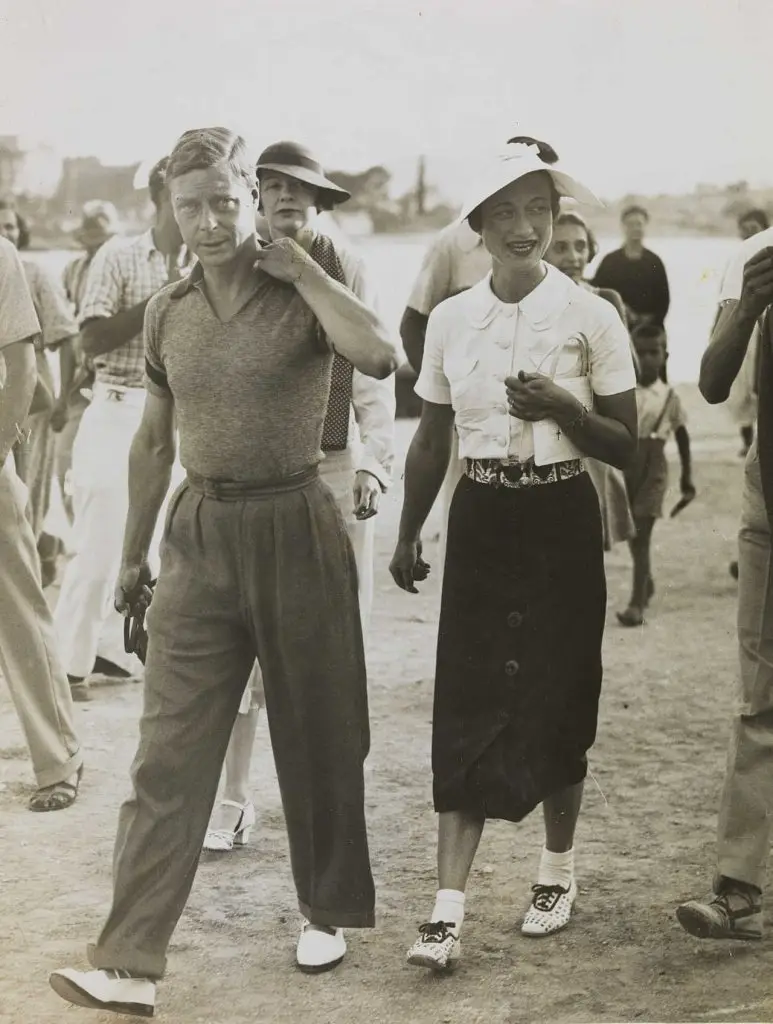
Edward VIII and Wallis Simpson were on holiday in Yugoslavia in 1936 (Wiki Image).

Wallis and Edward with Adolf Hitler, 1937 (Wiki Image).
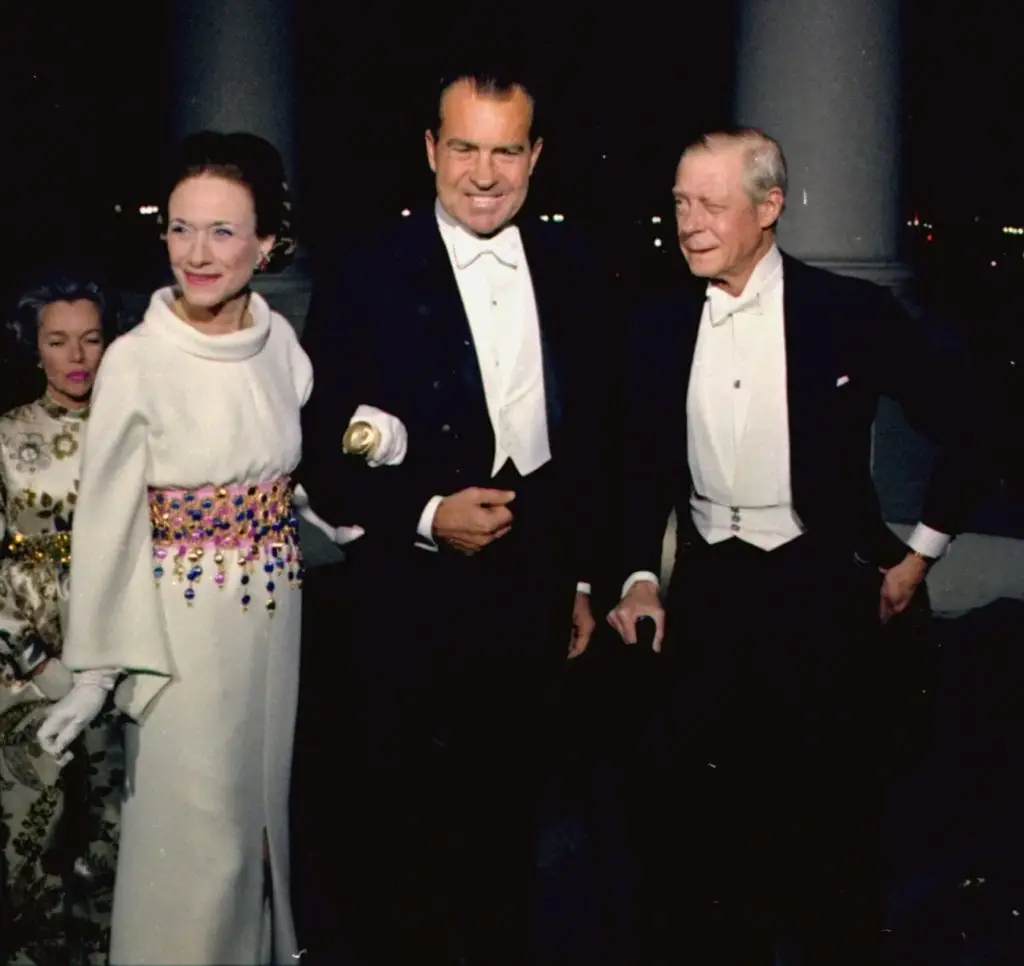
Wallis and Edward were at the White House for dinner with President Richard Nixon in 1970 (Wiki Image).
You’re interested in the controversial romance that shook the British monarchy! Wallis Simpson and Edward VIII’s relationship was a whirlwind of passion and defiance, ultimately leading to his abdication. Here are ten quotes that offer a glimpse into their controversial love story:
From Wallis Simpson:
- “I am sure there is only one solution, that is for me to remove myself from the King’s life. That is what I am doing now.” – This quote reveals Wallis’s initial attempt to distance herself from Edward, recognizing the potential consequences of their relationship.
- “You can never be too rich or too thin.” – This often-quoted remark, though its attribution to Wallis is debated, reflects her glamorous lifestyle and social aspirations.
- “I’m afraid I’m not the kind of woman the British Empire wants for its Queen.” – Wallis acknowledged the societal barriers and disapproval surrounding their relationship.
- “Don’t worry, it will all work out in the end.” – Wallis maintained a sense of optimism and hope for their future together despite the mounting pressure and opposition.
From Edward VIII:
- “I have found it impossible to carry the heavy burden of responsibility and to discharge my duties as King as I would wish to do without the help and support of the woman I love.” – This declaration from Edward’s abdication speech expresses his deep love for Wallis and his inability to rule without her by his side.
- “The only happiness I can find now is in marrying Mrs. Simpson, and I am determined to do it.” – Edward’s unwavering commitment to Wallis, despite the potential consequences, is evident in this resolute statement.
- “I am not a marrying man, but I am very much in love.” – This quote reveals Edward’s initial reluctance towards marriage, highlighting the transformative power of his love for Wallis.
Together:
- “We are not living a fairy tale. We are living a love story.” – This statement emphasizes the reality of their relationship despite the media frenzy and public scrutiny surrounding it.
- “Our love was stronger than any crown.” – This sentiment reflects their willingness to sacrifice everything, including Edward’s throne, for the sake of their love.
- “We were two souls who found each other in a world that tried to keep us apart.” – This quote captures the sense of defiance and determination that characterized their relationship in the face of societal disapproval.
| Year | Age (Wallis) | Age (Edward) | Event | Significance |
|---|---|---|---|---|
| 1931 | 35 | 37 | Introduced through mutual friends | Wallis, an American socialite already married to her second husband, meets Edward, Prince of Wales, at a social gathering. |
| 1934 | 38 | 40 | Become close friends | Their friendship deepens as Wallis and her husband become part of Edward’s social circle. |
| 1934-1935 | 38-39 | 40-41 | Relationship intensifies | Wallis reportedly becomes Edward’s mistress while still married. |
| 1936 | 40 | 42 | Edward becomes King | Upon the death of his father, George V, Edward ascends to the throne as King Edward VIII. |
| 1936 | 40 | 42 | Wallis divorces her second husband | As Edward’s attachment to Wallis grows, she initiates divorce proceedings with Ernest Simpson. |
| 1936 | 40 | 42 | Edward proposes marriage to Wallis | Edward’s intention to marry a twice-divorced American woman causes a constitutional crisis. |
| 1936 | 40 | 42 | Edward abdicates the throne | Facing immense pressure from the government and the Church of England, Edward chooses love over duty and abdicates. |
| 1937 | 41 | 43 | Edward is created Duke of Windsor | His brother, George VI, grants him the title of Duke of Windsor. |
| 1937 | 41 | 43 | Wallis and Edward marry in France | They married in a private ceremony, with no members of the British royal family present. |
| 1937-1972 | 41-76 | 43-78 | Life as the Duke and Duchess of Windsor | They live a life of exile and travel, socializing with high society but remaining somewhat ostracized from the British royal family. |
| 1972 | 76 | 78 | Edward dies | Wallis lives another 14 years as a widow. |
| 1986 | 90 | – | Wallis dies | She is buried alongside Edward near Windsor Castle. |
1936: The Abdication (2024) | Full Documentary | Prince Edward
The Story Of Wallis Simpson: Scheming Seductress Or …
Wallis Simpson – The Queen of a King’s Heart Documentary
(YouTube Video)
Wallis Simpson and Edward VIII’s love story is one of the most infamous romances in modern history, as it led to the only voluntary abdication of the British throne. Their relationship was marked by scandal, defiance of tradition, and a devotion that would alter the course of the British monarchy forever. Wallis, an American socialite, and Edward, the Prince of Wales and later King Edward VIII, met in the early 1930s at a party. Despite Wallis being married at the time, Edward quickly became infatuated with her, setting the stage for a romance that would shake the foundations of the British royal family.
Edward, known for his charm and modern outlook, had always resisted the constraints of royal life. He found in Wallis someone who shared his independent spirit and disdain for the rigid formalities of the British court. As their relationship grew, Wallis became the most critical person in Edward’s life, and he sought her companionship and advice on many matters. Their bond was romantic and emotional, with Wallis providing Edward with a sense of comfort and understanding that he had longed for within the constraints of his royal duties.
However, their relationship was fraught with complications from the outset. Wallis had been married twice, and her status as a twice-divorced American was considered wholly unsuitable for a future queen consort by the British establishment and the Church of England. In 1936, when Edward ascended the throne after his father’s death, King George V’s desire to marry Wallis posed a constitutional crisis. The British government, led by Prime Minister Stanley Baldwin, opposed the union, as did the Church, which forbade the remarriage of divorced persons while their former spouses were still alive.
With the impossible choice between the woman he loved and the crown, Edward chose Wallis. On December 10, 1936, he became the first British monarch to voluntarily abdicate the throne, declaring in his famous broadcast, “I have found it impossible to carry the heavy burden of responsibility and to discharge my duties as king as I would wish to do without the help and support of the woman I love.” His younger brother, George VI, assumed the throne, and Edward became the Duke of Windsor. Wallis and Edward’s love had effectively reshaped the monarchy, thrusting the couple into a new life in exile.
After the abdication, Edward and Wallis married on June 3, 1937, at a private ceremony in France, with no members of the British royal family in attendance. The couple spent much of their lives living abroad, in France and the United States, ostracized mainly from the royal family and British society. Although they were financially supported by the royal family and maintained a lavish lifestyle, they faced social rejection from the highest echelons of the British aristocracy. Wallis, in particular, was never entirely accepted by the British public, who viewed her as the woman responsible for the king’s abdication.
Despite their hardships, Wallis and Edward remained deeply devoted to each other. Their marriage was characterized by mutual loyalty as they navigated the complexities of life as exiled royalty. The Duke often referred to Wallis as “the perfect woman,” he seemed to thrive in her company, far removed from the pressures of kingship. Their shared love of travel, fashion, and socializing allowed them to carve out a glamorous life in the high society circles of Paris, New York, and the Riviera, even as they were viewed with suspicion back in Britain.
During World War II, the couple again found themselves at the center of controversy. Edward was appointed governor of the Bahamas, partly to remove them from Europe amid rumors of Nazi sympathies. While the allegations of collaboration were never proven, the couple’s wartime behavior—marked by Edward’s ambivalence toward the war and Wallis’s extravagant lifestyle—further alienated them from British society. Nevertheless, their love endured, with Wallis continuing to stand by Edward through the ups and downs of their unconventional life.
Edward’s health began to decline in the 1960s, and Wallis devoted herself to caring for him during his final years. When he died in 1972, Wallis was heartbroken, but she continued to live in their Parisian home until her health deteriorated. In her later years, Wallis became more reclusive, suffering from dementia and fading from the public eye. When she passed away in 1986, she was laid to rest next to Edward at the Royal Burial Ground at Frogmore, finally brought back into the royal fold in death despite the years of estrangement.
The love story of Wallis Simpson and Edward VIII remains one of British history’s most compelling and controversial romances. Their relationship defied the expectations of royalty and led to seismic changes in the monarchy, demonstrating the lengths to which one man would go for love. Although Wallis was vilified in her lifetime, the Duke and Duchess of Windsor’s bond endured for decades. It stood as a testament to their devotion to each other despite overwhelming opposition and personal sacrifice.
Here are the similarities between the 15 famous couples across different periods, focusing on common themes in their relationships, personal dynamics, and historical legacies:
- Influence on Political and Social Structures:
- Several of these couples were involved in shaping political landscapes. Cleopatra VII with Julius Caesar and Mark Antony, Anne Boleyn with Henry VIII, Josephine and Napoleon, Isabella I and Ferdinand II, and Eva Perón and Juan Perón were deeply entwined with significant political shifts. Their relationships influenced state affairs, military strategies, and even the fates of empires and nations.
- Power Couples:
- These lovers were often seen as power couples, and their personal relationships enhanced their public or political influence. Examples include Cleopatra and Julius Caesar/Mark Antony, Isabella and Ferdinand, Eva and Juan Perón, and Queen Victoria and Prince Albert, all combined personal affection with mutual political or social ambitions.
- Creative Partnerships:
- Several couples were connected through their shared intellectual or artistic endeavors. Simone de Beauvoir and Jean-Paul Sartre, Frida Kahlo and Diego Rivera, Elizabeth Barrett Browning and Robert Browning, Gertrude Stein and Alice B. Toklas, and Yoko Ono and John Lennon were all artists, writers, or thinkers whose work was enriched by their relationships.
- Defiance of Societal Norms:
- Many of these couples broke the societal or religious conventions of their time. Heloise and Peter Abelard defied religious celibacy, Anne Boleyn and Henry VIII caused a schism in the church, and Wallis Simpson and Edward VIII led to Edward’s abdication of the throne. Similarly, Yoko Ono and John Lennon were known for their unconventional public displays of love and activism.
- Enduring Legacies:
- The legacies of these couples have endured beyond their lifetimes. The Taj Mahal built by Shah Jahan for Mumtaz Mahal, the poetry of Elizabeth and Robert Browning, and the lasting fame of Eva Perón (“Evita”) are examples where love and history intertwined to create enduring cultural or historical symbols.
- Public Scrutiny and Controversy:
- Almost all of these relationships were subject to public scrutiny or controversy. From Cleopatra’s alliances with Roman leaders to Simone de Beauvoir and Jean-Paul Sartre’s open relationship, and from Frida Kahlo and Diego Rivera’s tumultuous marriage to the scandal of Wallis Simpson and Edward VIII, their private lives became a public spectacle, often met with either fascination or scandal.
- Personal and Professional Balance:
- Many of these couples’ relationships were intertwined with their professional or public lives. Frida Kahlo and Diego Rivera balanced love and rivalry in their art, while Gertrude Stein and Alice B. Toklas were companions and collaborators in literature. Simone de Beauvoir and Sartre similarly shared philosophical and intellectual pursuits.
- Tragic Elements:
- These relationships were marked by tragedy, whether through death or personal sacrifice. Yang Guifei and Emperor Xuanzong’s romance led to political upheaval and her eventual execution, while Mumtaz Mahal’s death led to Shah Jahan’s creation of the Taj Mahal. Heloise and Abelard suffered the pain of forced separation, and Anne Boleyn’s marriage to Henry VIII ended with her execution.
These similarities showcase how love, power, creativity, and tragedy often go hand in hand, crossing boundaries of time, geography, and culture. Despite the diversity in their backgrounds, these couples shared common threads of influence, passion, and legacy.
Here’s a breakdown of some key differences between these 15 famous pairings, highlighting their unique dynamics and contexts:
Power Dynamics:
- Cleopatra & Caesar/Antony: Cleopatra, a powerful queen in her own right, used her relationships with Roman leaders for political advantage.
- Anne Boleyn & Henry VIII: Though initially a subject, Anne gained significant influence as queen but ultimately fell victim to the king’s volatile nature.
- Josephine & Napoleon: Josephine initially held more social standing, but Napoleon’s rise to power shifted the dynamics, ultimately leading to their divorce.
- Queen Victoria & Prince Albert: While Victoria was the monarch, Albert gained significant influence as her advisor and consort, demonstrating a more balanced partnership.
- Isabella & Ferdinand: This royal couple ruled as equals, and their partnership was crucial for the unification of Spain.
- Eva Perón & Juan Perón: Though not officially in power, Eva had immense influence through her charisma and connection with the people.
Nature of Love:
- Heloise & Abelard: A passionate but forbidden love affair marked by intellectual connection and tragic consequences.
- Romeo & Juliet: A classic tale of young love defying societal barriers, ending in tragedy.
- Shah Jahan & Mumtaz Mahal: A deep and devoted love immortalized in the Taj Mahal, a monument to grief and remembrance.
- Elizabeth & Robert Browning: A passionate and supportive relationship between two poets, defying societal norms and fueling their creative endeavors.
Social & Cultural Context:
- Yang Guifei & Emperor Xuanzong: Their relationship reflected the opulence and artistic flourishing of the Tang Dynasty, but also contributed to political instability.
- Gertrude Stein & Alice B. Toklas: A pioneering same-sex relationship in the early 20th century, challenging societal norms and fostering a vibrant artistic community.
- Yoko Ono & John Lennon: A highly publicized and controversial relationship that blended art, music, and activism, reflecting the counter-cultural movements of the 1960s and 70s.
- Wallis Simpson & Edward VIII: Their scandalous affair led to a constitutional crisis and Edward’s abdication, highlighting the clash between love and duty.
Challenges and Obstacles:
- Cleopatra & Antony: Faced political opposition and ultimately war against Rome.
- Heloise & Abelard: Forbidden love due to religious vows and societal constraints.
- Anne Boleyn & Henry VIII: Religious and political turmoil, ending in Anne’s execution.
- Josephine & Napoleon: Inability to produce an heir, leading to divorce.
- Frida Kahlo & Diego Rivera: Infidelity, political differences, and health issues.
Legacy and Impact:
- Cleopatra & Antony: A legendary love story with lasting impact on art and literature.
- Shah Jahan & Mumtaz Mahal: The Taj Mahal is a testament to their love and architectural grandeur.
- Queen Victoria & Prince Albert: Their influence on Victorian society and culture was profound.
- Simone de Beauvoir & Jean-Paul Sartre: Their philosophical and literary works continue to shape feminist and existentialist thought.
- Yoko Ono & John Lennon: Their artistic collaborations and peace activism left a lasting legacy.
These are just a few of the many differences between these famous lovers. Though their stories are diverse in their contexts and outcomes, they all speak to the complexities of love, ambition, and the human experience.
Here is a comparison table of 15 famous lovers across history, highlighting their periods, relationship dynamics, and significant contributions to history, culture, or politics:
| Lovers | Period | Relationship Dynamics | Contributions and Legacy |
| Cleopatra VII & Julius Caesar/Mark Antony | 1st Century BCE | Political alliances intertwined with romance, Cleopatra with two powerful Roman figures. | Cleopatra’s relationships shaped the Roman-Egyptian power balance. |
| Heloise & Peter Abelard | 12th Century CE | It is a tragic love story of forbidden romance, intellectual partnership, and forced separation. | Their letters highlight medieval views on love, religion, and philosophy. |
| Anne Boleyn & Henry VIII | 16th Century CE | Passionate and politically charged relationship that led to England’s break from the Catholic Church. | Anne’s marriage to Henry influenced the English Reformation. |
| Joséphine & Napoleon Bonaparte | Late 18th-Early 19th Century | Passionate but complicated marriage, marked by ambition, infidelity, and eventual divorce. | Joséphine was Napoleon’s muse, but their marriage ended for political reasons. |
| Simone de Beauvoir & Jean-Paul Sartre | 20th Century CE | Intellectual partnership, free relationship with non-monogamous ideals. | Influential in existentialism, feminism, and modern philosophy. |
| Queen Victoria & Prince Albert | 19th Century CE | Deeply loving and mutually supportive relationship, mourning after Albert’s death defined Victoria’s later reign. | Their partnership shaped the British monarchy and Victorian values. |
| Frida Kahlo & Diego Rivera | 20th Century CE | Passionate, tumultuous relationship with mutual respect for each other’s art and politics. | Their art and political activism shaped Mexican cultural identity. |
| Isabella I of Castile & Ferdinand II of Aragon | 15th Century CE | Strategic marriage that unified Spain and helped to solidify its power in Europe. | Their reign led to the Spanish Inquisition and the discovery of the New World. |
| Eva Perón & Juan Perón | 20th Century CE | Political partnership; Eva played a key role in Juan Perón’s rise and the Argentine social movement. | Eva remains a beloved figure for her championing of the poor. |
| Elizabeth Barrett Browning & Robert Browning | 19th Century CE | Romantic and supportive relationship despite familial opposition, with both poets inspiring each other’s work. | Their poetry became foundational in Victorian literature and beyond. |
| Yang Guifei & Emperor Xuanzong | 8th Century CE | One of China’s most famous romantic legends; their love is said to have contributed to political unrest. | Their romance is immortalized in Chinese literature and art. |
| Mumtaz Mahal & Shah Jahan | 17th Century CE | Deeply loving relationship, with Mumtaz’s death leading to the construction of the Taj Mahal. | The Taj Mahal stands as a symbol of eternal love and Mughal architecture. |
| Gertrude Stein & Alice B. Toklas | 20th Century CE | Lifelong companionship, with Stein’s influence on the avant-garde and Toklas as her partner and editor. | Their relationship shaped Parisian modernism and the expatriate community. |
| Yoko Ono & John Lennon | 20th Century CE | Art and activism-driven partnership, often controversial but undeniably influential. | Their relationship influenced 1960s counterculture and peace activism. |
| Wallis Simpson & Edward VIII | 20th Century CE | Scandalous love affair that led Edward to abdicate the British throne. | Their marriage forever changed the British monarchy’s trajectory. |
Each couple in this table represents not only a romantic connection but also a powerful impact on their respective societies and eras, intertwining love with politics, art, and social change.

